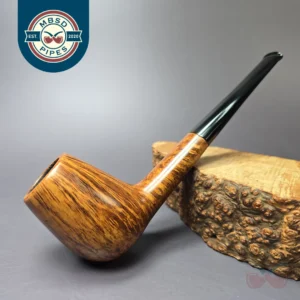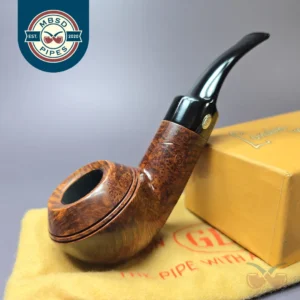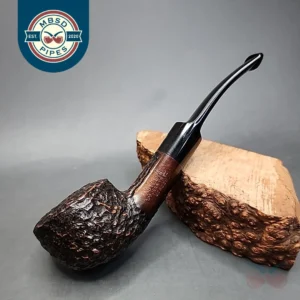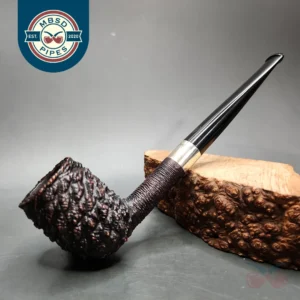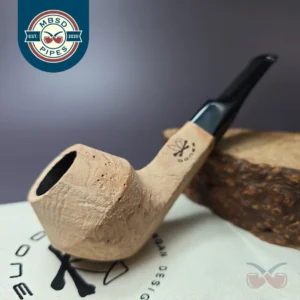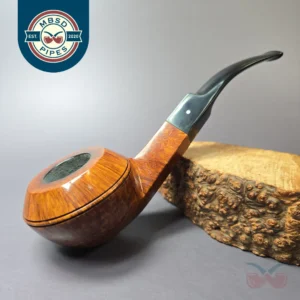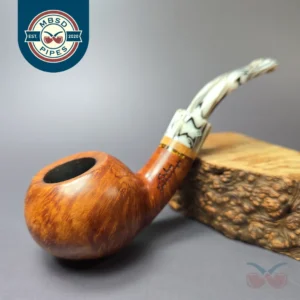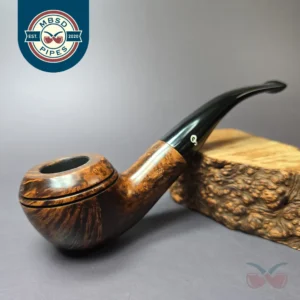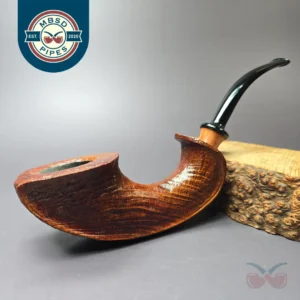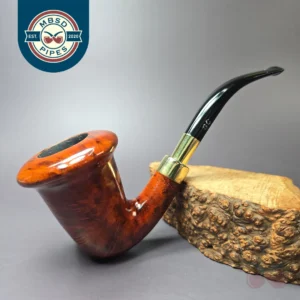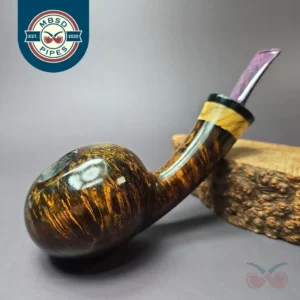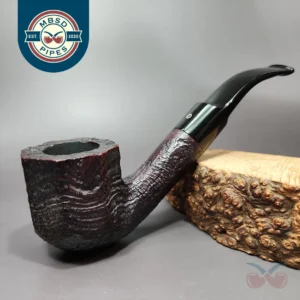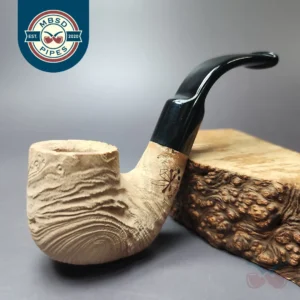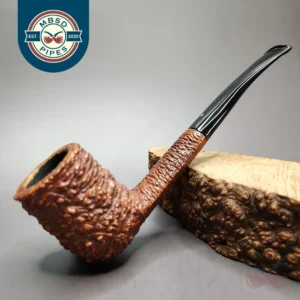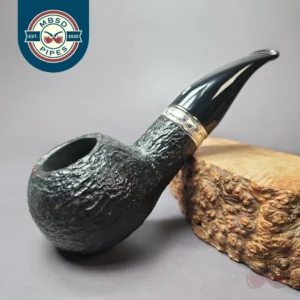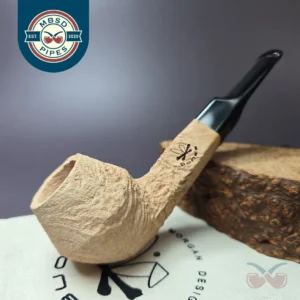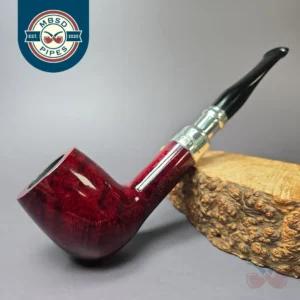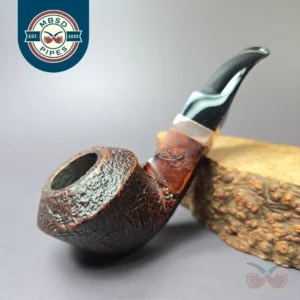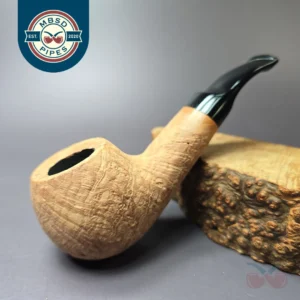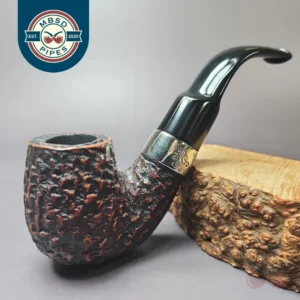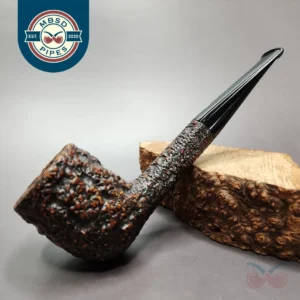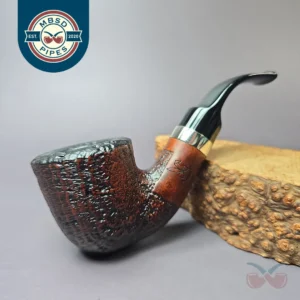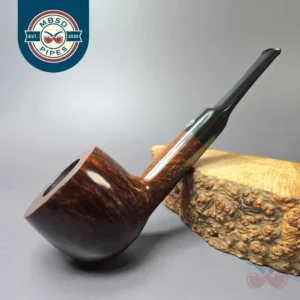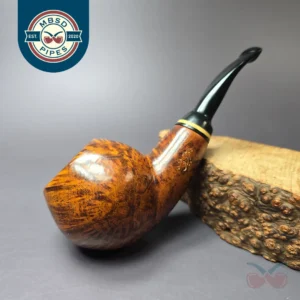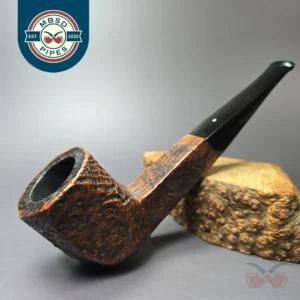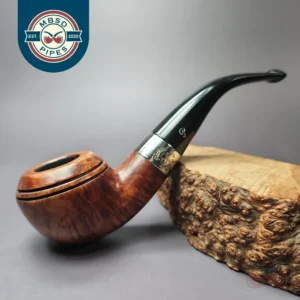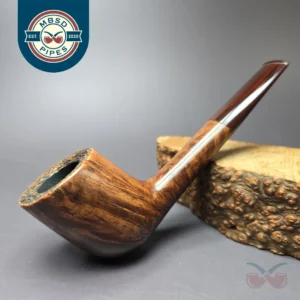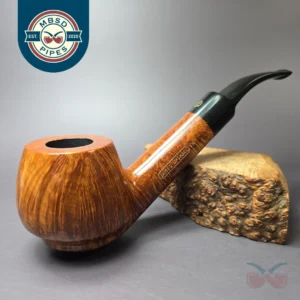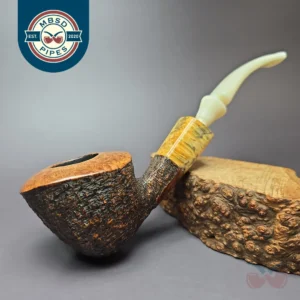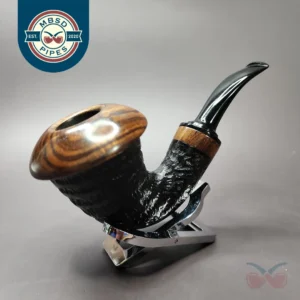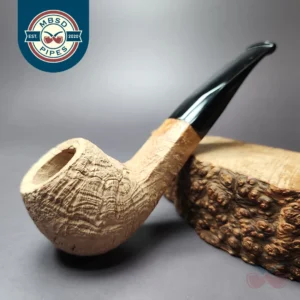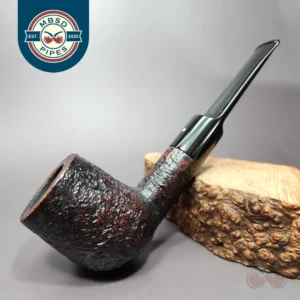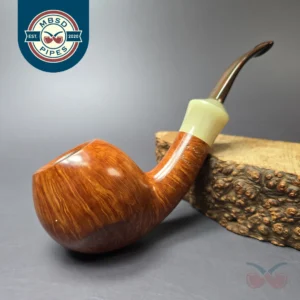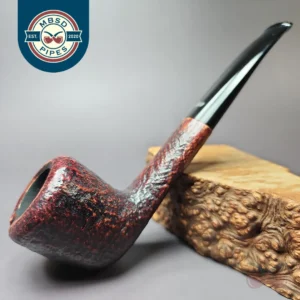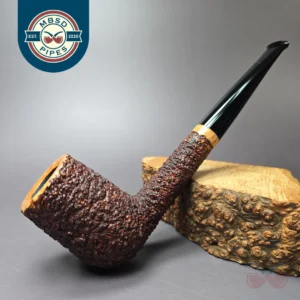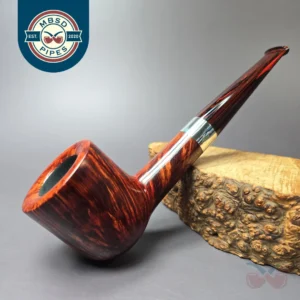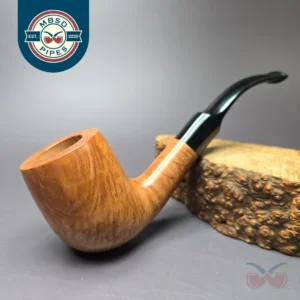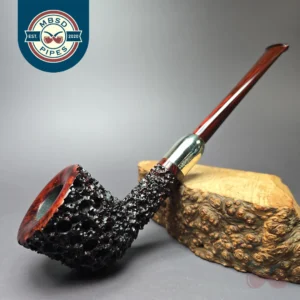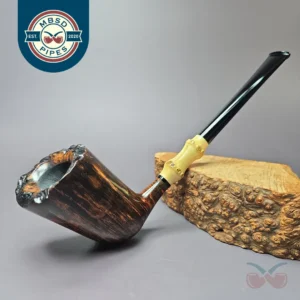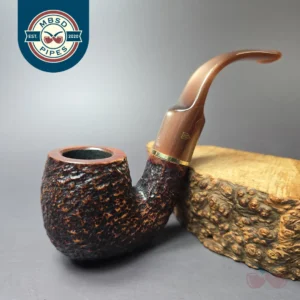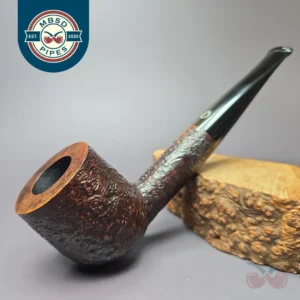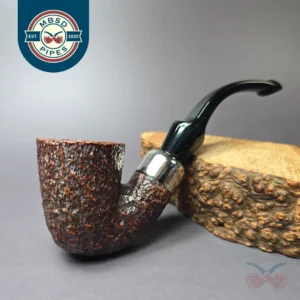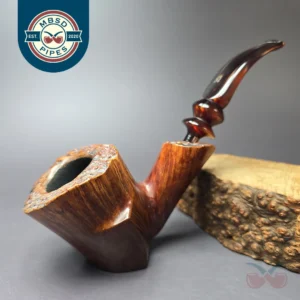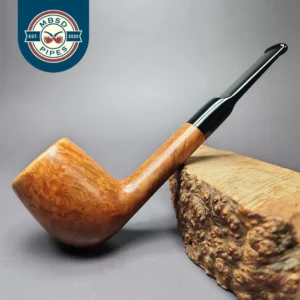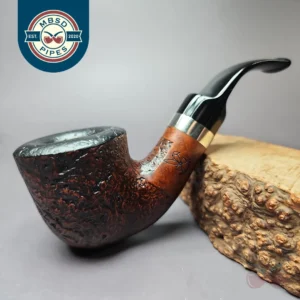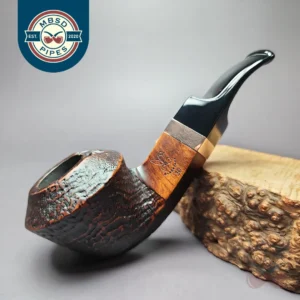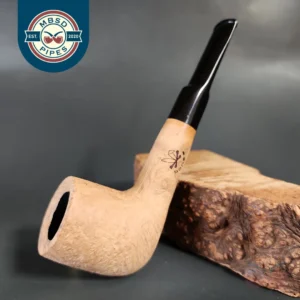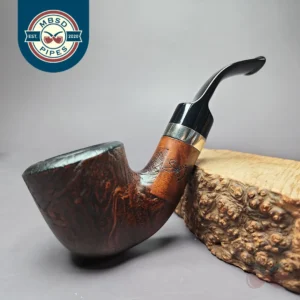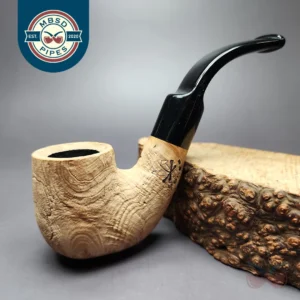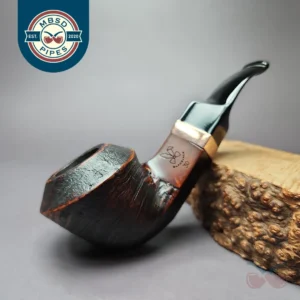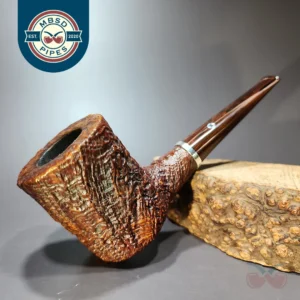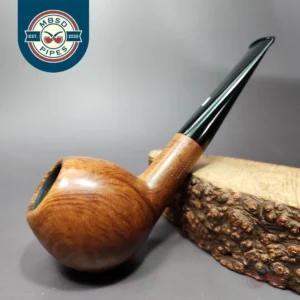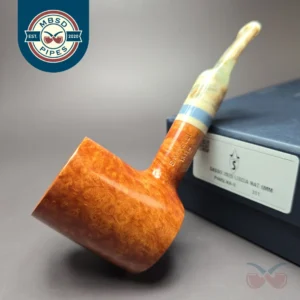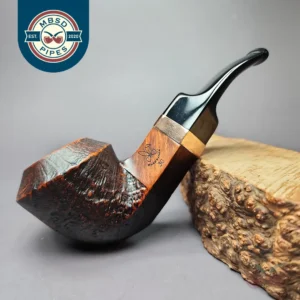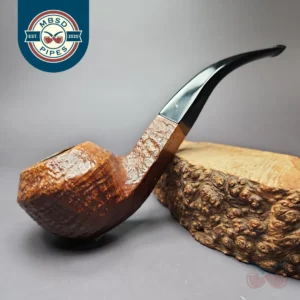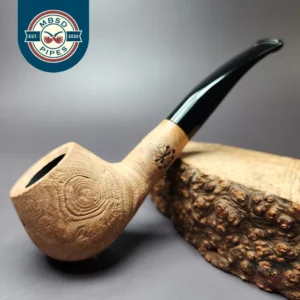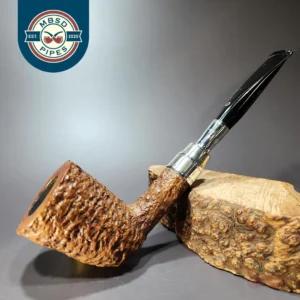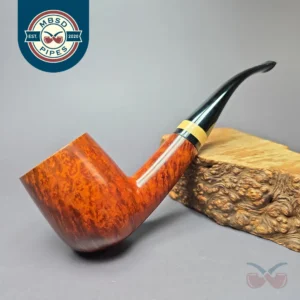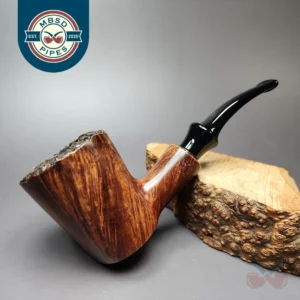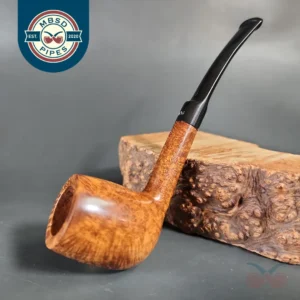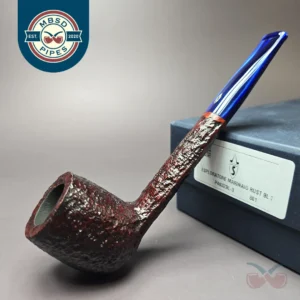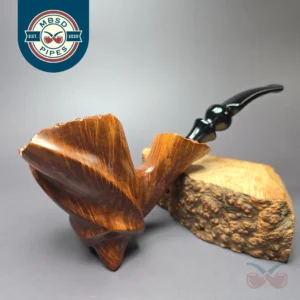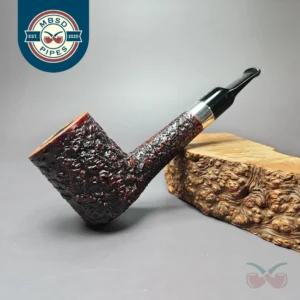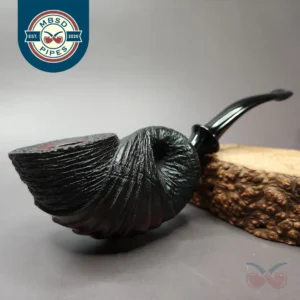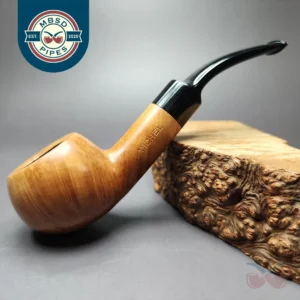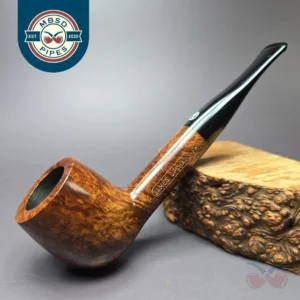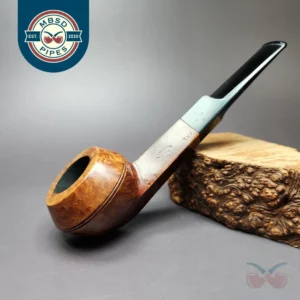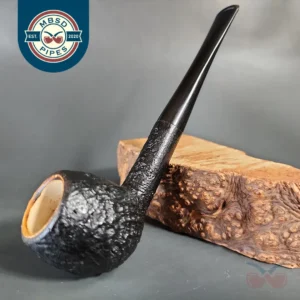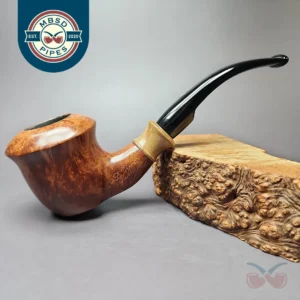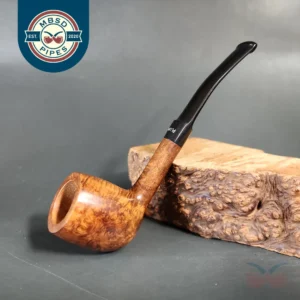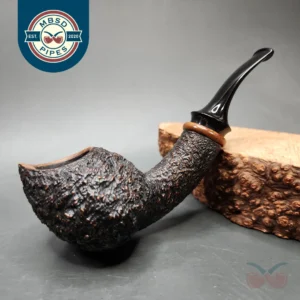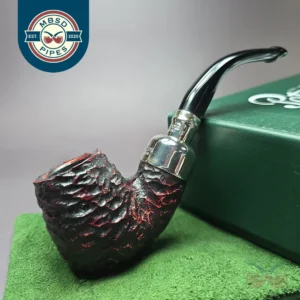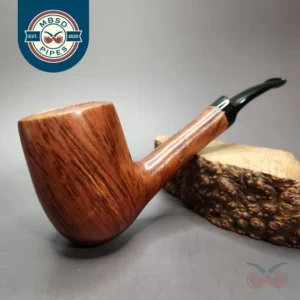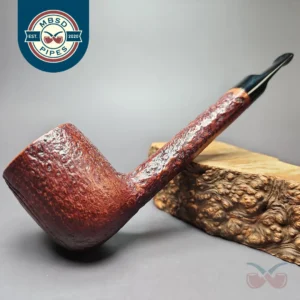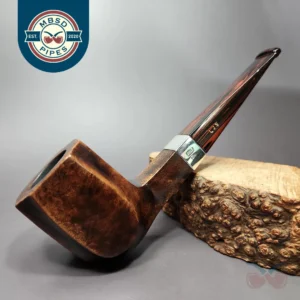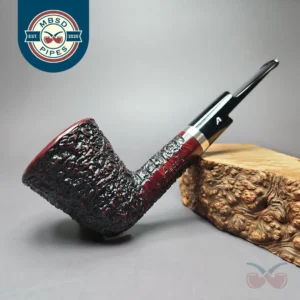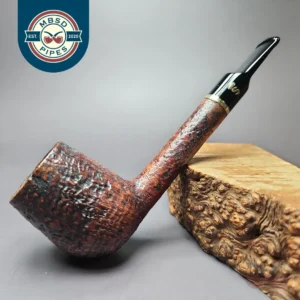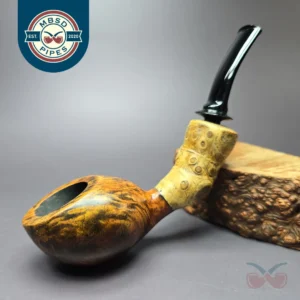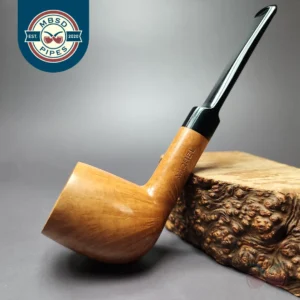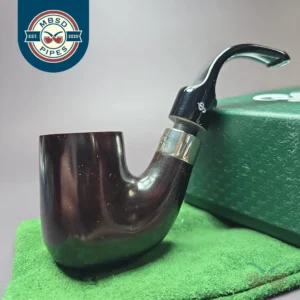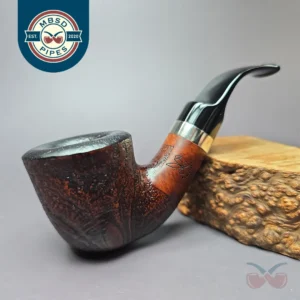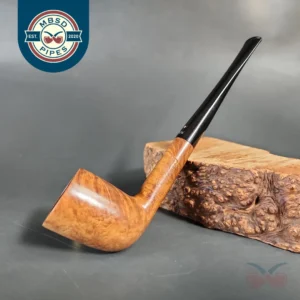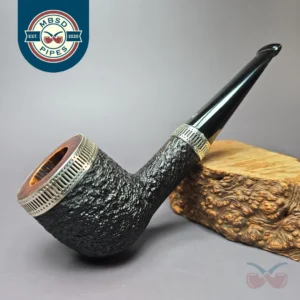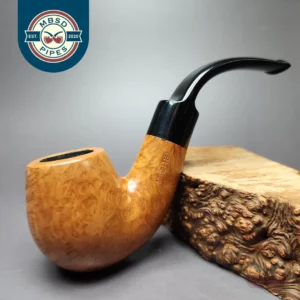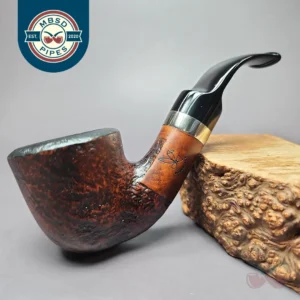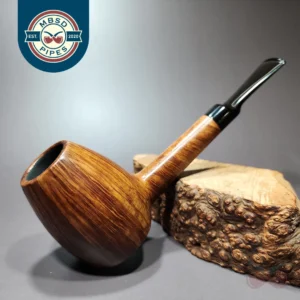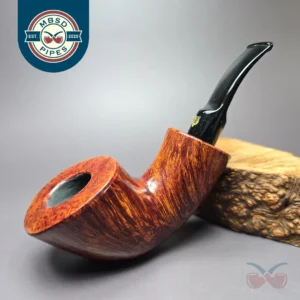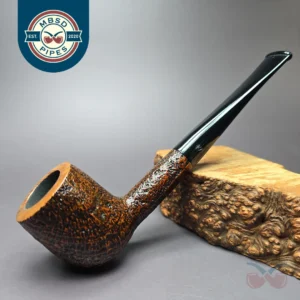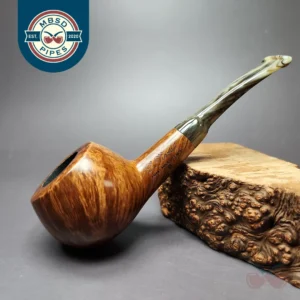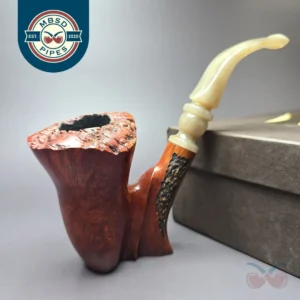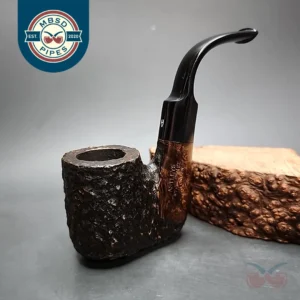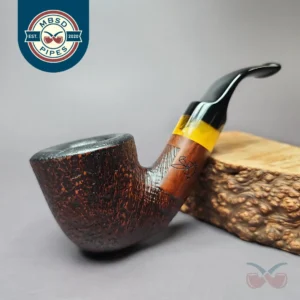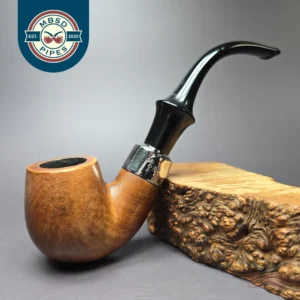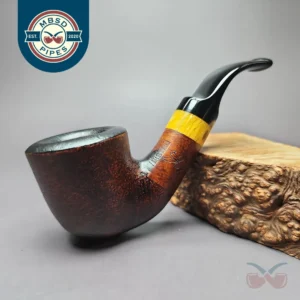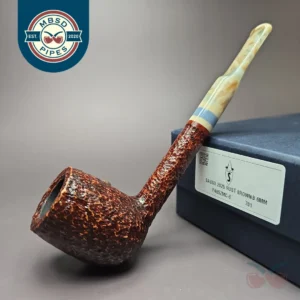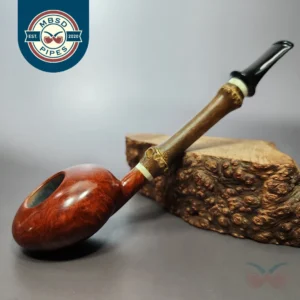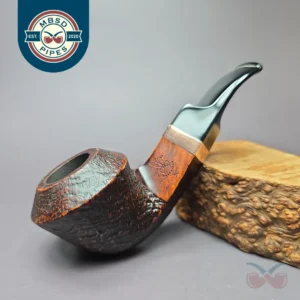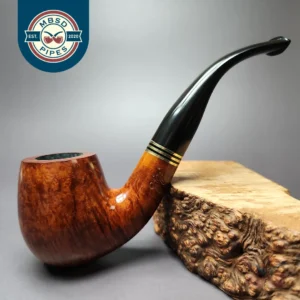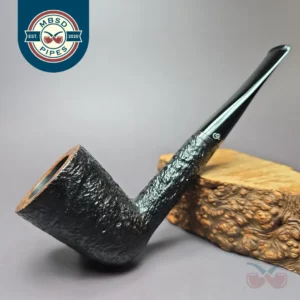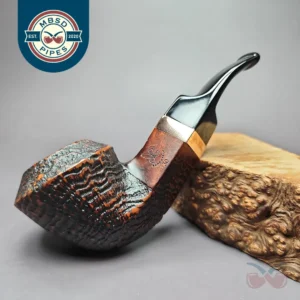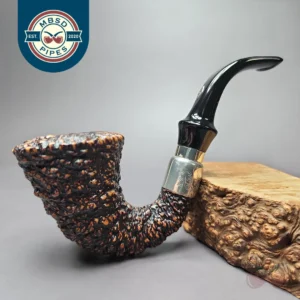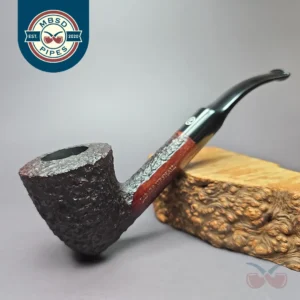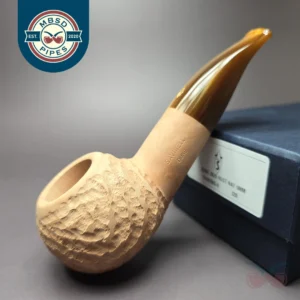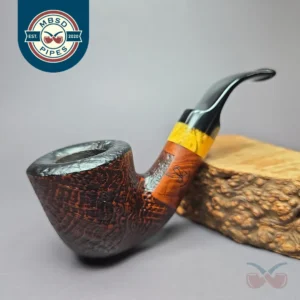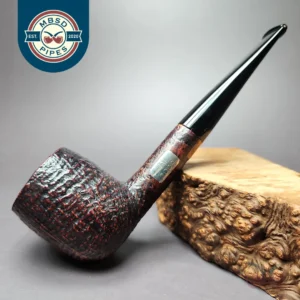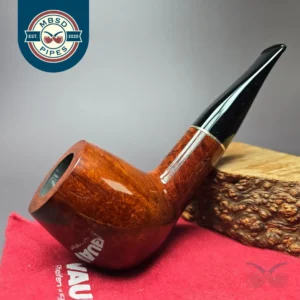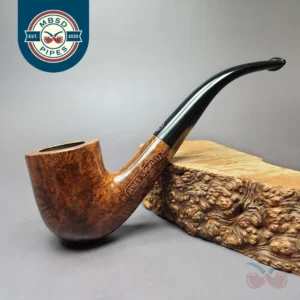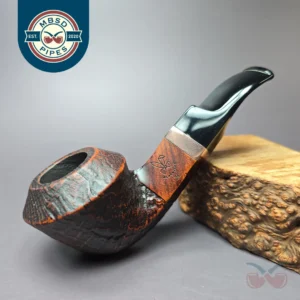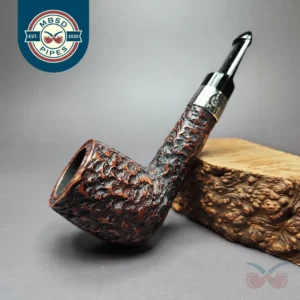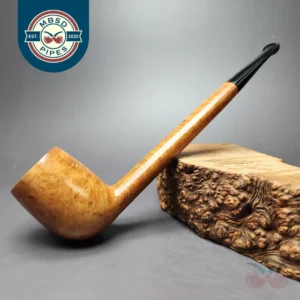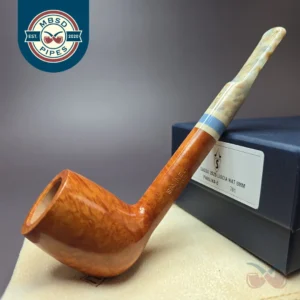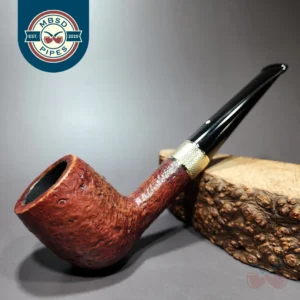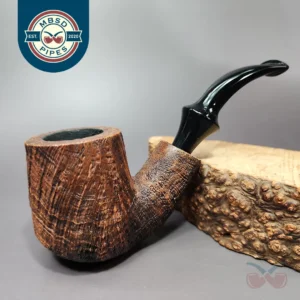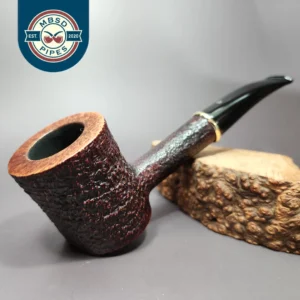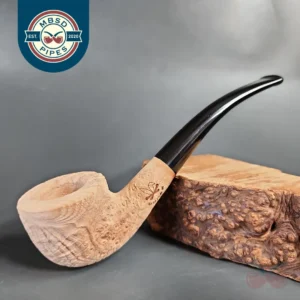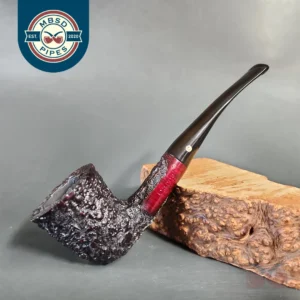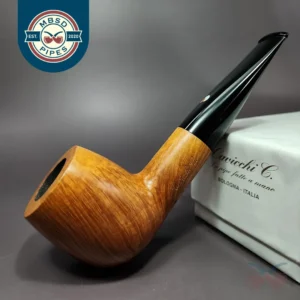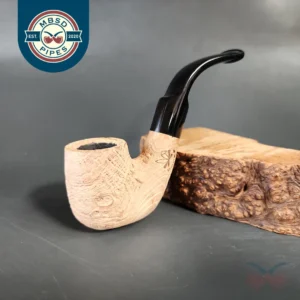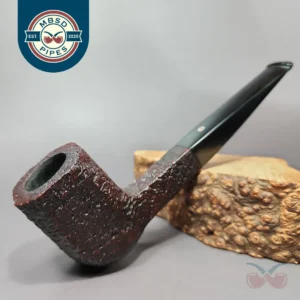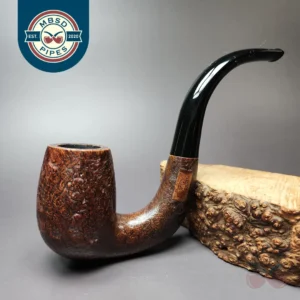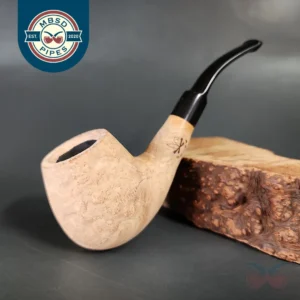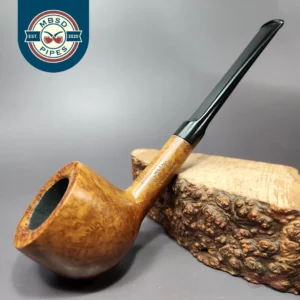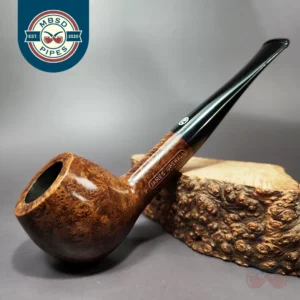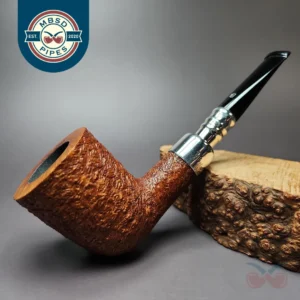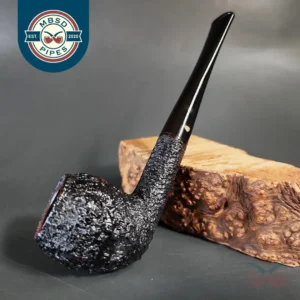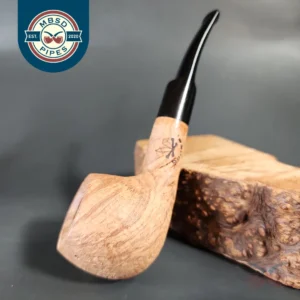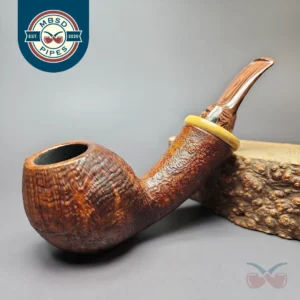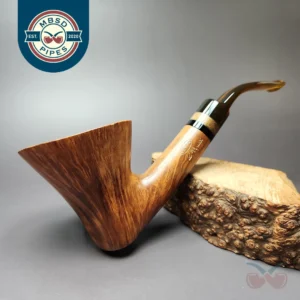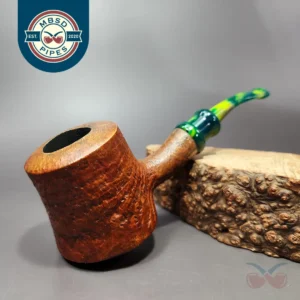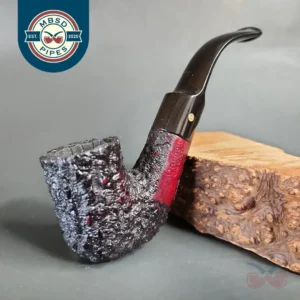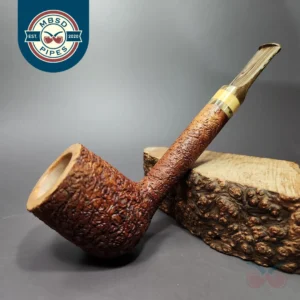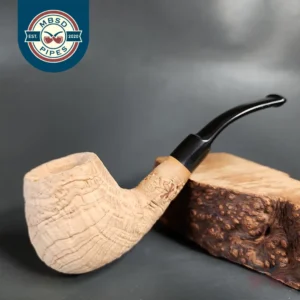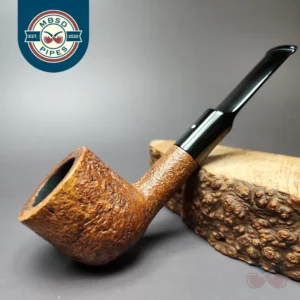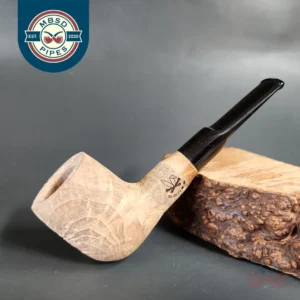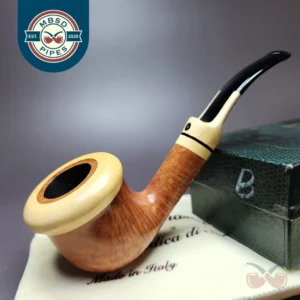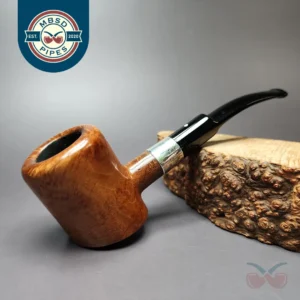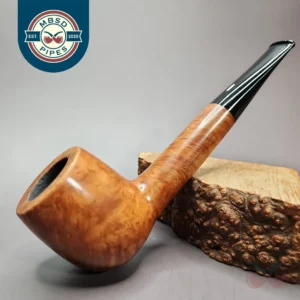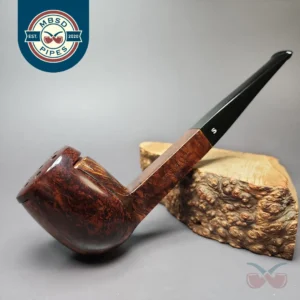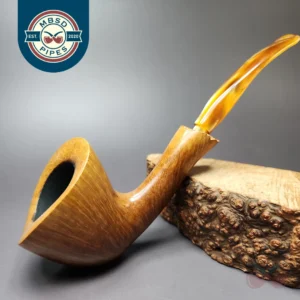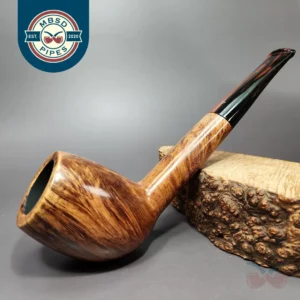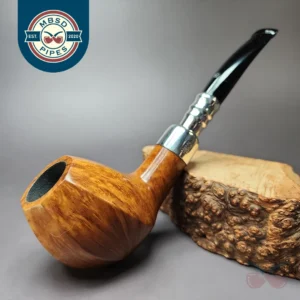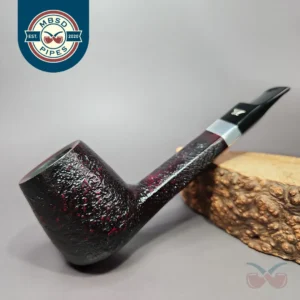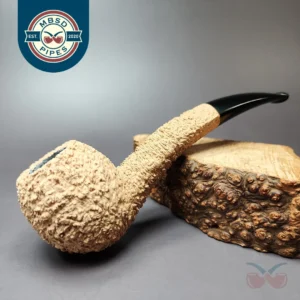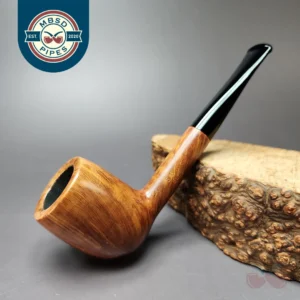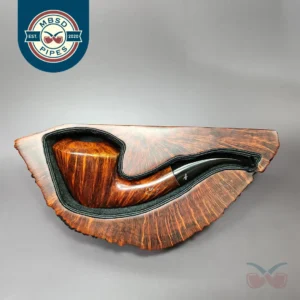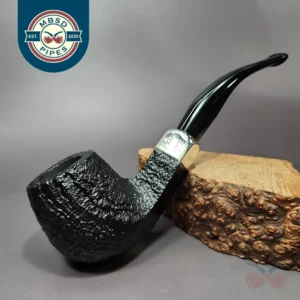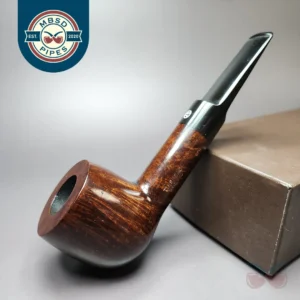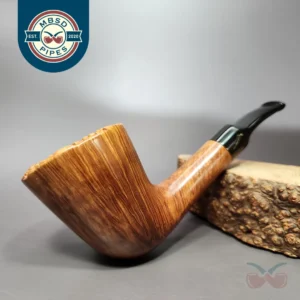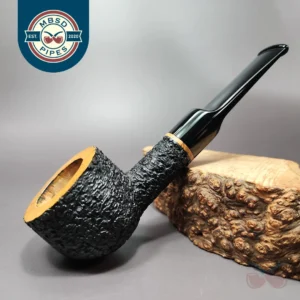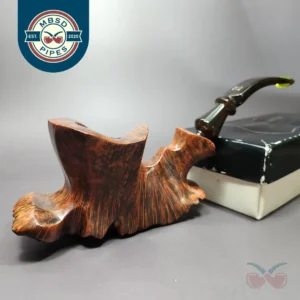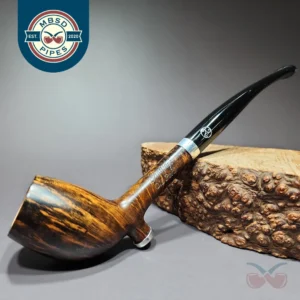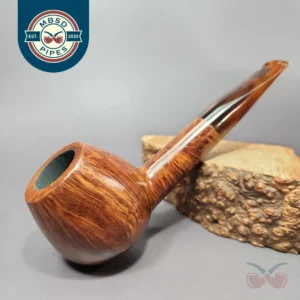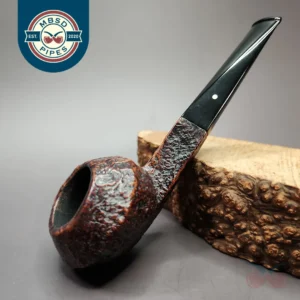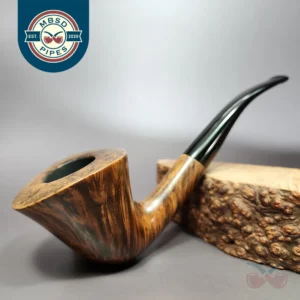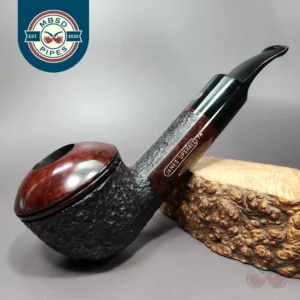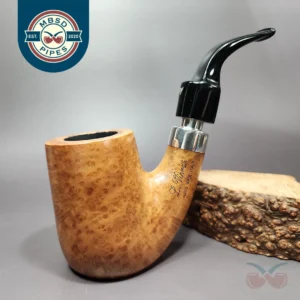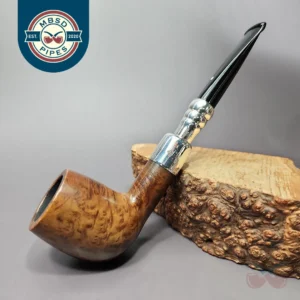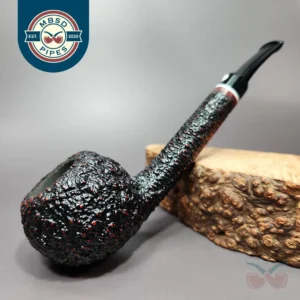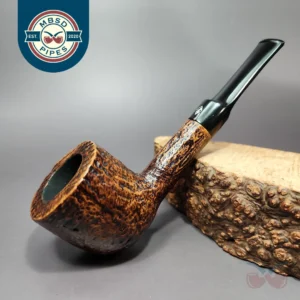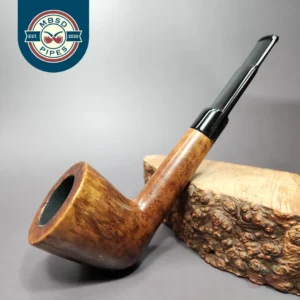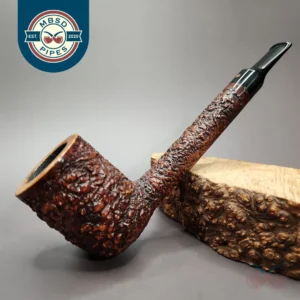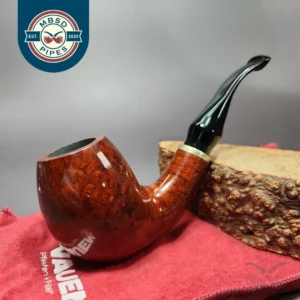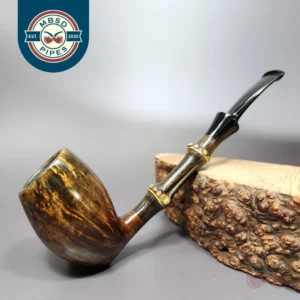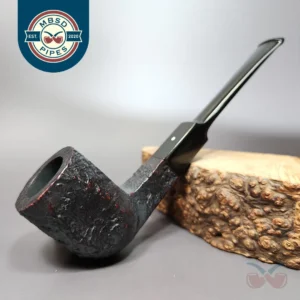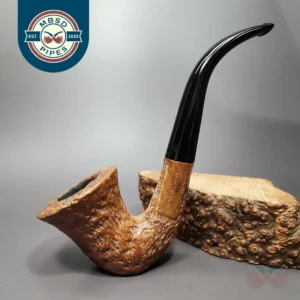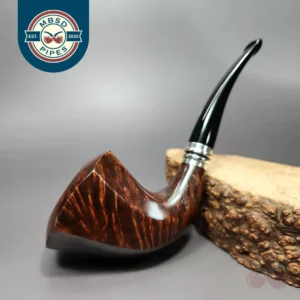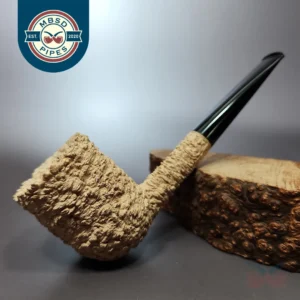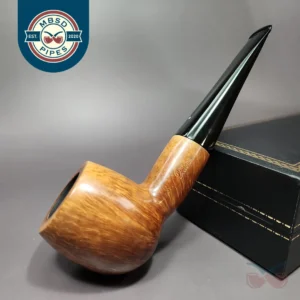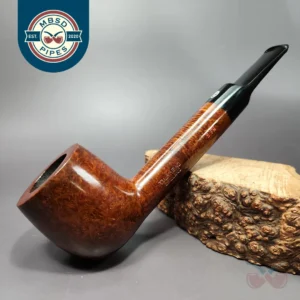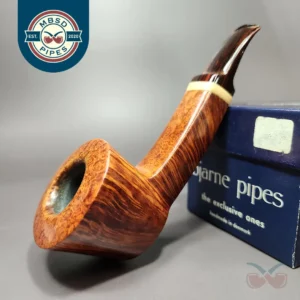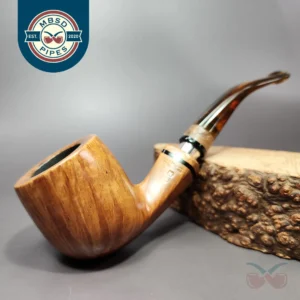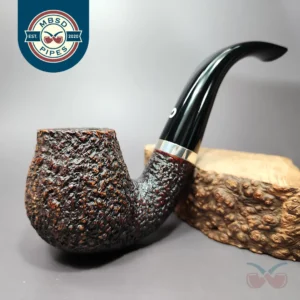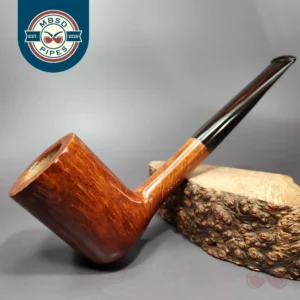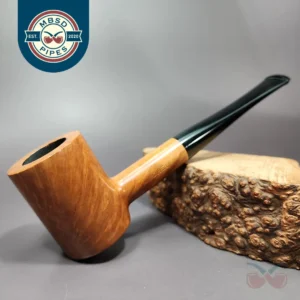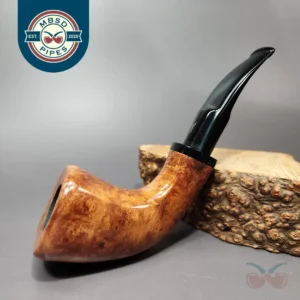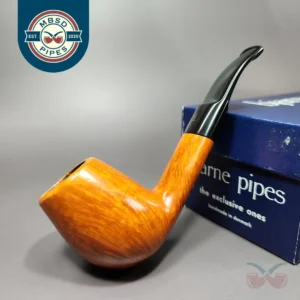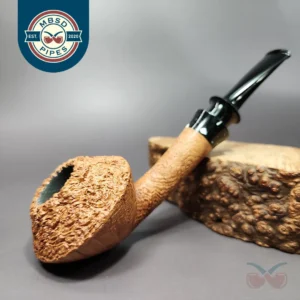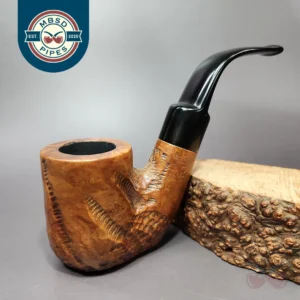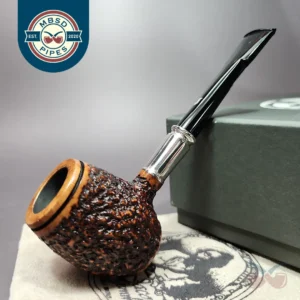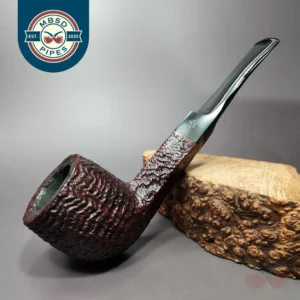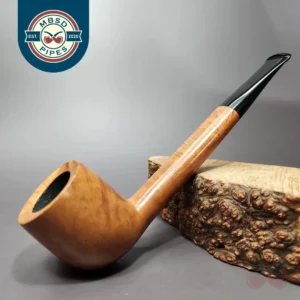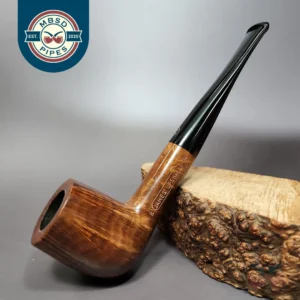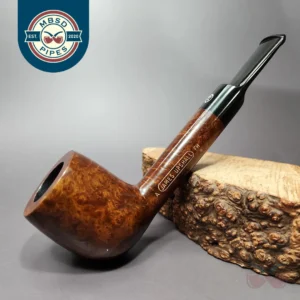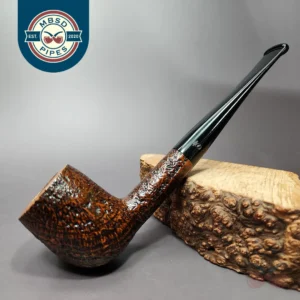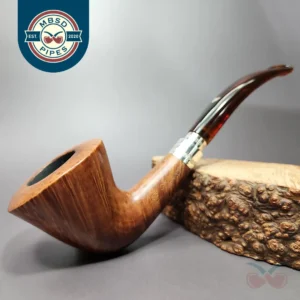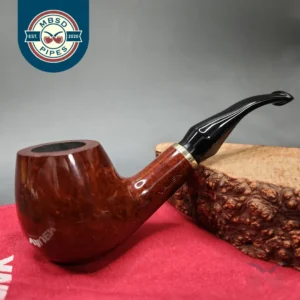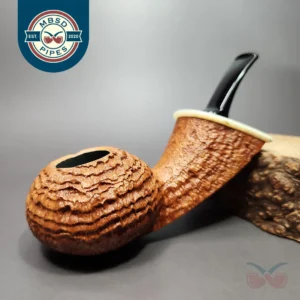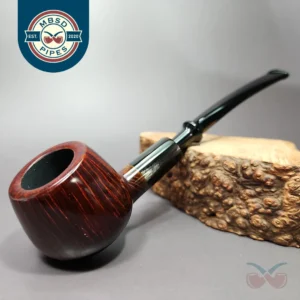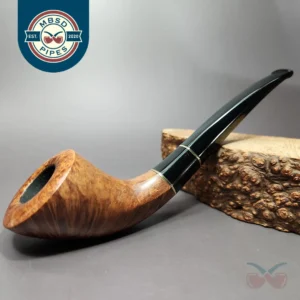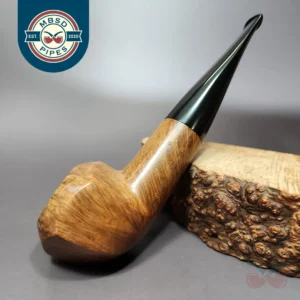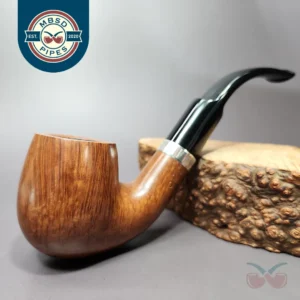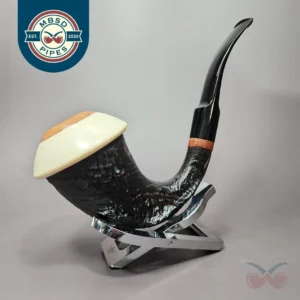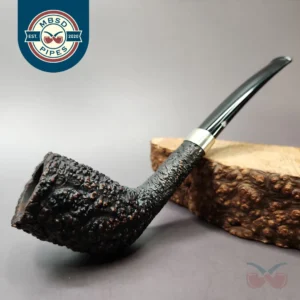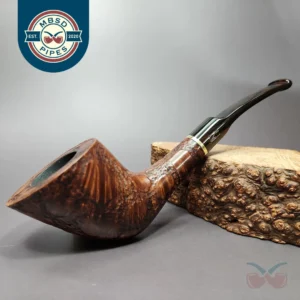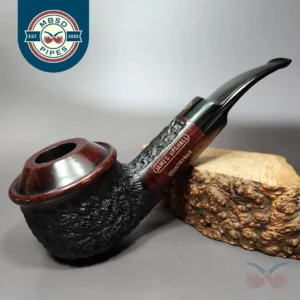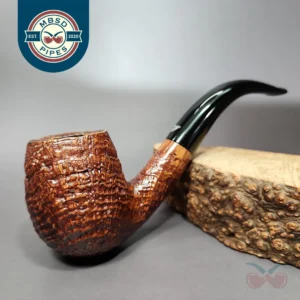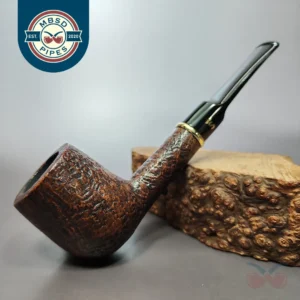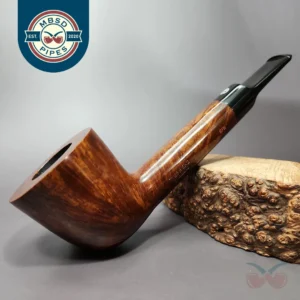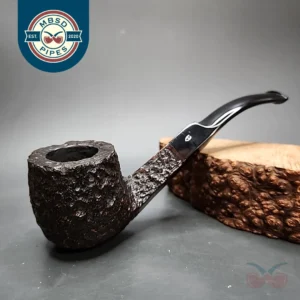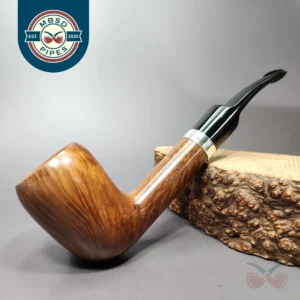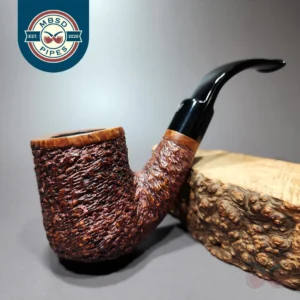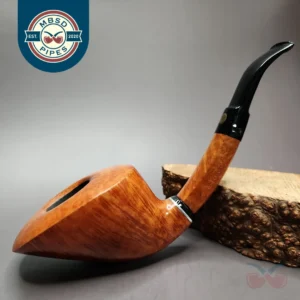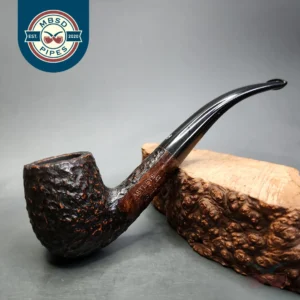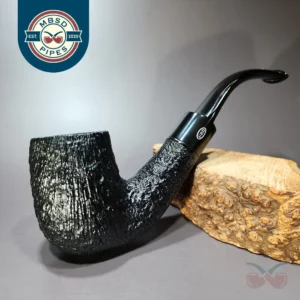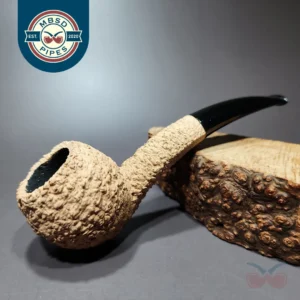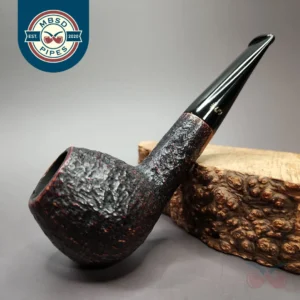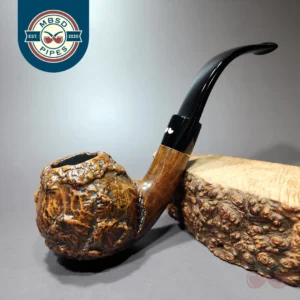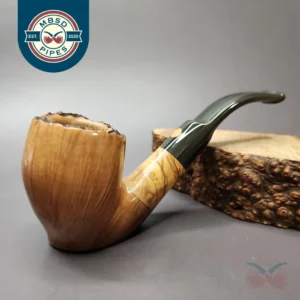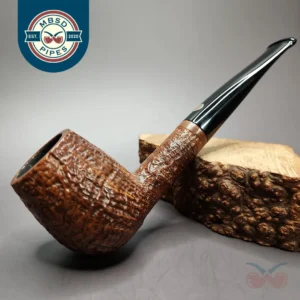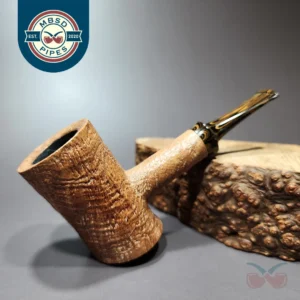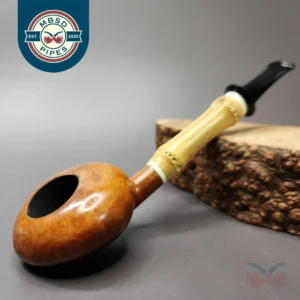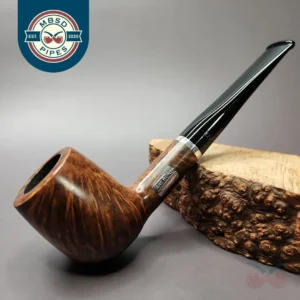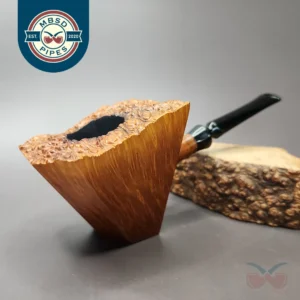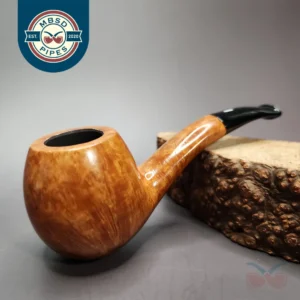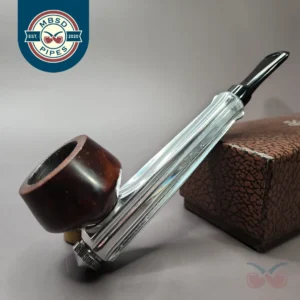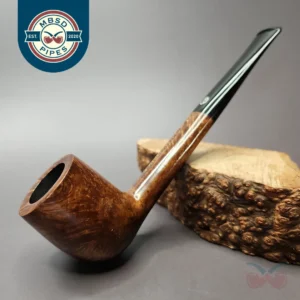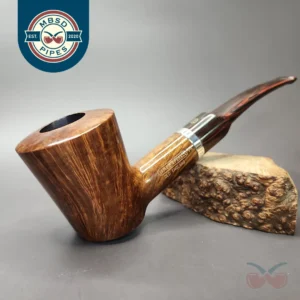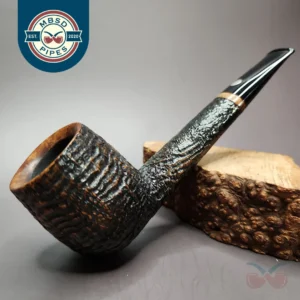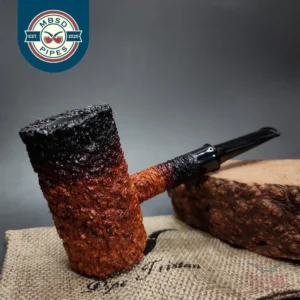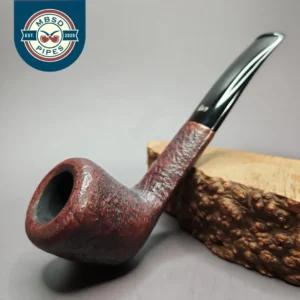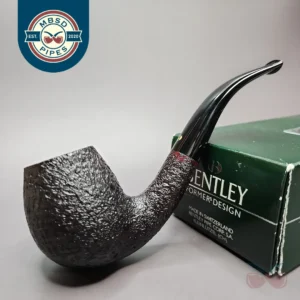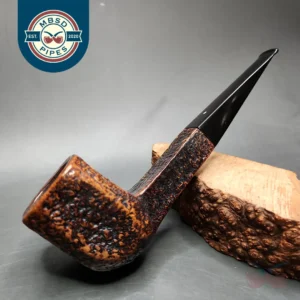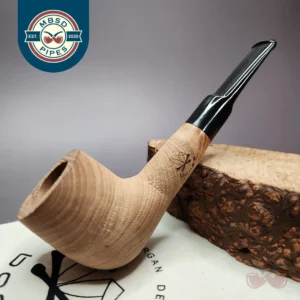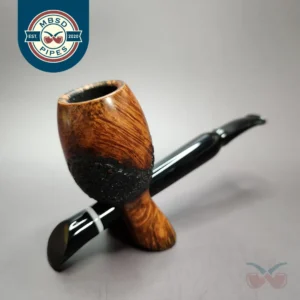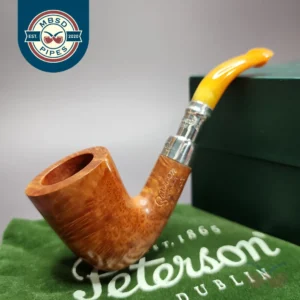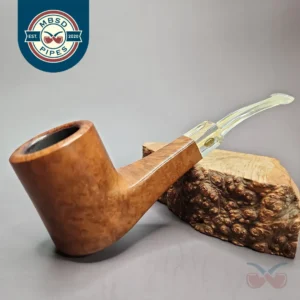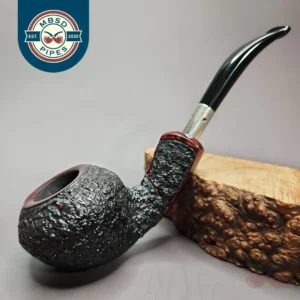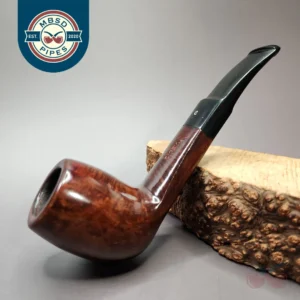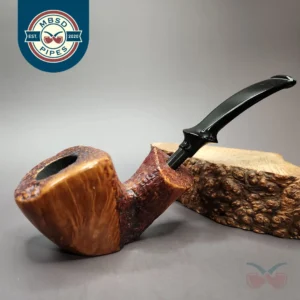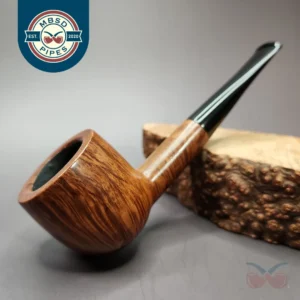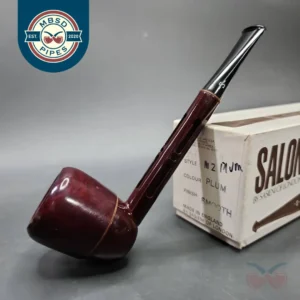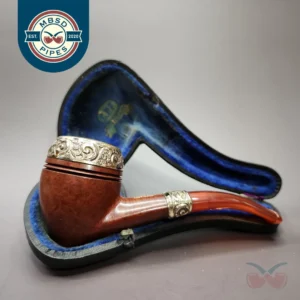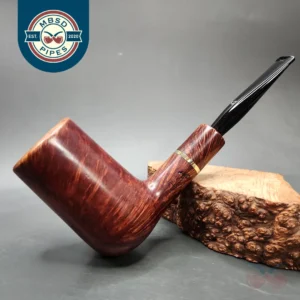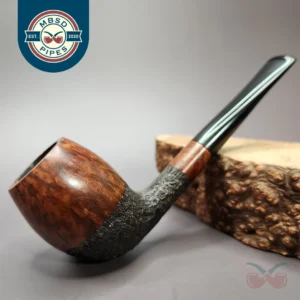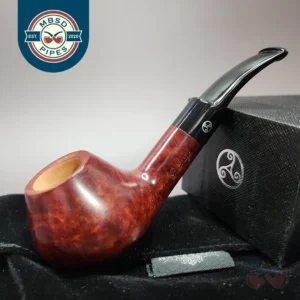Showing 501–1000 of 1953 resultsSorted by latest
-
Tsuge is Japan’s largest and most internationally renowned pipe company, having been founded in 1936 by Kyoichiro Tsuge. In the 1970s, however, Tsuge was so impressed by the pipes coming out of Denmark, that he sent two of Tsuge’s own master pipe-makers, Kazuhiro Fukuda and Smio Satou, to hone their craft under the likes of…
-
GBD was one of several prominent examples of a French pipe brand that, due to certain circumstances, became a maker most associated with classic ‘British’ pipes. Founded in 1850 by the French trio Ganneval, Bondier & Donninger, the brand was bought by English company Oppenheimer at the beginning of the 20th century, who opened factories…
-
Chacom is one of France’s most historic and iconic makes. Its founders, the Comoy family, began their career as boxwood pipe-makers in the early 1800s, before briar had even been discovered, with Henri Comoy (of Comoy’s fame) emigrating to England in 1879 and founding the country’s first briar pipe factory. In 1922, Henri and his…
-
Astleys was one of London’s most historic pipe and tobacco shops. Like many pipe tobacconists, its owners had pipes made specially to be sold under the shop’s name. Astleys pipes, however, were made by some of the premier pipe manufacturers and artisans in the UK, such as Dunhill, Charatan, Les Wood and Dolly Wood of…
-
It is probably fair to say that Savinelli is Italy’s most famous pipe brand. Founded in Milan in 1876 by Achille Savinelli, the brand has continuously offered high quality pipes for nearly 150 years. Though various Savinelli lines have come and gone over the years, the brand has always been notable for putting out classically…
-
The Bones pipe, also known as the Morgan Bones, is the brainchild of American artisan Chris Morgan. Originally conceived in 2015, the idea behind the bones was to offer a pipe that was both affordable and honest, as many pipes in this former category tended to rely on putty fills and other techniques to hide…
-
To veteran pipe smokers, Dunhill needs no introduction. Beginning in 1907, Alfred Dunhill began selling Dunhill pipes at the tobacconist shop he owned on London’s Duke Street. Very quickly, these pipes gained the reputation of being the ‘Rolls-Royce’ of pipes due to how expertly crafted they were. Today, Dunhill is likely Britain’s most famous pipe…
-
Stefano Santambrogio is one of only a handful of people in the world that can claim to be a third-generation pipe-maker. Like Nanna Ivarsson and Federico Becker, Santambrogio’s father and grandfather both made their living crafting pipes, with Santambrogio inheriting his workshop from his father, Renzo, just as Renzo inherited it (with his brother Armando)…
-
Peterson pipes generally need no introduction, but just in case you’re unfamiliar: in 1876, a Latvian named Charles Peterson immigrated to Ireland and was hired making pipes in a workshop owned by Frederick and George Kapp. After rising through the ranks to become head craftsman, Peterson bought into the Kapp’s business, which was renamed, Kapp…
-
While China has long been associated with cheaper factory pipes, a new generation of artisans and workshops have emerged over the past decade, producing some genuinely excellent pipes. HS Studio is an example of the latter, being a Hong Kong workshop dedicated to crafting handmade briars, typically in shapes and styles reminiscent of the post-war…
-
With its origins in an 1858 collaboration between Jean-Baptiste Choquin and Gustave Butz, Butz-Choquin ultimately become one of the premier smoking pipe companies in 20th century France. The brand is known both for its stylish variations on traditional English-French shapes and for its exploration of atypical and elaborate finishes. The brand is also known for…
-
You may have wondered, as I often do, what would happen if professional meerschaum carver was to turn their attention to briar wood, and to make pipes out of that instead. While many early briar pipe manufacturers, such as Frederick Charatan, made just such a transition back in the late 19th century, both briar and…
-
Ashton is an English pipe brand created by William Ashton Taylor, a former Dunhill pipe-maker who left Dunhill in the 1980s to make pipes under his own name. Along with other pipe-makers such as Ken Barnes and Barry Jones of James Upshall and Les Wood of Ferndown, Ashton emerged as part of a new wave…
-
The Bones pipe, also known as the Morgan Bones, is the brainchild of American artisan Chris Morgan. Originally conceived in 2015, the idea behind the bones was to offer a pipe that was both affordable and honest, as many pipes in this former category tended to rely on putty fills and other techniques to hide…
-
It is probably fair to say that Savinelli is Italy’s most famous pipe brand. Founded in Milan in 1876 by Achille Savinelli, the brand has continuously offered high quality pipes for nearly 150 years. Though various Savinelli lines have come and gone over the years, the brand has always been notable for putting out classically…
-
Alongside Julius Vesz, Phillip Trypis, and John Calich, Blatter is one of the pre-eminent names within the history of Canadian handmade pipes. But it is the Blatter name that has thus far endured for the longest time within that history. This is because the Blatter family have been in the business of making and selling…
-
It is probably fair to say that Savinelli is Italy’s most famous pipe brand. Founded in Milan in 1876 by Achille Savinelli, the brand has continuously offered high quality pipes for nearly 150 years. Though various Savinelli lines have come and gone over the years, the brand has always been notable for putting out classically…
-
The Bones pipe, also known as the Morgan Bones, is the brainchild of American artisan Chris Morgan. Originally conceived in 2015, the idea behind the bones was to offer a pipe that was both affordable and honest, as many pipes in this former category tended to rely on putty fills and other techniques to hide…
-
Peterson pipes generally need no introduction, but just in case you’re unfamiliar: in 1876, a Latvian named Charles Peterson immigrated to Ireland and was hired making pipes in a workshop owned by Frederick and George Kapp. After rising through the ranks to become head craftsman, Peterson bought into the Kapp’s business, which was renamed, Kapp…
-
Debuting all the way back in 2014, the BlackJack is one of the great success stories of American pipe-making in the 21st century. Conceived by California’s Chris Morgan (who would also go on to create the wildly successful Bones series), the Blackjack was conceived as a way to apply the techniques and design principles that…
-
The Bones pipe, also known as the Morgan Bones, is the brainchild of American artisan Chris Morgan. Originally conceived in 2015, the idea behind the bones was to offer a pipe that was both affordable and honest, as many pipes in this former category tended to rely on putty fills and other techniques to hide…
-
Peterson pipes generally need no introduction, but just in case you’re unfamiliar: in 1876, a Latvian named Charles Peterson immigrated to Ireland and was hired making pipes in a workshop owned by Frederick and George Kapp. After rising through the ranks to become head craftsman, Peterson bought into the Kapp’s business, which was renamed, Kapp…
-
Founded in 1947 by Carlo Scotti, Castello quickly became known for producing some of the finest smoking pipes in the world. Over the years, the people involved in making Castello pipes has changed – such as Luigi Radice and Sergio Ascorti, who developed their skills in the Cantu workshop before leaving to start Caminetto, or…
-
Debuting all the way back in 2014, the BlackJack is one of the great success stories of American pipe-making in the 21st century. Conceived by California’s Chris Morgan (who would also go on to create the wildly successful Bones series), the Blackjack was conceived as a way to apply the techniques and design principles that…
-
James Upshall was, along with Ferndown and Ashton, part of a new wave of British hand-made, high-grade pipes in the late 20th century, with their founders largely coming from previous positions in the factories of companies such as Dunhill and Charatan. James Upshall was founded in 1978 by Barry Jones and Ken Barnes, both of…
-
This particular pipe came to us with a batch of new old stock (NOS) pipes from a store closure a few states over. Based on what I was able to research, the Mina company runs a pipe workshop in China, not unlike HS Studio or GH Zhang, which produces a number of different makes based…
-
Debuting all the way back in 2014, the BlackJack is one of the great success stories of American pipe-making in the 21st century. Conceived by California’s Chris Morgan (who would also go on to create the wildly successful Bones series), the Blackjack was conceived as a way to apply the techniques and design principles that…
-
To veteran pipe smokers, Dunhill needs no introduction. Beginning in 1907, Alfred Dunhill began selling Dunhill pipes at the tobacconist shop he owned on London’s Duke Street. Very quickly, these pipes gained the reputation of being the ‘Rolls-Royce’ of pipes due to how expertly crafted they were. Today, Dunhill is likely Britain’s most famous pipe…
-
Peterson pipes generally need no introduction, but just in case you’re unfamiliar: in 1876, a Latvian named Charles Peterson immigrated to Ireland and was hired making pipes in a workshop owned by Frederick and George Kapp. After rising through the ranks to become head craftsman, Peterson bought into the Kapp’s business, which was renamed, Kapp…
-
Stanwell is one of Denmark’s most celebrated and enduring pipe companies, having been founded by Poul Nielsen shortly after the second world war. Over the last six decades, Stanwell has established itself as both a leader in innovative Danish design and for producing well-priced pipes with precision construction and engineering. Many of its designs were…
-
SederCraft pipes are made by Kraig Sederquist, an American artisan based in California. While Sederquist’s pipes vary in shaping and style, his pipes are predominantly freehand, following an ethos of letting the materials used (such as briar) decide what they will be, based on their natural affordances. I’ve been a fan of Kraig Sederquist’s work…
-
Preston Rogers is an American artisan based in Lexington, Kentucky. As keen pipe smoker (with an insatiable appetite for Latakia blends) Rogers was fascinated with modern, handmade pipes but, like so many of us in the community, found that his budget would not allow him to purchase as many of these pipes as he would…
-
James Upshall was, along with Ferndown and Ashton, part of a new wave of British hand-made, high-grade pipes in the late 20th century, with their founders largely coming from previous positions in the factories of companies such as Dunhill and Charatan. James Upshall was founded in 1978 by Barry Jones and Ken Barnes, both of…
-
Beginning his career as a pipe-maker in the 1970s, Randy Wiley was a key figure in the new wave of American artisans in the late-20th century pipe scene – and still is today, nearly 50 years later. Wiley’s pipes might be characterized as American freehand in style; though he has occasionally made more traditional pieces,…
-
The Bones pipe, also known as the Morgan Bones, is the brainchild of American artisan Chris Morgan. Originally conceived in 2015, the idea behind the bones was to offer a pipe that was both affordable and honest, as many pipes in this former category tended to rely on putty fills and other techniques to hide…
-
Karim Pipes are made by Abdul Karim, an artisan pipe-maker based in Tangerang, Indonesia. A pipe-maker since 2016, Karim is part of an emerging 21st century movement of Indonesian artisan carvers, including Wandi Riyadi, Deden Hendan Durahman of Caxra Pipes, Karim’s mentor, Edy Bima, and Karim’s mentee, Bennie Joe, whose pipes MBSD has also sold….
-
The Bones pipe, also known as the Morgan Bones, is the brainchild of American artisan Chris Morgan. Originally conceived in 2015, the idea behind the bones was to offer a pipe that was both affordable and honest, as many pipes in this former category tended to rely on putty fills and other techniques to hide…
-
Michel pipes were store-brand pipes made for Maison Michel, a North Carolina (USA) tobacconist run by Michel J. Mitchell between 1951 and 1980. Over the years, several prominent pipe-makers made pipes for Maison Michel, such as Charatan, Barling, and others. Of all of the pipes that have come through over the years, Michel is one…
-
To veteran pipe smokers, Dunhill needs no introduction. Beginning in 1907, Alfred Dunhill began selling Dunhill pipes at the tobacconist shop he owned on London’s Duke Street. Very quickly, these pipes gained the reputation of being the ‘Rolls-Royce’ of pipes due to how expertly crafted they were. Today, Dunhill is likely Britain’s most famous pipe…
-
Alongside near-contemporaries such as Otto Pollner and Karlheinz Joura, Rainer Barbi was one of the ‘grand old men’ of German artisan pipe-making. Beginning his career in the 1970s, Barbi was largely self-taught, but nevertheless managed to establish a reputation as one of the most talented freehand pipe carvers in the world. In his later years,…
-
While figural carvings are typically associated with meerschaum pipes today, it was very common in the late 19th and early 20th centuries for briar pipes to be similarly carved, and indeed to be carved in similar themes to their meerschaum counterparts. I’m not entirely sure when this one was made, as I think Lane Ltd…
-
Stanwell is one of Denmark’s most celebrated and enduring pipe companies, having been founded by Poul Nielsen shortly after the second world war. Over the last six decades, Stanwell has established itself as both a leader in innovative Danish design and for producing well-priced pipes with precision construction and engineering. Many of its designs were…
-
Walt Cannoy first emerged as a major figure in the the North American pipe-making renaissance around the turn of the millennium. Originally an R&D mechanic, Cannoy carved and sold his first pipe in 1999, having been inspired by artisan pipe-makers as diverse as Preben Holm, Robert ‘Micoli’ Burns, and Joe Mariner. Cannoy would soon rise…
-
Walt Cannoy first emerged as a major figure in the the North American pipe-making renaissance around the turn of the millennium. Originally an R&D mechanic, Cannoy carved and sold his first pipe in 1999, having been inspired by artisan pipe-makers as diverse as Preben Holm, Robert ‘Micoli’ Burns, and Joe Mariner. Cannoy would soon rise…
-
Walt Cannoy first emerged as a major figure in the the North American pipe-making renaissance around the turn of the millennium. Originally an R&D mechanic, Cannoy carved and sold his first pipe in 1999, having been inspired by artisan pipe-makers as diverse as Preben Holm, Robert ‘Micoli’ Burns, and Joe Mariner. Cannoy would soon rise…
-
Roma are budget-friendly pipes made by Italy’s major pipe factories. One could think of them as an unofficial ‘seconds’ line for various Italian mainstays. Details: Length: 5.8″ / 147.3mm Bowl Width: 0.80 / 20.32mm Bowl Depth: 1.63″ / 41.40mm Weight: 1.8oz / 52g
-
Walt Cannoy first emerged as a major figure in the the North American pipe-making renaissance around the turn of the millennium. Originally an R&D mechanic, Cannoy carved and sold his first pipe in 1999, having been inspired by artisan pipe-makers as diverse as Preben Holm, Robert ‘Micoli’ Burns, and Joe Mariner. Cannoy would soon rise…
-
James Upshall was, along with Ferndown and Ashton, part of a new wave of British hand-made, high-grade pipes in the late 20th century, with their founders largely coming from previous positions in the factories of companies such as Dunhill and Charatan. James Upshall was founded in 1978 by Barry Jones and Ken Barnes, both of…
-
Walt Cannoy first emerged as a major figure in the the North American pipe-making renaissance around the turn of the millennium. Originally an R&D mechanic, Cannoy carved and sold his first pipe in 1999, having been inspired by artisan pipe-makers as diverse as Preben Holm, Robert ‘Micoli’ Burns, and Joe Mariner. Cannoy would soon rise…
-
It is probably fair to say that Savinelli is Italy’s most famous pipe brand. Founded in Milan in 1876 by Achille Savinelli, the brand has continuously offered high quality pipes for nearly 150 years. Though various Savinelli lines have come and gone over the years, the brand has always been notable for putting out classically…
-
James Upshall was, along with Ferndown and Ashton, part of a new wave of British hand-made, high-grade pipes in the late 20th century, with their founders largely coming from previous positions in the factories of companies such as Dunhill and Charatan. James Upshall was founded in 1978 by Barry Jones and Ken Barnes, both of…
-
It is probably fair to say that Savinelli is Italy’s most famous pipe brand. Founded in Milan in 1876 by Achille Savinelli, the brand has continuously offered high quality pipes for nearly 150 years. Though various Savinelli lines have come and gone over the years, the brand has always been notable for putting out classically…
-
Bjarne Nielsen was one of the towering figures of Danish pipe-making until his passing in 2008. As the founder of Bjarne, Nielsen employed talented pipe-makers from Denmark to produce distinctly Danish pipes and sold them to a devoted international audience. Among those in his employ were figures such as Mogens Johansen (also known as Johs),…
-
Stanwell is one of Denmark’s most celebrated and enduring pipe companies, having been founded by Poul Nielsen shortly after the second world war. Over the last six decades, Stanwell has established itself as both a leader in innovative Danish design and for producing well-priced pipes with precision construction and engineering. Many of its designs were…
-
Debuting all the way back in 2014, the BlackJack is one of the great success stories of American pipe-making in the 21st century. Conceived by California’s Chris Morgan (who would also go on to create the wildly successful Bones series), the Blackjack was conceived as a way to apply the techniques and design principles that…
-
As a child, Piero Vitale spent many an afternoon in the workshop of his grandfather, who was a carpenter and luthier. This proclivity for working with his hands translated into a number of artistic pursuits as he grew up, including painting and wood carving. Then Vitale was introduced to the world of handmade pipes by…
-
Debuting all the way back in 2014, the BlackJack is one of the great success stories of American pipe-making in the 21st century. Conceived by California’s Chris Morgan (who would also go on to create the wildly successful Bones series), the Blackjack was conceived as a way to apply the techniques and design principles that…
-
The Bones pipe, also known as the Morgan Bones, is the brainchild of American artisan Chris Morgan. Originally conceived in 2015, the idea behind the bones was to offer a pipe that was both affordable and honest, as many pipes in this former category tended to rely on putty fills and other techniques to hide…
-
Debuting all the way back in 2014, the BlackJack is one of the great success stories of American pipe-making in the 21st century. Conceived by California’s Chris Morgan (who would also go on to create the wildly successful Bones series), the Blackjack was conceived as a way to apply the techniques and design principles that…
-
GBD was one of several prominent examples of a French pipe brand that, due to certain circumstances, became a maker most associated with classic ‘British’ pipes. Founded in 1850 by the French trio Ganneval, Bondier & Donninger, the brand was bought by English company Oppenheimer at the beginning of the 20th century, who opened factories…
-
The Bones pipe, also known as the Morgan Bones, is the brainchild of American artisan Chris Morgan. Originally conceived in 2015, the idea behind the bones was to offer a pipe that was both affordable and honest, as many pipes in this former category tended to rely on putty fills and other techniques to hide…
-
Debuting all the way back in 2014, the BlackJack is one of the great success stories of American pipe-making in the 21st century. Conceived by California’s Chris Morgan (who would also go on to create the wildly successful Bones series), the Blackjack was conceived as a way to apply the techniques and design principles that…
-
Founded in 1947 by Carlo Scotti, Castello quickly became known for producing some of the finest smoking pipes in the world. Over the years, the people involved in making Castello pipes has changed – such as Luigi Radice and Sergio Ascorti, who developed their skills in the Cantu workshop before leaving to start Caminetto, or…
-
Over the last decade or so, Indonesia has produced some impressive pipe-makers in the artisan scene. West Java’s Wandi Riyadi was one of the first to receive major international acclaim, inspiring many more of his compatriots to take up the craft – something that we at MBSD, having carried a couple of talented Indonesian artisans,…
-
Larry Roush is an American artisan, one whose work has led him to be one of the most esteemed and in-demand figures in the contemporary handmades scene. Though he is a former student of Mike Butera, who he would later collaborate with from time to time, Roush’s style is wholly his own. Already in 2004,…
-
Founded in 1947 by Carlo Scotti, Castello quickly became known for producing some of the finest smoking pipes in the world. Over the years, the people involved in making Castello pipes has changed – such as Luigi Radice and Sergio Ascorti, who developed their skills in the Cantu workshop before leaving to start Caminetto, or…
-
It is probably fair to say that Savinelli is Italy’s most famous pipe brand. Founded in Milan in 1876 by Achille Savinelli, the brand has continuously offered high quality pipes for nearly 150 years. Though various Savinelli lines have come and gone over the years, the brand has always been notable for putting out classically…
-
Debuting all the way back in 2014, the BlackJack is one of the great success stories of American pipe-making in the 21st century. Conceived by California’s Chris Morgan (who would also go on to create the wildly successful Bones series), the Blackjack was conceived as a way to apply the techniques and design principles that…
-
Hardcastle was founded by Edmund Hardcastle in 1906, in London, England. Like many pipe-makers of the time, such as Barling and Sasieni Hardcastle was originally a family-owned business, with its ‘family era’ coming to an end over the course of the years 1936-1946. During this time, Dunhill partially, then fully, bought out the Hardcastle factory…
-
The Bones pipe, also known as the Morgan Bones, is the brainchild of American artisan Chris Morgan. Originally conceived in 2015, the idea behind the bones was to offer a pipe that was both affordable and honest, as many pipes in this former category tended to rely on putty fills and other techniques to hide…
-
Ashton is an English pipe brand created by William Ashton Taylor, a former Dunhill pipe-maker who left Dunhill in the 1980s to make pipes under his own name. Along with other pipe-makers such as Ken Barnes and Barry Jones of James Upshall and Les Wood of Ferndown, Ashton emerged as part of a new wave…
-
Bjarne Nielsen was one of the towering figures of Danish pipe-making until his passing in 2008. As the founder of Bjarne, Nielsen employed talented pipe-makers from Denmark to produce distinctly Danish pipes and sold them to a devoted international audience. Among those in his employ were figures such as Mogens Johansen (also known as Johs),…
-
Ser Jacopo is one of the most famous contemporary examples of high-grade, workshop-made Italian pipes. It also belongs to a very special tradition in Italian pipe-making, having been established by Giancarlo Guidi and Bruno Sordini after the two had left another great Italian workshop, Mastro de Paja. Together, Guidi and Sordini created a brand of…
-
Karl Erik was a Danish pipe-maker, and one of the originators of the Danish style of pipe-making that swept the world in the 20th century. He was a prolific carver and many who apprenticed in his workshop went on to become iconic pipe-makers in their own right, such as Peder Jeppesen and Bent Nielsen (Benner)….
-
You may not know it, but Dr Plumb is one of the oldest extant briar pipe makes, having been established all the way back in 1925. And, while the name sounds like it should be an Anglophone invention, it was originally a French one – though admittedly it is claimed that the name was borrowed…
-
It is probably fair to say that Savinelli is Italy’s most famous pipe brand. Founded in Milan in 1876 by Achille Savinelli, the brand has continuously offered high quality pipes for nearly 150 years. Though various Savinelli lines have come and gone over the years, the brand has always been notable for putting out classically…
-
Originally trained as a woodworker, Nashville’s Zack Hamric took up pipe making as a hobbyist in the late 20th century. Like many an American artisan during that time, his output was largely Danish-influenced freehands. After a long hiatus, Hamric resumed his pipe making in the 2010s, ready to approach the craft as a professional. Hamric’s…
-
Beginning his career as a pipe-maker in the 1970s, Randy Wiley was a key figure in the new wave of American artisans in the late-20th century pipe scene – and still is today, nearly 50 years later. Wiley’s pipes might be characterized as American freehand in style; though he has occasionally made more traditional pieces,…
-
Radice is one of the great Italian workshop pipe makes, belonging to a historic lineage of such workshops. The company began as a family affair, being established in 1980 by Luigi Radice, along with his son, Gianluca, and father, Paolo. But Radice’s pipe-making ‘family’ is a little larger than that. Prior to founding Radice, Luigi…
-
Karim Pipes are made by Abdul Karim, an artisan pipe-maker based in Tangerang, Indonesia. A pipe-maker since 2016, Karim is part of an emerging 21st century movement of Indonesian artisan carvers, including Wandi Riyadi, Deden Hendan Durahman of Caxra Pipes, Karim’s mentor, Edy Bima, and Karim’s mentee, Bennie Joe, whose pipes MBSD has also sold….
-
Michel pipes were store-brand pipes made for Maison Michel, a North Carolina (USA) tobacconist run by Michel J. Mitchell between 1951 and 1980. Over the years, several prominent pipe-makers made pipes for Maison Michel, such as Charatan, Barling, and others. Another very beautiful and relatively lightweight author shape from Maison Michel. The grain on this…
-
James Upshall was, along with Ferndown and Ashton, part of a new wave of British hand-made, high-grade pipes in the late 20th century, with their founders largely coming from previous positions in the factories of companies such as Dunhill and Charatan. James Upshall was founded in 1978 by Barry Jones and Ken Barnes, both of…
-
Barling and Sons was originally founded in 1812 by Benjamin Barling and began as a family business making silver-adorned meerschaum pipes. In the early 20th century, however, the Barling family began to produce what the brand is today most famous for – expertly made briar pipes. This particular Barling comes from a much-debated period in…
-
Hilson is something of an outlier in the pipe world, in that it is a successful company not from England, Denmark, France, the USA, or indeed any of the countries typically associated with pipe-making. Instead, Hilson is a pipe company that began in Belgium. Hilson was founded by the Hillen family in Bree in the…
-
Much like in Denmark or Japan, many of the great names in Italian artisan pipe-making got their start working for other greats in their famous workshops. This was the case for artisans such as Giancarlo Guidi, Luigi Radice, Sergio Ascorti, and Maurizio Tombari. Luigi Viprati, on the other hand, is one of the few self-taught…
-
You may not know it, but Dr Plumb is one of the oldest extant briar pipe makes, having been established all the way back in 1925. And, while the name sounds like it should be an Anglophone invention, it was originally a French one – though admittedly it is claimed that the name was borrowed…
-
The “Ace of Spades” is a signature design of Pennsylvania artisan Thomas James, who took up pipe making all the way back in 2006. By all appearances it’s a unique synthesis of Danish and Italian aesthetics; viewed from the side, it’s a beautifully cut scoop shape, with clear Danish and Danish-American inclinations; it also wears…
-
To call Canada’s Todd Bannard, the artisan behind Briar, Sweat and Tears (BST) pipes, a “cult favorite” would be a profound understatement. Like his fellow countrymen Michael Parks and Julius Vesz, Bannard’s work has demonstrated that, though Canada may have far fewer pipe-makers than its neighbors in the US, Canadian handmades truly are a matter…
-
Peterson pipes generally need no introduction, but just in case you’re unfamiliar: in 1876, a Latvian named Charles Peterson immigrated to Ireland and was hired making pipes in a workshop owned by Frederick and George Kapp. After rising through the ranks to become head craftsman, Peterson bought into the Kapp’s business, which was renamed, Kapp…
-
It is probably fair to say that Savinelli is Italy’s most famous pipe brand. Founded in Milan in 1876 by Achille Savinelli, the brand has continuously offered high quality pipes for nearly 150 years. Though various Savinelli lines have come and gone over the years, the brand has always been notable for putting out classically…
-
While Dunhill may be Britain’s most famous pipe brand, Charatan is not only older, but has the honor of being the first to have made its pipes entirely in-house. ‘Charatan’s Make’ referred to the fact that, at a time when other pipe companies were sourcing stummels and stems carved from other companies before assembling them…
-
Ferndown pipes were made by the legendary British pipe-maker Leslie ‘Les’ John Wood, along with his wife Dolly. Both Les and Dolly previously worked for Dunhill, where Les developed his skills and reputation as Britain’s premier pipe silversmith, as well as one of its premier pipe carvers. Ferndown pipes are highly coveted by pipe-smokers due…
-
Ascorti belongs to a historic lineage in Italian artisan pipe-making. Guiseppe ‘Peppino’ Ascorti was first employed as a pipe-maker in the 1950s, in Carlo Scotti’s Castello workshop in Cantu. There he met Luigi Radice, and in the 1960s the two decided to leave Castello to create their own pipe-making workshop, under the name ‘Caminetto.’ At…
-
Stanwell is one of Denmark’s most celebrated and enduring pipe companies, having been founded by Poul Nielsen shortly after the second world war. Over the last six decades, Stanwell has established itself as both a leader in innovative Danish design and for producing well-priced pipes with precision construction and engineering. Many of its designs were…
-
Sale!
Founded in 1947 by Carlo Scotti, Castello quickly became known for producing some of the finest smoking pipes in the world. Over the years, the people involved in making Castello pipes has changed – such as Luigi Radice and Sergio Ascorti, who developed their skills in the Cantu workshop before leaving to start Caminetto, or…
-
Bennie Joe Pipes are made by Bennie Joe, an Indonesian artisan based in Jakarta. A trained architect and part-time pipe-maker for much of his life, he took on the latter full-time after a downturn in the property market during the dark days of 2020 and after. An interesting aspect of Bennie Joe pipes is that…
-
Michel pipes were store-brand pipes made for Maison Michel, a North Carolina (USA) tobacconist run by Michel J. Mitchell between 1951 and 1980. Over the years, several prominent pipe-makers made pipes for Maison Michel, such as Charatan, Barling, and others. Of all of the pipes that have come through over the years, Michel is one…
-
Peterson pipes generally need no introduction, but just in case you’re unfamiliar: in 1876, a Latvian named Charles Peterson immigrated to Ireland and was hired making pipes in a workshop owned by Frederick and George Kapp. After rising through the ranks to become head craftsman, Peterson bought into the Kapp’s business, which was renamed, Kapp…
-
Radice is one of the great Italian workshop pipe makes, belonging to a historic lineage of such workshops. The company began as a family affair, being established in 1980 by Luigi Radice, along with his son, Gianluca, and father, Paolo. But Radice’s pipe-making ‘family’ is a little larger than that. Prior to founding Radice, Luigi…
-
Debuting all the way back in 2014, the BlackJack is one of the great success stories of American pipe-making in the 21st century. Conceived by California’s Chris Morgan (who would also go on to create the wildly successful Bones series), the Blackjack was conceived as a way to apply the techniques and design principles that…
-
You may not know it, but Dr Plumb is one of the oldest extant briar pipe makes, having been established all the way back in 1925. And, while the name sounds like it should be an Anglophone invention, it was originally a French one – though admittedly it is claimed that the name was borrowed…
-
Les Wood and Dolly Wood both began their careers in pipes working for Dunhill, with Les working in the silver mounting department, and Dolly working in the finishing department. While at Dunhill, both learned the fundamentals of making pipes, and after marrying and leaving the company, the two began to create pipes of their own….
-
Michel pipes were store-brand pipes made for Maison Michel, a North Carolina (USA) tobacconist run by Michel J. Mitchell between 1951 and 1980. Over the years, several prominent pipe-makers made pipes for Maison Michel, such as Charatan, Barling, and others. Of all of the pipes that have come through over the years, Michel is one…
-
Debuting all the way back in 2014, the BlackJack is one of the great success stories of American pipe-making in the 21st century. Conceived by California’s Chris Morgan (who would also go on to create the wildly successful Bones series), the Blackjack was conceived as a way to apply the techniques and design principles that…
-
It would not be unreasonable to say that Peter Matzhold is one of Austria’s foremost living pipe-maker—if not the foremost living pipe-maker from Austria. Nor would it be to say that he is one of the foremost living pipe-makers in the entire German-speaking region of Europe, rivaled only by other masters such as Wolfgang Becker….
-
As is often the case with the greats of Danish pipe-making, the story of Poul Winsløw begins as one of a master and an apprentice. That master was none other than Preben Holm; the apprentice was a young Winsløw. Holm held Winsløw in especial regard, with the latter ending up as the former’s head assistant…
-
Stanwell is one of Denmark’s most celebrated and enduring pipe companies, having been founded by Poul Nielsen shortly after the second world war. Over the last six decades, Stanwell has established itself as both a leader in innovative Danish design and for producing well-priced pipes with precision construction and engineering. Many of its designs were…
-
Much like in Denmark or Japan, many of the great names in Italian artisan pipe-making got their start working for other greats in their famous workshops. This was the case for artisans such as Giancarlo Guidi, Luigi Radice, Sergio Ascorti, and Maurizio Tombari. Luigi Viprati, on the other hand, is one of the few self-taught…
-
Sven Lar was the name used by a workshop headed by American freehand carver Michael Kabik. Kabik got his start as one of the earliest freehand carvers in the United States, working for CHP-X Pipes, owned by Chuck Holiday, in the early-1970s. After CHP-X was forced to close, Kabik was approached with the offer of…
-
Astleys was one of London’s most historic pipe and tobacco shops. Like many pipe tobacconists, its owners had pipes made specially to be sold under the shop’s name. Astleys pipes, however, were made by some of the premier pipe manufacturers and artisans in the UK, such as Dunhill, Charatan, Les Wood and Dolly Wood of…
-
Debuting all the way back in 2014, the BlackJack is one of the great success stories of American pipe-making in the 21st century. Conceived by California’s Chris Morgan (who would also go on to create the wildly successful Bones series), the Blackjack was conceived as a way to apply the techniques and design principles that…
-
Debuting all the way back in 2014, the BlackJack is one of the great success stories of American pipe-making in the 21st century. Conceived by California’s Chris Morgan (who would also go on to create the wildly successful Bones series), the Blackjack was conceived as a way to apply the techniques and design principles that…
-
The William Demuth Company, otherwise known as WDC, was established in 1862 by German-born American William Demuth, and survived as a mainstay brand in the United States until the 1970s. It would not be inappropriate to call such pipes ‘presidential,’ given that, owing initially to Demuth’s friendship with US president James Garfield, WDC pipes became…
-
As is often the case with the greats of Danish pipe-making, the story of Poul Winsløw begins as one of a master and an apprentice. That master was none other than Preben Holm; the apprentice was a young Winsløw. Holm held Winsløw in especial regard, with the latter ending up as the former’s head assistant…
-
Debuting all the way back in 2014, the BlackJack is one of the great success stories of American pipe-making in the 21st century. Conceived by California’s Chris Morgan (who would also go on to create the wildly successful Bones series), the Blackjack was conceived as a way to apply the techniques and design principles that…
-
The Sasso is one of a number of new lines released by Savinelli this year, all of which have really impressed me. The Sasso might be my favorite, and indeed might be my favorite Savinelli release since the Miele, which I adore. Coming from the Italian word for “stone,” the Sasso is distinguished by its…
-
Ichi Kitahara is a Japanese pipe-maker, but he’s also something of a renaissance man. He is classically trained in fine art; he has spent time as a high-end jeweler and silversmith; he has also worked as an Itame, the Japanese name for a particularly skilled sushi chef; and last, but not least, he is an artisan…
-
It is probably fair to say that Savinelli is Italy’s most famous pipe brand. Founded in Milan in 1876 by Achille Savinelli, the brand has continuously offered high quality pipes for nearly 150 years. Though various Savinelli lines have come and gone over the years, the brand has always been notable for putting out classically…
-
Debuting all the way back in 2014, the BlackJack is one of the great success stories of American pipe-making in the 21st century. Conceived by California’s Chris Morgan (who would also go on to create the wildly successful Bones series), the Blackjack was conceived as a way to apply the techniques and design principles that…
-
Gigi pipes occupy an interesting position in the history of Italian pipe-making. The story begins with the founding of Sociedade Rovera, a pipe-making company in Varese, Italy, by the Rovera family. As members of the Rovera family left to start their own ventures, the dynasty associated with the name would be split into several companies;…
-
While Dunhill may be Britain’s most famous pipe brand, Charatan is not only older, but has the honor of being the first to have made its pipes entirely in-house. ‘Charatan’s Make’ referred to the fact that, at a time when other pipe companies were sourcing stummels and stems carved from other companies before assembling them…
-
Debuting all the way back in 2014, the BlackJack is one of the great success stories of American pipe-making in the 21st century. Conceived by California’s Chris Morgan (who would also go on to create the wildly successful Bones series), the Blackjack was conceived as a way to apply the techniques and design principles that…
-
Named for the company’s home township, Brebbia was founded in 1953 by Enea Buzzi, an alum of Savinelli’s manufacturing division. Still in operation 70 years later, Brebbia is one of Italy’s oldest extant pipe companies, with production still being undertaken using simple lathes and traditional methods of hand finishing. More recently, Brebbia has also collaborated…
-
James Upshall was, along with Ferndown and Ashton, part of a new wave of British hand-made, high-grade pipes in the late 20th century, with their founders largely coming from previous positions in the factories of companies such as Dunhill and Charatan. James Upshall was founded in 1978 by Barry Jones and Ken Barnes, both of…
-
It is probably fair to say that Savinelli is Italy’s most famous pipe brand. Founded in Milan in 1876 by Achille Savinelli, the brand has continuously offered high quality pipes for nearly 150 years. Though various Savinelli lines have come and gone over the years, the brand has always been notable for putting out classically…
-
Debuting all the way back in 2014, the BlackJack is one of the great success stories of American pipe-making in the 21st century. Conceived by California’s Chris Morgan (who would also go on to create the wildly successful Bones series), the Blackjack was conceived as a way to apply the techniques and design principles that…
-
Stanwell is one of Denmark’s most celebrated and enduring pipe companies, having been founded by Poul Nielsen shortly after the second world war. Over the last six decades, Stanwell has established itself as both a leader in innovative Danish design and for producing well-priced pipes with precision construction and engineering. Many of its designs were…
-
Vauen stems from Germany’s oldest tobacco pipe manufacturing company, tracing its roots back to the founding partnership of Karl Ellenberger and Carl August Ziener in Nuremberg, 1848. Out of the Ellenberger-Ziener partnership soon came the Vauen make itself, which grew to become Germany’s largest and most enduring pipe brand – a title that it continues…
-
James Upshall was, along with Ferndown and Ashton, part of a new wave of British hand-made, high-grade pipes in the late 20th century, with their founders largely coming from previous positions in the factories of companies such as Dunhill and Charatan. James Upshall was founded in 1978 by Barry Jones and Ken Barnes, both of…
-
Debuting all the way back in 2014, the BlackJack is one of the great success stories of American pipe-making in the 21st century. Conceived by California’s Chris Morgan (who would also go on to create the wildly successful Bones series), the Blackjack was conceived as a way to apply the techniques and design principles that…
-
Peterson pipes generally need no introduction, but just in case you’re unfamiliar: in 1876, a Latvian named Charles Peterson immigrated to Ireland and was hired making pipes in a workshop owned by Frederick and George Kapp. After rising through the ranks to become head craftsman, Peterson bought into the Kapp’s business, which was renamed, Kapp…
-
Stanwell is one of Denmark’s most celebrated and enduring pipe companies, having been founded by Poul Nielsen shortly after the second world war. Over the last six decades, Stanwell has established itself as both a leader in innovative Danish design and for producing well-priced pipes with precision construction and engineering. Many of its designs were…
-
Michel pipes were store-brand pipes made for Maison Michel, a North Carolina (USA) tobacconist run by Michel J. Mitchell between 1951 and 1980. Over the years, several prominent pipe-makers made pipes for Maison Michel, such as Charatan, Barling, and others. Another perfect clencher from Maison Michel! Good size, good bowl capacity, and this time only…
-
It is probably fair to say that Savinelli is Italy’s most famous pipe brand. Founded in Milan in 1876 by Achille Savinelli, the brand has continuously offered high quality pipes for nearly 150 years. Though various Savinelli lines have come and gone over the years, the brand has always been notable for putting out classically…
-
To veteran pipe smokers, Dunhill needs no introduction. Beginning in 1907, Alfred Dunhill began selling Dunhill pipes at the tobacconist shop he owned on London’s Duke Street. Very quickly, these pipes gained the reputation of being the ‘Rolls-Royce’ of pipes due to how expertly crafted they were. Today, Dunhill is likely Britain’s most famous pipe…
-
Paul Becker is one of Germany’s most accomplished artisans, which is impressive given the competition he’s been up against over the decades. I’ve followed his career for many years—so many, in fact, that I remember when he used to stamp his pipes “Paul Becker,” instead of “PaulPipes.” You see, probably the only hurdle that Paul…
-
As part of the “Muscovite School” of artisans that has emerged in the last few decades, Sergey Cherepanov first apprenticed in pipe-making under Victor Yashtylov and Mikhail Revyagin. Since then, he has become one of East Europe’s premier pipe carvers, creating shorter, compact works that nonetheless carry with them the grace of the Danish masters…
-
Founded in 1947 by Carlo Scotti, Castello quickly became known for producing some of the finest smoking pipes in the world. Over the years, the people involved in making Castello pipes has changed – such as Luigi Radice and Sergio Ascorti, who developed their skills in the Cantu workshop before leaving to start Caminetto, or…
-
Over the last decade, Sean Reum has emerged as one of North America’s most admired and in-demand pipe-makers, with his fans including, among many others, the one and only G.L. Pease. Having followed Reum’s career for many years, including catching a few glimpses of the artisan in his Montana workshop, I’m happy to say that…
-
Bennie Joe Pipes are made by Bennie Joe, an Indonesian artisan based in Jakarta. A trained architect and part-time pipe-maker for much of his life, he took on the latter full-time after a downturn in the property market during the dark days of 2020 and after. An interesting aspect of Bennie Joe pipes is that…
-
While I’m not too sure about the history of the Darnell make, it appears that the pipes were made for export by Gasparini. Gasparini itself is an Italian make, named for its founders Mario and Ida Gasparini, who took up pipe-making all the way back in 1938. Gasparini has remained a family affair since, and…
-
Ashton is an English pipe brand created by William Ashton Taylor, a former Dunhill pipe-maker who left Dunhill in the 1980s to make pipes under his own name. Along with other pipe-makers such as Ken Barnes and Barry Jones of James Upshall and Les Wood of Ferndown, Ashton emerged as part of a new wave…
-
The Bones pipe, also known as the Morgan Bones, is the brainchild of American artisan Chris Morgan. Originally conceived in 2015, the idea behind the bones was to offer a pipe that was both affordable and honest, as many pipes in this former category tended to rely on putty fills and other techniques to hide…
-
Here’s a tricky one: a a Samson pipe, made in France. I’m not familiar with this make, but I do note that Pipedia has it associated with Kaufman Bros. & Bonday, otherwise known as KB&B, a connection also made byWilczak & Colwell in Who Made That Pipe? Beyond that, I don’t know, but I do know…
-
While I’m not too sure about the history of the Darnell make, it appears that the pipes were made for export by Gasparini. Gasparini itself is an Italian make, named for its founders Mario and Ida Gasparini, who took up pipe-making all the way back in 1938. Gasparini has remained a family affair since, and…
-
Ferndown pipes were made by the legendary British pipe-maker Leslie ‘Les’ John Wood, along with his wife Dolly. Both Les and Dolly previously worked for Dunhill, where Les developed his skills and reputation as Britain’s premier pipe silversmith, as well as one of its premier pipe carvers. Ferndown pipes are highly coveted by pipe-smokers due…
-
In 1974, after growing impatient waiting for a pipe he’d ordered, Claudio Cavicchi decided he would simply make his own pipe instead. The former farmer from Bologna, Italy, spent the next 15 years making pipes, until his work took off and received widespread acclaim. Cavicchi’s pipe-making exploits have only become more renowned in the decades…
-
The Bones pipe, also known as the Morgan Bones, is the brainchild of American artisan Chris Morgan. Originally conceived in 2015, the idea behind the bones was to offer a pipe that was both affordable and honest, as many pipes in this former category tended to rely on putty fills and other techniques to hide…
-
Ashton is an English pipe brand created by William Ashton Taylor, a former Dunhill pipe-maker who left Dunhill in the 1980s to make pipes under his own name. Along with other pipe-makers such as Ken Barnes and Barry Jones of James Upshall and Les Wood of Ferndown, Ashton emerged as part of a new wave…
-
This pipe has quite a story behind it, and that’s before we even get to the striking design. See, G.V.G. stands for Georges Vincent Genod, who was a French pipe-maker in the late 19th and early 20th centuries. In 1970, his grandson, Jacky Craen, created the pipe brand Genod, named for Georges and the dynasty…
-
The Bones pipe, also known as the Morgan Bones, is the brainchild of American artisan Chris Morgan. Originally conceived in 2015, the idea behind the bones was to offer a pipe that was both affordable and honest, as many pipes in this former category tended to rely on putty fills and other techniques to hide…
-
Barling and Sons was originally founded in 1812 by Benjamin Barling and began as a family business making silver-adorned meerschaum pipes. In the early 20th century, however, the Barling family began to produce what the brand is today most famous for – expertly made briar pipes. In the pantheon of British pipes, there are few…
-
James Upshall was, along with Ferndown and Ashton, part of a new wave of British hand-made, high-grade pipes in the late 20th century, with their founders largely coming from previous positions in the factories of companies such as Dunhill and Charatan. James Upshall was founded in 1978 by Barry Jones and Ken Barnes, both of…
-
Bjarne Nielsen was one of the towering figures of Danish pipe-making until his passing in 2008. As the founder of Bjarne, Nielsen employed talented pipe-makers from Denmark to produce distinctly Danish pipes and sold them to a devoted international audience. Among those in his employ were figures such as Mogens Johansen (also known as Johs),…
-
Les Wood and Dolly Wood both began their careers in pipes working for Dunhill, with Les working in the silver mounting department, and Dolly working in the finishing department. While at Dunhill, both learned the fundamentals of making pipes, and after marrying and leaving the company, the two began to create pipes of their own….
-
Pipe Tristan is the name used by French artisan Tristan Lefebvre. Lefebvre is part of a new wave of pipe-makers from the birthplace of briar, following in the footsteps of figures such as Alain Albuisson, Paul Lanier, and Pierre Morel Sr and Jr. Lefebvre credits a wide range of influences upon his pipe-making, such as…
-
While I’m not too sure about the history of the Darnell make, it appears that the pipes were made for export by Gasparini. Gasparini itself is an Italian make, named for its founders Mario and Ida Gasparini, who took up pipe-making all the way back in 1938. Gasparini has remained a family affair since, and…
-
The Bones pipe, also known as the Morgan Bones, is the brainchild of American artisan Chris Morgan. Originally conceived in 2015, the idea behind the bones was to offer a pipe that was both affordable and honest, as many pipes in this former category tended to rely on putty fills and other techniques to hide…
-
Moscow artisan Denis Rusakov began making pipes in 2014, which appears to have been a relatively smooth extension of his previous labors as a metalworker. In the years since, he has emerged as one of several highly talented pipe-makers in the region. This particular pipe gives a good indication of those talents. The inspiration behind…
-
Astleys was one of London’s most historic pipe and tobacco shops. Like many pipe tobacconists, its owners had pipes made specially to be sold under the shop’s name. Astleys pipes, however, were made by some of the premier pipe manufacturers and artisans in the UK, such as Dunhill, Charatan, Les Wood and Dolly Wood of…
-
Much like in Denmark or Japan, many of the great names in Italian artisan pipe-making got their start working for other greats in their famous workshops. This was the case for artisans such as Giancarlo Guidi, Luigi Radice, Sergio Ascorti, and Maurizio Tombari. Luigi Viprati, on the other hand, is one of the few self-taught…
-
PapaBearPipes are made by North American artisan Tim Beaumont. Beaumont has been making pipes since 2018, cultivating a unique style that isn’t afraid to mix and match design elements and to create something completely out of the ordinary. One thing I love about Tim Beaumont’s pipes is how unique they are, even when there are…
-
You may not know it, but Dr Plumb is one of the oldest extant briar pipe makes, having been established all the way back in 1925. And, while the name sounds like it should be an Anglophone invention, it was originally a French one – though admittedly it is claimed that the name was borrowed…
-
While I’m not too sure about the history of the Darnell make, it appears that the pipes were made for export by Gasparini. Gasparini itself is an Italian make, named for its founders Mario and Ida Gasparini, who took up pipe-making all the way back in 1938. Gasparini has remained a family affair since, and…
-
Founded in 1947 by Carlo Scotti, Castello quickly became known for producing some of the finest smoking pipes in the world. Over the years, the people involved in making Castello pipes has changed – such as Luigi Radice and Sergio Ascorti, who developed their skills in the Cantu workshop before leaving to start Caminetto, or…
-
To call Canada’s Todd Bannard, the artisan behind Briar, Sweat and Tears (BST) pipes, a “cult favorite” would be a profound understatement. Like his fellow countrymen Michael Parks and Julius Vesz, Bannard’s work has demonstrated that, though Canada may have far fewer pipe-makers than its neighbors in the US, Canadian handmades truly are a matter…
-
The Bones pipe, also known as the Morgan Bones, is the brainchild of American artisan Chris Morgan. Originally conceived in 2015, the idea behind the bones was to offer a pipe that was both affordable and honest, as many pipes in this former category tended to rely on putty fills and other techniques to hide…
-
To veteran pipe smokers, Dunhill needs no introduction. Beginning in 1907, Alfred Dunhill began selling Dunhill pipes at the tobacconist shop he owned on London’s Duke Street. Very quickly, these pipes gained the reputation of being the ‘Rolls-Royce’ of pipes due to how expertly crafted they were. Today, Dunhill is likely Britain’s most famous pipe…
-
The Bones pipe, also known as the Morgan Bones, is the brainchild of American artisan Chris Morgan. Originally conceived in 2015, the idea behind the bones was to offer a pipe that was both affordable and honest, as many pipes in this former category tended to rely on putty fills and other techniques to hide…
-
WO Larsen was a tobacconist in Copenhagen Denmark. In the 1960s, when Danish-style pipes were becoming highly sought after, thanks to revolutionary pipe-makers such as Sixten Ivarsson, a workshop was set up on the Larsen premises to produce enough high-grade Danish pipes to meet demand. This workshop was staffed by the emerging masters of Danish…
-
After arriving in Varese, Italy, with the intention of becoming a pipe-maker, Tommaso Spanu was taken under the wing of Alberto Paronelli, one of the first modern-Italian master carvers. From here, Tom Spanu was charged with creating the high-grade Clairmont make owned and distributed by Paronelli. He then went on to create pipes under his own…
-
To veteran pipe smokers, Dunhill needs no introduction. Beginning in 1907, Alfred Dunhill began selling Dunhill pipes at the tobacconist shop he owned on London’s Duke Street. Very quickly, these pipes gained the reputation of being the ‘Rolls-Royce’ of pipes due to how expertly crafted they were. Today, Dunhill is likely Britain’s most famous pipe…
-
Founded in 1947 by Carlo Scotti, Castello quickly became known for producing some of the finest smoking pipes in the world. Over the years, the people involved in making Castello pipes has changed – such as Luigi Radice and Sergio Ascorti, who developed their skills in the Cantu workshop before leaving to start Caminetto, or…
-
It is probably fair to say that Savinelli is Italy’s most famous pipe brand. Founded in Milan in 1876 by Achille Savinelli, the brand has continuously offered high quality pipes for nearly 150 years. Though various Savinelli lines have come and gone over the years, the brand has always been notable for putting out classically…
-
Astleys was one of London’s most historic pipe and tobacco shops. Like many pipe tobacconists, its owners had pipes made specially to be sold under the shop’s name. Astleys pipes, however, were made by some of the premier pipe manufacturers and artisans in the UK, such as Dunhill, Charatan, Les Wood and Dolly Wood of…
-
James Upshall was, along with Ferndown and Ashton, part of a new wave of British hand-made, high-grade pipes in the late 20th century, with their founders largely coming from previous positions in the factories of companies such as Dunhill and Charatan. James Upshall was founded in 1978 by Barry Jones and Ken Barnes, both of…
-
Ser Jacopo is one of the most famous contemporary examples of high-grade, workshop-made Italian pipes. It also belongs to a very special tradition in Italian pipe-making, having been established by Giancarlo Guidi and Bruno Sordini after the two had left another great Italian workshop, Mastro de Paja. Together, Guidi and Sordini created a brand of…
-
Like Alfred Dunhill’s Windshield, or various silver-capped briars, the “hurricane” wind cap was one of the many 20th century inventions intended to help smokers enjoy their pipes in less than favorable weather. Though its origins are unclear, it was, at one time or another, associated with Roy Talent, Nutt Products (side note: a fantastic name…
-
Beginning his career as a pipe-maker in the 1970s, Randy Wiley was a key figure in the new wave of American artisans in the late-20th century pipe scene – and still is today, nearly 50 years later. Wiley’s pipes might be characterized as American freehand in style; though he has occasionally made more traditional pieces,…
-
Elliott Nachwalter was one of the greats of American pipe-making in the late 20th and early 21st century, not least because of his influence on other pipe-makers, who would ultimately rise to a similar (or even greater) renown. Though he originally studied in art history, he took up pipe-making in the 1970s, helping to found…
-
Les Wood and Dolly Wood both began their careers in pipes working for Dunhill, with Les working in the silver mounting department, and Dolly working in the finishing department. While at Dunhill, both learned the fundamentals of making pipes, and after marrying and leaving the company, the two began to create pipes of their own….
-
Alongside near-contemporaries such as Otto Pollner and Karlheinz Joura, Rainer Barbi was one of the ‘grand old men’ of German artisan pipe-making. Beginning his career in the 1970s, Barbi was largely self-taught, but nevertheless managed to establish a reputation as one of the most talented freehand pipe carvers in the world. In his later years,…
-
Pipe Tristan is the name used by French artisan Tristan Lefebvre. Lefebvre is part of a new wave handmade pipe carvers from the birthplace of briar, following in the footsteps of figures such as Alain Albuisson, Paul Lanier, and Pierre Morel Sr and Jr. Lefebvre credits a wide range of influences upon his pipe-making, such…
-
Michel pipes were store-brand pipes made for Maison Michel, a North Carolina (USA) tobacconist run by Michel J. Mitchell between 1951 and 1980. Over the years, several prominent pipe-makers made pipes for Maison Michel, such as Charatan, Barling, and others. Another perfect clencher from Maison Michel! Good size, good bowl capacity, yet only 34 grams….
-
It is probably fair to say that Savinelli is Italy’s most famous pipe brand. Founded in Milan in 1876 by Achille Savinelli, the brand has continuously offered high quality pipes for nearly 150 years. Though various Savinelli lines have come and gone over the years, the brand has always been notable for putting out classically…
-
Age (or rather, Åge) Bogelund is a somewhat less known carver from the 20th century Danish pipe-making tradition – though he was no less a master than his contemporaries. Originally, he worked for Viggo Nielsen’s Bari pipe company, being charged with making some of its higher-grade freehands. Later, Bogelund made pipes under his own name,…
-
To veteran pipe smokers, Dunhill needs no introduction. Beginning in 1907, Alfred Dunhill began selling Dunhill pipes at the tobacconist shop he owned on London’s Duke Street. Very quickly, these pipes gained the reputation of being the ‘Rolls-Royce’ of pipes due to how expertly crafted they were. Today, Dunhill is likely Britain’s most famous pipe…
-
Peterson pipes generally need no introduction, but just in case you’re unfamiliar: in 1876, a Latvian named Charles Peterson immigrated to Ireland and was hired making pipes in a workshop owned by Frederick and George Kapp. After rising through the ranks to become head craftsman, Peterson bought into the Kapp’s business, which was renamed, Kapp…
-
It is probably fair to say that Savinelli is Italy’s most famous pipe brand. Founded in Milan in 1876 by Achille Savinelli, the brand has continuously offered high quality pipes for nearly 150 years. Though various Savinelli lines have come and gone over the years, the brand has always been notable for putting out classically…
-
James Upshall was, along with Ferndown and Ashton, part of a new wave of British hand-made, high-grade pipes in the late 20th century, with their founders largely coming from previous positions in the factories of companies such as Dunhill and Charatan. James Upshall was founded in 1978 by Barry Jones and Ken Barnes, both of…
-
James Upshall was, along with Ferndown and Ashton, part of a new wave of British hand-made, high-grade pipes in the late 20th century, with their founders largely coming from previous positions in the factories of companies such as Dunhill and Charatan. James Upshall was founded in 1978 by Barry Jones and Ken Barnes, both of…
-
It is probably fair to say that Savinelli is Italy’s most famous pipe brand. Founded in Milan in 1876 by Achille Savinelli, the brand has continuously offered high quality pipes for nearly 150 years. Though various Savinelli lines have come and gone over the years, the brand has always been notable for putting out classically…
-
Though this particular pipe is unstamped, I was reliably informed that it was made by Neal Monier. Neal is an excellent pipe-maker, and a real cult favorite, with his style tending toward simpler, more affordable pieces that are nonetheless expertly handmade. This one is a nice, wide pot, which should make it perfect for mixture…
-
Hilson is something of an outlier in the pipe world, in that it is a successful company not from England, Denmark, France, the USA, or indeed any of the countries typically associated with pipe-making. Instead, Hilson is a pipe company that began in Belgium. Hilson was founded by the Hillen family in Bree in the…
-
James Upshall was, along with Ferndown and Ashton, part of a new wave of British hand-made, high-grade pipes in the late 20th century, with their founders largely coming from previous positions in the factories of companies such as Dunhill and Charatan. James Upshall was founded in 1978 by Barry Jones and Ken Barnes, both of…
-
Though he would tragically pass away at the age of 42, Preben Holm was one of the pioneering figures in the ‘Danish design’ movement in 20th century pipe-making – a movement that still dominates the high-grade pipe scene. By hand-shaping his pipes on a belt sander, Holm was able to make the most of the…
-
The House of Rattray was originally a tobacconist, opening in Perth, Scotland, in 1903, under the oversight of Charles Rattray. House of Rattray soon became a blending house (whose blends are still sold to this day under the Rattray’s name) and a purveyor of Rattray-brand pipes, made for the tobacconist by established English pipe makers….
-
Jes Phillip Vigen Gertsen, known professionally as Ph. Vigen, is a relatively mysterious figure within Danish pipe-making. His work is distinct and recognizable, and has garnered significant attention and acclaim from collectors, but I don’t think I’ve ever seen him photographed. It is known that he worked at WO Larsen under foreman Hans “Former” Nielsen,…
-
Michel pipes were store-brand pipes made for Maison Michel, a North Carolina (USA) tobacconist run by Michel J. Mitchell between 1951 and 1980. Over the years, several prominent pipe-makers made pipes for Maison Michel, such as Charatan, Barling, and others. Like many of the Michel pipe’s we’ve had come through, this one is exceedingly lightweight,…
-
To veteran pipe smokers, Dunhill needs no introduction. Beginning in 1907, Alfred Dunhill began selling Dunhill pipes at the tobacconist shop he owned on London’s Duke Street. Very quickly, these pipes gained the reputation of being the ‘Rolls-Royce’ of pipes due to how expertly crafted they were. Today, Dunhill is likely Britain’s most famous pipe…
-
WO Larsen was a tobacconist in Copenhagen Denmark. In the 1960s, when Danish-style pipes were becoming highly sought after, thanks to revolutionary pipe-makers such as Sixten Ivarsson, a workshop was set up on the Larsen premises to produce enough high-grade Danish pipes to meet demand. This workshop was staffed by the emerging masters of Danish…
-
Andrey Kharitonov is, to my eye, one of the most innovative artisans in pipe-making today. Born in 1961 in the former Soviet Union, Kharitonov’s work has been inspired by a number of his compatriots in the artisan scene, such as Victor Yashtylov, Misha Revyagin, and Alexey Kharmalov. Like the latter, Kharitonov frequently experiments with novel…
-
James Upshall was, along with Ferndown and Ashton, part of a new wave of British hand-made, high-grade pipes in the late 20th century, with their founders largely coming from previous positions in the factories of companies such as Dunhill and Charatan. James Upshall was founded in 1978 by Barry Jones and Ken Barnes, both of…
-
Andrey Kharitonov is, to my eye, one of the most innovative artisans in pipe-making today. Born in 1961 in the former Soviet Union, Kharitonov’s work has been inspired by a number of his compatriots in the artisan scene, such as Victor Yashtylov, Misha Revyagin, and Alexey Kharmalov. Like the latter, Kharitonov frequently experiments with novel…
-
Much like in Denmark or Japan, many of the great names in Italian artisan pipe-making got their start working for other greats in their famous workshops. This was the case for artisans such as Giancarlo Guidi, Luigi Radice, Sergio Ascorti, and Maurizio Tombari. Luigi Viprati, on the other hand, is one of the few self-taught…
-
Design Berlin was, as the name suggests, a German pipe-making company – and was in fact the number two best-selling German pipe make after Vauen, before production was discontinued in 2019. Founded in 1948 as Pfeifenstudio Hartmann by Hubert Hartmann, the company adopted the name Design Berlin and the lowercase ‘db’ logo in 1975 as…
-
To veteran pipe smokers, Dunhill needs no introduction. Beginning in 1907, Alfred Dunhill began selling Dunhill pipes at the tobacconist shop he owned on London’s Duke Street. Very quickly, these pipes gained the reputation of being the ‘Rolls-Royce’ of pipes due to how expertly crafted they were. Today, Dunhill is likely Britain’s most famous pipe…
-
In 1974, after growing impatient waiting for a pipe he’d ordered, Claudio Cavicchi decided he would simply make his own pipe instead. The former farmer from Bologna, Italy, spent the next 15 years making pipes, until his work took off and received widespread acclaim. Cavicchi’s pipe-making exploits have only become more renowned in the decades…
-
The name ‘Parker’ is closely linked with that of Dunhill in pipe smokers’ minds and in the brand’s history, as Parker was originally something of a seconds outlet for Dunhill pipes, before becoming an independent product whose brand name was simply owned and overseen by the Dunhill company. In either case, they’re great, British pipes,…
-
Dave Neeb spent the first part of his life as an attorney. Upon retiring, however, he turned his hand to an altogether different vocation: pipes. First, Neeb was a pipe seller; he then learned the art of pipe restoration; finally, under the tutelage of Lee Von Erck and Rad Davis, he took up making artisan…
-
While Dunhill may be Britain’s most famous pipe brand, Charatan is not only older, but has the honor of being the first to have made its pipes entirely in-house. ‘Charatan’s Make’ referred to the fact that, at a time when other pipe companies were sourcing stummels and stems carved from other companies before assembling them…
-
Ser Jacopo is one of the most famous contemporary examples of high-grade, workshop-made Italian pipes. It also belongs to a very special tradition in Italian pipe-making, having been established by Giancarlo Guidi and Bruno Sordini after the two had left another great Italian workshop, Mastro de Paja. Together, Guidi and Sordini created a brand of…
-
I’m not sure who made this pipe, though I presume it came from one of the English or American makes, and the reference to “imported briar” makes it seem to be mid-century or slightly earlier. I do like it though. It’s a panel billiard, or a saddle foursquare, design, with wonderfully craggy sandblasting reminiscent of…
-
Peterson pipes generally need no introduction, but just in case you’re unfamiliar: in 1876, a Latvian named Charles Peterson immigrated to Ireland and was hired making pipes in a workshop owned by Frederick and George Kapp. After rising through the ranks to become head craftsman, Peterson bought into the Kapp’s business, which was renamed, Kapp…
-
Vauen stems from Germany’s oldest tobacco pipe manufacturing company, tracing its roots back to the founding partnership of Karl Ellenberger and Carl August Ziener in Nuremberg, 1848. Out of the Ellenberger-Ziener partnership soon came the Vauen make itself, which grew to become Germany’s largest and most enduring pipe brand – a title that it continues…
-
I’ve had my eye on Brazilian artisan Emanuel de Queiroz Emiliano for a while now, and I’ve certainly enjoyed what I’ve seen. From his humble beginnings as an autodidact, to the fruits of his spent time studying under major talents such as Luis Lavoz and Italy’s Angelo Fassi, Emiliano has proved himself to be one…
-
To veteran pipe smokers, Dunhill needs no introduction. Beginning in 1907, Alfred Dunhill began selling Dunhill pipes at the tobacconist shop he owned on London’s Duke Street. Very quickly, these pipes gained the reputation of being the ‘Rolls-Royce’ of pipes due to how expertly crafted they were. Today, Dunhill is likely Britain’s most famous pipe…
-
Astleys was one of London’s most historic pipe and tobacco shops. Like many pipe tobacconists, its owners had pipes made specially to be sold under the shop’s name. Astleys pipes, however, were made by some of the premier pipe manufacturers and artisans in the UK, such as Dunhill, Charatan, Les Wood and Dolly Wood of…
-
Much like in Denmark or Japan, many of the great names in Italian artisan pipe-making got their start working for other greats in their famous workshops. This was the case for artisans such as Giancarlo Guidi, Luigi Radice, Sergio Ascorti, and Maurizio Tombari. Luigi Viprati, on the other hand, is one of the few self-taught…
-
Vauen stems from Germany’s oldest tobacco pipe manufacturing company, tracing its roots back to the founding partnership of Karl Ellenberger and Carl August Ziener in Nuremberg, 1848. Out of the Ellenberger-Ziener partnership soon came the Vauen make itself, which grew to become Germany’s largest and most enduring pipe brand – a title that it continues…
-
Known as the “dean of American pipe designers” Ed Burak was not a pipe-maker per se. Rather, Burak was someone who worked with the master carvers of his time to bring his distinct ideas of what a pipe could be to life. As the owner of the Connoisseur Pipe Shop, Burak designed freehand pipes so…
-
Ser Jacopo is one of the most famous contemporary examples of high-grade, workshop-made Italian pipes. It also belongs to a very special tradition in Italian pipe-making, having been established by Giancarlo Guidi and Bruno Sordini after the two had left another great Italian workshop, Mastro de Paja. Together, Guidi and Sordini created a brand of…
-
Pipe Tristan is the name used by French artisan Tristan Lefebvre. Lefebvre is part of a new wave of up-and-coming hand made pipe carvers from the birthplace of briar, following in the footsteps of figures such as Alain Albuisson, Paul Lanier, and Pierre Morel Sr and Jr. Lefebvre credits a wide range of influences upon…
-
Bennie Joe Pipes are made by Bennie Joe, an Indonesian artisan based in Jakarta. A trained architect and part-time pipe-maker for much of his life, he took on the latter full-time after a downturn in the property market during the dark days of 2020 and after. An interesting aspect of Bennie Joe pipes is that…
-
To veteran pipe smokers, Dunhill needs no introduction. Beginning in 1907, Alfred Dunhill began selling Dunhill pipes at the tobacconist shop he owned on London’s Duke Street. Very quickly, these pipes gained the reputation of being the ‘Rolls-Royce’ of pipes due to how expertly crafted they were. Today, Dunhill is likely Britain’s most famous pipe…
-
James Upshall was, along with Ferndown and Ashton, part of a new wave of British hand-made, high-grade pipes in the late 20th century, with their founders largely coming from previous positions in the factories of companies such as Dunhill and Charatan. James Upshall was founded in 1978 by Barry Jones and Ken Barnes, both of…
-
Bjarne Nielsen was one of the towering figures of Danish pipe-making until his passing in 2008. As the founder of Bjarne, Nielsen employed talented pipe-makers from Denmark to produce distinctly Danish pipes and sold them to a devoted international audience. Among those in his employ were figures such as Mogens Johansen (also known as Johs),…
-
James Upshall was, along with Ferndown and Ashton, part of a new wave of British hand-made, high-grade pipes in the late 20th century, with their founders largely coming from previous positions in the factories of companies such as Dunhill and Charatan. James Upshall was founded in 1978 by Barry Jones and Ken Barnes, both of…
-
And now for something completely different… Well, not completely, but it is different. These days, Benson & Hedges is predominantly known for a different kind of nicotine delivery technology but, way back when, the company did dabble in pipes. As far as I know, B&H didn’t manufacture their own pipes, with this being done for them…
-
Much like in Denmark or Japan, many of the great names in Italian artisan pipe-making got their start working for other greats in their famous workshops. This was the case for artisans such as Giancarlo Guidi, Luigi Radice, Sergio Ascorti, and Maurizio Tombari. Luigi Viprati, on the other hand, is one of the few self-taught…
-
Nørding was founded by Erik Nørding in the 1960s, and is one of the oldest remaining companies to come out of the Scandinavian pipe-making renaissance that began in the mid-20th century. Now in his 80s, Erik Nørding is one of the most experienced and skilled pipe-makers in the world, and over the decades he has…
-
Though he would tragically pass away at the age of 42, Preben Holm was one of the pioneering figures in the ‘Danish design’ movement in 20th century pipe-making – a movement that still dominates the high-grade pipe scene. By hand-shaping his pipes on a belt sander, Holm was able to make the most of the…
-
The House of Rattray was originally a tobacconist, opening in Perth, Scotland, in 1903, under the oversight of Charles Rattray. House of Rattray soon became a blending house (whose blends are still sold to this day under the Rattray’s name) and a purveyor of Rattray-brand pipes, made for the tobacconist by established English pipe makers….
-
Stanwell is one of Denmark’s most celebrated and enduring pipe companies, having been founded by Poul Nielsen shortly after the second world war. Over the last six decades, Stanwell has established itself as both a leader in innovative Danish design and for producing well-priced pipes with precision construction and engineering. Many of its designs were…
-
Though this particular pipe is unstamped, I was reliably informed that it was made by Neal Monier. Neal is an excellent pipe-maker, and a real cult favorite, with his style tending toward simpler, more affordable pieces that are nonetheless expertly handmade. This one is a nice, wide pot, which should make it perfect for mixture…
-
Michel pipes were store-brand pipes made for Maison Michel, a North Carolina (USA) tobacconist run by Michel J. Mitchell between 1951 and 1980. Over the years, several prominent pipe-makers made pipes for Maison Michel, such as Charatan, Barling, and others. While the pipes we’ve had come in from Maison Michel have all been very traditional…
-
James Upshall was, along with Ferndown and Ashton, part of a new wave of British hand-made, high-grade pipes in the late 20th century, with their founders largely coming from previous positions in the factories of companies such as Dunhill and Charatan. James Upshall was founded in 1978 by Barry Jones and Ken Barnes, both of…
-
To veteran pipe smokers, Dunhill needs no introduction. Beginning in 1907, Alfred Dunhill began selling Dunhill pipes at the tobacconist shop he owned on London’s Duke Street. Very quickly, these pipes gained the reputation of being the ‘Rolls-Royce’ of pipes due to how expertly crafted they were. Today, Dunhill is likely Britain’s most famous pipe…
-
Il Ceppo is an Italian brand that has been producing high-grade pipes since the 1970s. Founded by the architect Giorgio Imperatori in Pesaro, Italy, Il Ceppo is a central figure in what has been called the Pesaro School of pipe design, along with other companies such as Ser Jacopo and Mastro de Paja. Everyone knows…
-
Dave Neeb spent the first part of his life as an attorney. Upon retiring, however, he turned his hand to an altogether different vocation: pipes. First, Neeb was a pipe seller; he then learned the art of pipe restoration; finally, under the tutelage of Lee Von Erck and Rad Davis, he took up making artisan…
-
Stanwell is one of Denmark’s most celebrated and enduring pipe companies, having been founded by Poul Nielsen shortly after the second world war. Over the last six decades, Stanwell has established itself as both a leader in innovative Danish design and for producing well-priced pipes with precision construction and engineering. Many of its designs were…
-
Michel pipes were store-brand pipes made for Maison Michel, a North Carolina (USA) tobacconist run by Michel J. Mitchell between 1951 and 1980. Over the years, several prominent pipe-makers made pipes for Maison Michel. Of all of the pipes that have come through over the years, Michel is one brand that has surprised me the…
-
Nørding was founded by Erik Nørding in the 1960s, and is one of the oldest remaining companies to come out of the Scandinavian pipe-making renaissance that began in the mid-20th century. Now in his 80s, Erik Nørding is one of the most experienced and skilled pipe-makers in the world, and over the decades he has…
-
Bjarne Nielsen was one of the towering figures of Danish pipe-making until his passing in 2008. As the founder of Bjarne, Nielsen employed talented pipe-makers from Denmark to produce distinctly Danish pipes and sold them to a devoted international audience. Among those in his employ were figures such as Mogens Johansen (also known as Johs),…
-
Pipe Tristan is the name used by French artisan Tristan Lefebvre. Lefebvre is part of a new wave of hand made pipe carvers from the birthplace of briar, following in the footsteps of figures such as Alain Albuisson, Paul Lanier, and Pierre Morel Sr and Jr. Lefebvre credits a wide range of influences upon his…
-
Custom-Bilt (later, as in this case, Custombilt) pipes were originally created in the early 20th century by Tracy Mincer, an American pipe-maker. Later adopting the slogan, ‘As Individual as a Thumbprint,’ Custom-Bilts were each rusticated by hand, giving them their signature rugged look, and ensuring that no two Custom-Bilts were exactly alike. Today, these pipes…
-
Ser Jacopo is one of the most famous contemporary examples of high-grade, workshop-made Italian pipes. It also belongs to a very special tradition in Italian pipe-making, having been established by Giancarlo Guidi and Bruno Sordini after the two had left another great Italian workshop, Mastro de Paja. Together, Guidi and Sordini created a brand of…
-
‘BBB’ originally stood for ‘Blumfeld’s Best Briars’, so named after Louis Blumfeld after he took over the historic Alfred Frankenau Company in 1856. Later, the pipes came to be known as ‘Britain’s Best Briars’. Though the name might have changed, the quality of the pipes did not – they really were fantastic pipes, made in…
-
Ascorti belongs to a historic lineage in Italian artisan pipe-making. Guiseppe ‘Peppino’ Ascorti was first employed as a pipe-maker in the 1950s, in Carlo Scotti’s Castello workshop in Cantu. There he met Luigi Radice, and in the 1960s the two decided to leave Castello to create their own pipe-making workshop, under the name ‘Caminetto.’ At…
-
James Upshall was, along with Ferndown and Ashton, part of a new wave of British hand-made, high-grade pipes in the late 20th century, with their founders largely coming from previous positions in the factories of companies such as Dunhill and Charatan. James Upshall was founded in 1978 by Barry Jones and Ken Barnes, both of…
-
Michel pipes were store-brand pipes made for Maison Michel, a North Carolina (USA) tobacconist run by Michel J. Mitchell between 1951 and 1980. Over the years, several prominent pipe-makers made pipes for Maison Michel, such as Charatan, Barling, and others. Now this is what I’d call a clencher. A good size and bowl capacity, yet…
-
James Upshall was, along with Ferndown and Ashton, part of a new wave of British hand-made, high-grade pipes in the late 20th century, with their founders largely coming from previous positions in the factories of companies such as Dunhill and Charatan. James Upshall was founded in 1978 by Barry Jones and Ken Barnes, both of…
-
James Upshall was, along with Ferndown and Ashton, part of a new wave of British hand-made, high-grade pipes in the late 20th century, with their founders largely coming from previous positions in the factories of companies such as Dunhill and Charatan. James Upshall was founded in 1978 by Barry Jones and Ken Barnes, both of…
-
Like Castello, Mastro de Paja holds a special place in the world of Italian high-grade pipe workshops. Founded in 1972 by Giancarlo Guidi, the MdP team was soon joined by Giannino Spadoni and Bruto Sordini with the Guidi and Spadoni at the helm of the company until 1981. Guidi then left with Sordini to found…
-
Stanwell is one of Denmark’s most celebrated and enduring pipe companies, having been founded by Poul Nielsen shortly after the second world war. Over the last six decades, Stanwell has established itself as both a leader in innovative Danish design and for producing well-priced pipes with precision construction and engineering. Many of its designs were…
-
Much like in Denmark or Japan, many of the great names in Italian artisan pipe-making got their start working for other greats in their famous workshops. This was the case for artisans such as Giancarlo Guidi, Luigi Radice, Sergio Ascorti, and Maurizio Tombari. Luigi Viprati, on the other hand, is one of the few self-taught…
-
Vauen stems from Germany’s oldest tobacco pipe manufacturing company, tracing its roots back to the founding partnership of Karl Ellenberger and Carl August Ziener in Nuremberg, 1848. Out of the Ellenberger-Ziener partnership soon came the Vauen make itself, which grew to become Germany’s largest and most enduring pipe brand – a title that it continues…
-
Born and raised in the small town of Gueydan, Louisana, Jay Mouton is an American artisan who works under the moniker of J. Mouton. Having crafted duck calls since he was a teenager, Mouton’s first forays into pipe-making began with carving tampers. Mouton’s unexpected successes with these handmade tampers allowed him to purchase the equipment…
-
Born and raised in the small town of Gueydan, Louisana, Jay Mouton is an American artisan who works under the moniker of J. Mouton. Having crafted duck calls since he was a teenager, Mouton’s first forays into pipe-making began with carving tampers. Mouton’s unexpected successes with these handmade tampers allowed him to purchase the equipment…
-
Stanwell is one of Denmark’s most celebrated and enduring pipe companies, having been founded by Poul Nielsen shortly after the second world war. Over the last six decades, Stanwell has established itself as both a leader in innovative Danish design and for producing well-priced pipes with precision construction and engineering. Many of its designs were…
-
Now here is a brand that I haven’t seen in a long time: Sébastien Beo. For those who were not keeping abreast of pipe developments in the early 2010s, Sébastien Beo was a project undertaken by Sébastien Beaud, a French pipe-maker otherwise responsible for the Genod brand. Amidst an ascendant Danish-American hegemony, Sébastien Beo pipes…
-
Gigi pipes occupy an interesting position in the history of Italian pipe-making. The story begins with the founding of Sociedade Rovera, a pipe-making company in Varese, Italy, by the Rovera family. As members of the Rovera family left to start their own ventures, the dynasty associated with the name would be split into several companies;…
-
Born and raised in the small town of Gueydan, Louisana, Jay Mouton is an American artisan who works under the moniker of J. Mouton. Having crafted duck calls since he was a teenager, Mouton’s first forays into pipe-making began with carving tampers. Mouton’s unexpected successes with these handmade tampers allowed him to purchase the equipment…
-
Pipe Tristan is the name used by French artisan Tristan Lefebvre. Lefebvre is part of a new wave of up-and-coming hand made pipe carvers from the birthplace of briar, following in the footsteps of figures such as Alain Albuisson, Paul Lanier, and Pierre Morel Sr and Jr. Lefebvre credits a wide range of influences upon…
-
While China has long been associated with cheaper factory pipes, a new generation of artisans and workshops have emerged over the past decade, producing some genuinely excellent pipes. HS Studio is an example of the latter, being a Hong Kong workshop dedicated to crafting handmade briars, typically in shapes and styles reminiscent of the post-war…
-
Vauen stems from Germany’s oldest tobacco pipe manufacturing company, tracing its roots back to the founding partnership of Karl Ellenberger and Carl August Ziener in Nuremberg, 1848. Out of the Ellenberger-Ziener partnership soon came the Vauen make itself, which grew to become Germany’s largest and most enduring pipe brand – a title that it continues…
-
Founded in 1947 by Carlo Scotti, Castello quickly became known for producing some of the finest smoking pipes in the world. Over the years, the people involved in making Castello pipes has changed – such as Luigi Radice and Sergio Ascorti, who developed their skills in the Cantu workshop before leaving to start Caminetto, or…
-
Michel pipes were store-brand pipes made for Maison Michel, a North Carolina (USA) tobacconist run by Michel J. Mitchell between 1951 and 1980. Over the years, several prominent pipe-makers made pipes for Maison Michel. Of all of the pipes that have come through over the years, Michel is one brand that has surprised me the…
-
It is probably fair to say that Savinelli is Italy’s most famous pipe brand. Founded in Milan in 1876 by Achille Savinelli, the brand has continuously offered high quality pipes for nearly 150 years. Though various Savinelli lines have come and gone over the years, the brand has always been notable for putting out classically…
-
James Upshall was, along with Ferndown and Ashton, part of a new wave of British hand-made, high-grade pipes in the late 20th century, with their founders largely coming from previous positions in the factories of companies such as Dunhill and Charatan. James Upshall was founded in 1978 by Barry Jones and Ken Barnes, both of…
-
Much like in Denmark or Japan, many of the great names in Italian artisan pipe-making got their start working for other greats in their famous workshops. This was the case for artisans such as Giancarlo Guidi, Luigi Radice, Sergio Ascorti, and Maurizio Tombari. Luigi Viprati, on the other hand, is one of the few self-taught…
-
Though he would tragically pass away at the age of 42, Preben Holm was one of the pioneering figures in the ‘Danish design’ movement in 20th century pipe-making – a movement that still dominates the high-grade pipe scene. By hand-shaping his pipes on a belt sander, Holm was able to make the most of the…
-
Stanwell is one of Denmark’s most celebrated and enduring pipe companies, having been founded by Poul Nielsen shortly after the second world war. Over the last six decades, Stanwell has established itself as both a leader in innovative Danish design and for producing well-priced pipes with precision construction and engineering. Many of its designs were…
-
James Upshall was, along with Ferndown and Ashton, part of a new wave of British hand-made, high-grade pipes in the late 20th century, with their founders largely coming from previous positions in the factories of companies such as Dunhill and Charatan. James Upshall was founded in 1978 by Barry Jones and Ken Barnes, both of…
-
Astleys was one of London’s historic pipe and tobacco shops. Like many pipe tobacconists, its owners had pipes made specially to be sold under the shop’s name. Astleys pipes, however, were made by some of the premier pipe manufacturers and artisans in the UK, such as Dunhill, Charatan, Les Wood and Dolly Wood of Ferndown,…
-
Gigi pipes occupy an interesting position in the history of Italian pipe-making. The story begins with the founding of Sociedade Rovera, a pipe-making company in Varese, Italy, by the Rovera family. As members of the Rovera family left to start their own ventures, the dynasty associated with the name would be split into several companies;…
-
Alongside Julius Vesz, Phillip Trypis, and John Calich, Blatter is one of the pre-eminent names within the history of Canadian handmade pipes. But it is the Blatter name that has thus far endured for the longest time within that history. This is because the Blatter family have been in the business of making and selling…
-
Much like in Denmark or Japan, many of the great names in Italian artisan pipe-making got their start working for other greats in their famous workshops. This was the case for artisans such as Giancarlo Guidi, Luigi Radice, Sergio Ascorti, and Maurizio Tombari. Luigi Viprati, on the other hand, is one of the few self-taught…
-
Astleys was one of London’s most historic pipe and tobacco shops. Like many pipe tobacconists, its owners had pipes made specially to be sold under the shop’s name. Astleys pipes, however, were made by some of the premier pipe manufacturers and artisans in the UK, such as Dunhill, Charatan, Les Wood, and Ken Barnes and…
-
Like Castello, Mastro de Paja holds a special place in the world of Italian high-grade pipe workshops. Founded in 1972 by Giancarlo Guidi, the MdP team was soon joined by Giannino Spadoni and Bruto Sordini with the Guidi and Spadoni at the helm of the company until 1981. Guidi then left with Sordini to found…
-
Astleys was one of London’s most historic pipe and tobacco shops. Like many pipe tobacconists, its owners had pipes made specially to be sold under the shop’s name. Astleys pipes, however, were made by some of the premier pipe manufacturers and artisans in the UK, such as Dunhill, Charatan, Les Wood and Dolly Wood of…
-
WO Larsen was a tobacconist in Copenhagen Denmark. In the 1960s, when Danish-style pipes were becoming highly sought after, thanks to revolutionary pipe-makers such as Sixten Ivarsson, a workshop was set up on the Larsen premises to produce enough high-grade Danish pipes to meet demand. This workshop was staffed by the emerging masters of Danish…
-
Sebastian Heck is part of younger generation of highly skilled artisans to have emerged from Germany in recent years. Based in Heidelberg, Heck took up pipe smoking—and, ultimately, pipe-making—as part of a conscious effort toward slowing down in an otherwise constantly accelerating modern world. Like many pipe-makers, Heck took his first steps into the craft as a…
-
Stanwell is one of Denmark’s most celebrated and enduring pipe companies, having been founded by Poul Nielsen shortly after the second world war. Over the last six decades, Stanwell has established itself as both a leader in innovative Danish design and for producing well-priced pipes with precision construction and engineering. Many of its designs were…
-
Much like in Denmark or Japan, many of the great names in Italian artisan pipe-making got their start working for other greats in their famous workshops. This was the case for artisans such as Giancarlo Guidi, Luigi Radice, Sergio Ascorti, and Maurizio Tombari. Luigi Viprati, on the other hand, is one of the few self-taught…
-
Schulte’s was an American pipe tobacconist, located in New Jersey in the second half of the 20th century. Like many pipe stores, Schulte’s sold house brand pipes, but unlike most pipe stores, many of these house brand pipes were made by the store’s owner, Max Schulte. Similarly to a few other American pipe tobacconists, like…
-
When Paul Perri passed away in 2021, at the ripe old age of 101, he established a record that I don’t think will be broken any time soon: he had, to paraphrase Marty Pulvers, “been making pipes for 95 years.” Obviously, Perri started young and hit the ground running, having been born to a father…
-
Along with names like Barling, Charatan, and Dunhill Sasieni holds a special place in the history of English smoking pipes – one near to its very beginnings. So the story goes, Sasieni himself worked for Dunhill during its early days. But eventually he left Dunhill, having his own ideas about how pipes should be made,…
-
Vauen stems from Germany’s oldest tobacco pipe manufacturing company, tracing its roots back to the founding partnership of Karl Ellenberger and Carl August Ziener in Nuremberg, 1848. Out of the Ellenberger-Ziener partnership soon came the Vauen make itself, which grew to become Germany’s largest and most enduring pipe brand – a title that it continues…
-
Astleys was one of London’s most historic pipe and tobacco shops. Like many pipe tobacconists, its owners had pipes made specially to be sold under the shop’s name. Astleys pipes, however, were made by some of the premier pipe manufacturers and artisans in the UK, such as Dunhill, Charatan, Les Wood and Dolly Wood of…
-
GBD was one of several prominent examples of a French pipe brand that, due to certain circumstances, became a maker most associated with classic ‘British’ pipes. Founded in 1850 by the French trio Ganneval, Bondier & Donninger, the brand was bought by English company Oppenheimer at the beginning of the 20th century, who opened factories…
-
Pipe Tristan is the name used by French artisan Tristan Lefebvre. Lefebvre is part of a new wave of up-and-coming hand made pipe carvers from the birthplace of briar, following in the footsteps of figures such as Alain Albuisson, Paul Lanier, and Pierre Morel Sr and Jr. Lefebvre credits a wide range of influences upon…
-
To veteran pipe smokers, Dunhill needs no introduction. Beginning in 1907, Alfred Dunhill began selling Dunhill pipes at the tobacconist shop he owned on London’s Duke Street. Very quickly, these pipes gained the reputation of being the ‘Rolls-Royce’ of pipes due to how expertly crafted they were. Today, Dunhill is likely Britain’s most famous pipe…
-
Like Castello, Mastro de Paja holds a special place in the world of Italian high-grade pipe workshops. Founded in 1972 by Giancarlo Guidi, the MdP team was soon joined by Giannino Spadoni and Bruto Sordini with the Guidi and Spadoni at the helm of the company until 1981. Guidi then left with Sordini to found…
-
While China has long been associated with cheaper factory pipes, a new generation of artisans and workshops have emerged over the past decade, producing some genuinely excellent pipes. HS Studio is an example of the latter, being a Hong Kong workshop dedicated to crafting handmade briars, typically in shapes and styles reminiscent of the post-war…
-
Ashton is an English pipe brand created by William Ashton Taylor, a former Dunhill pipe-maker who left Dunhill in the 1980s to make pipes under his own name. Along with other pipe-makers such as Ken Barnes and Barry Jones of James Upshall and Les Wood of Ferndown, Ashton emerged as part of a new wave…
-
WO Larsen was a tobacconist in Copenhagen Denmark. In the 1960s, when Danish-style pipes were becoming highly sought after, thanks to revolutionary pipe-makers such as Sixten Ivarsson, a workshop was set up on the Larsen premises to produce enough high-grade Danish pipes to meet demand. This workshop was staffed by the emerging masters of Danish…
-
Schulte’s was an American pipe tobacconist, located in New Jersey in the second half of the 20th century. Like many pipe stores, Schulte’s sold house brand pipes, but unlike most pipe stores, many of these house brand pipes were made by the store’s owner, Max Schulte. Similarly to a few other American pipe tobacconists, like…
-
Stanwell is one of Denmark’s most celebrated and enduring pipe companies, having been founded by Poul Nielsen shortly after the second world war. Over the last six decades, Stanwell has established itself as both a leader in innovative Danish design and for producing well-priced pipes with precision construction and engineering. Many of its designs were…
-
Born and raised in the small town of Gueydan, Louisana, Jay Mouton is an American artisan who works under the moniker of J. Mouton. Having crafted duck calls since he was a teenager, Mouton’s first forays into pipe-making began with carving tampers. Mouton’s unexpected successes with these handmade tampers allowed him to purchase the equipment…
-
Born and raised in the small town of Gueydan, Louisana, Jay Mouton is an American artisan who works under the moniker of J. Mouton. Having crafted duck calls since he was a teenager, Mouton’s first forays into pipe-making began with carving tampers. Mouton’s unexpected successes with these handmade tampers allowed him to purchase the equipment…
-
Tsuge is Japan’s largest and most internationally renowned pipe company, having been founded in 1936 by Kyoichiro Tsuge. In the 1970s, however, Tsuge himself was so impressed by the pipes coming out of Denmark, that he sent two of Tsuge’s own master pipe-makers, Kazuhiro Fukuda and Smio Satou, to hone their craft under the likes…
-
Caminetto was, and is to this day, a decisive figure in the history of Italy’s pipe workshop tradition. After spending time developing their skills in the Castello workshop, Guiseppe Ascorti and Luigi Radice left to found their own venture, which they named, ‘Caminetto.’ Here, Ascorti and Radice were able to create their own now-classic shapes…
-
Mastro Cascia has been making pipes for around 25 years now, and having been familiar with his work for a long time, I’d go so far as to consider him as a natural successor to another great Italian pipe-maker: Tommaso Spanu. Like Tom Spanu, Cascia is great at freehand shaping some really elegant designs; he’s…
-
Like Castello, Mastro de Paja holds a special place in the world of Italian high-grade pipe workshops. Founded in 1972 by Giancarlo Guidi, the MdP team was soon joined by Giannino Spadoni and Bruto Sordini with the Guidi and Spadoni at the helm of the company until 1981. Guidi then left with Sordini to found…
-
James Upshall was, along with Ferndown and Ashton, part of a new wave of British hand-made, high-grade pipes in the late 20th century, with their founders largely coming from previous positions in the factories of companies such as Dunhill and Charatan. James Upshall was founded in 1978 by Barry Jones and Ken Barnes, both of…
-
In 1974, after growing impatient waiting for a pipe he’d ordered, Claudio Cavicchi decided he would simply make his own pipe instead. The former farmer from Bologna, Italy, spent the next 15 years making pipes, until his work took off and received widespread acclaim. Cavicchi’s pipe-making exploits have only become more renowned in the decades…
-
Though this particular pipe is unstamped, I was reliably informed that it was made by Neal Monier. Neal is an excellent pipe-maker, and a real cult favorite, with his style tending toward simpler, more affordable pieces that are nonetheless expertly handmade. This one is a nice, wide pot, which should make it perfect for mixture…
-
Radice is one of the great Italian workshop pipe makes, belonging to a historic lineage of such workshops. The company began as a family affair, being established in 1980 by Luigi Radice, along with his son, Gianluca, and father, Paolo. But Radice’s pipe-making ‘family’ is a little larger than that. Prior to founding Radice, Luigi…
-
Schulte’s was an American pipe tobacconist, located in New Jersey in the second half of the 20th century. Like many pipe stores, Schulte’s sold house brand pipes, but unlike most pipe stores, many of these house brand pipes were made by the store’s owner, Max Schulte. Similarly to a few other American pipe tobacconists, like…
-
I’ve been wondering when we might get one of these come through. For those not in the know, Smith House Pipes are made by American artisan Rich Rosselli, in his workshop in Long Island, New York. His designs tend to lean toward the functionalist school, but are distinguished by their explorations of novel color palettes….
-
Vauen stems from Germany’s oldest tobacco pipe manufacturing company, tracing its roots back to the founding partnership of Karl Ellenberger and Carl August Ziener in Nuremberg, 1848. Out of the Ellenberger-Ziener partnership soon came the Vauen make itself, which grew to become Germany’s largest and most enduring pipe brand – a title that it continues…
-
To veteran pipe smokers, Dunhill needs no introduction. Beginning in 1907, Alfred Dunhill began selling Dunhill pipes at the tobacconist shop he owned on London’s Duke Street. Very quickly, these pipes gained the reputation of being the ‘Rolls-Royce’ of pipes due to how expertly crafted they were. Today, Dunhill is likely Britain’s most famous pipe…
-
Ichi Kitahara is a Japanese pipe-maker, but he’s also something of a renaissance man. He is classically trained in fine art; he has spent time as a high-end jeweler and silversmith; he has also worked as an Itame, the Japanese name for a particularly skilled sushi chef; and last, but not least, he is an artisan…
-
Pipe Tristan is the name used by French artisan Tristan Lefebvre. Lefebvre is part of a new wave of up-and-coming hand made pipe carvers from the birthplace of briar, following in the footsteps of figures such as Alain Albuisson, Paul Lanier, and Pierre Morel Sr and Jr. Lefebvre credits a wide range of influences upon…
-
Pipe Tristan is the name used by French artisan Tristan Lefebvre. Lefebvre is part of a new wave of up-and-coming hand made pipe carvers from the birthplace of briar, following in the footsteps of figures such as Alain Albuisson, Paul Lanier, and Pierre Morel Sr and Jr. Lefebvre credits a wide range of influences upon…
-
GBD was one of several prominent examples of a French pipe brand that, due to certain circumstances, became a maker most associated with classic ‘British’ pipes. Founded in 1850 by the French trio Ganneval, Bondier & Donninger, the brand was bought by English company Oppenheimer at the beginning of the 20th century, who opened factories…
-
Ser Jacopo is one of the most famous contemporary example of high-grade, workshop-made Italian pipes. It also belongs to a very special tradition in Italian pipe-making, having been established by Giancarlo Guidi and Bruno Sordini after the two had left another great Italian workshop, Mastro de Paja. Together, Guidi and Sordini created a brand of…
-
The 21st century has seen an explosion of new pipe-makers on the international artisan scene, one that, as of yet, shows no sign of stopping. But there is one artisan among them whose successes and impact on pipes writ large are so far unrivaled by any of his contemporaries. This would be Todd Johnson. Following…
-
Vauen stems from Germany’s oldest tobacco pipe manufacturing company, tracing its roots back to the founding partnership of Karl Ellenberger and Carl August Ziener in Nuremberg, 1848. Out of the Ellenberger-Ziener partnership soon came the Vauen make itself, which grew to become Germany’s largest and most enduring pipe brand – a title that it continues…
-
Ser Jacopo is likely the most famous contemporary example of high-grade, workshop-made Italian pipes. It also belongs to a very special tradition in Italian pipe-making, having been established by Giancarlo Guidi and Bruno Sordini after the two had left another great Italian workshop, Mastro de Paja. Together, Guidi and Sordini created a brand of pipes…
-
Stanwell is one of Denmark’s most celebrated and enduring pipe companies, having been founded by Poul Nielsen shortly after the second world war. Over the last six decades, Stanwell has established itself as both a leader in innovative Danish design and for producing well-priced pipes with precision construction and engineering. Many of its designs were…
-
Clarence Mickles was a pipe-maker from Illinois, Chicago, and something of a legend within the North American pipe scene. Before making pipes, Mickles was an auto mechanic, which is one reason why he was affectionately known as the ‘Mechanic.’ The other reason is that he was a supremely gifted pipe repairman, in addition to being…
-
WO Larsen was a tobacconist in Copenhagen Denmark. In the 1960s, when Danish-style pipes were becoming highly sought after, thanks to revolutionary pipe-makers such as Sixten Ivarsson, a workshop was set up on the Larsen premises to produce enough high-grade Danish pipes to meet demand. This workshop was staffed by the emerging masters of Danish…
-
Age (or rather, Åge) Bogelund is a somewhat less known carver from the 20th century Danish pipe-making tradition – though he was no less a master than his contemporaries. Originally, he worked for Viggo Nielsen’s Bari pipe company, being charged with making some of its higher-grade freehands. Later, Bogelund made pipes under his own name,…
-
Astleys was one of London’s most historic pipe and tobacco shops. Like many pipe tobacconists, its owners had pipes made specially to be sold under the shop’s name. Astleys pipes, however, were made by some of the premier pipe manufacturers and artisans in the UK, such as Dunhill, Charatan, Les Wood, and Ken Barnes and…
-
Like many Italian workshop brands, Ardor pipes are a family affair. The name itself is an acronym of Angelo Rovera and Dorelio Rovera, father and son pipe-makers who created the brand in 1972. The Rovera family’s history with pipes goes back much further, however, as Angelo’s own father, Francesco, had previously established the Sociedade Rovera…
-
It is probably fair to say that Savinelli is Italy’s most famous pipe brand. Founded in Milan in 1876 by Achille Savinelli, the brand has continuously offered high quality pipes for nearly 150 years. Though various Savinelli lines have come and gone over the years, the brand has always been notable for putting out classically…
-
A graduate of industrial design and art history, Xin Li came to pipe-making by chance, after a mutual friend introduced him to the notable Chinese artisan Yang Zhimin. Xin and Yang quickly developed a rapport, in part because both had attended the prestigious China Academy of Art, and because both had an affinity for woodworking….
-
While originally born in Italy, Thomas Cristiano emigrated to the United States at the age of 16, quickly finding work in the S.M. Frank factory in Long Island. S.M. Frank is a historic American pipe-making company, and at this time Cristiano worked on Frank-owned makes such as Kaywoodie. Later, Cristiano departed to make his own…
-
WO Larsen was a tobacconist in Copenhagen Denmark. In the 1960s, when Danish-style pipes were becoming highly sought after, thanks to revolutionary pipe-makers such as Sixten Ivarsson, a workshop was set up on the Larsen premises to produce enough high-grade Danish pipes to meet demand. This workshop was staffed by the emerging masters of Danish…
-
While China has long been associated with cheaper factory pipes, a new generation of artisans and workshops have emerged over the past decade, producing some genuinely excellent pipes. HS Studio is an example of the latter, being a Hong Kong workshop dedicated to crafting handmade briars, typically in shapes and styles reminiscent of the post-war…
-
KB&B, or Kaufmann Bros & Bondy, was an American pipe company established in the mid-19th century, most famous today for having created Kaywoodie. The company originally made pipes under the KB&B name, but their innovative designs and patents soon led them to market several makes under the KB&B umbrella, including Kaywoodie, Yello-Bole, and CPF. Though…
-
Like Castello, Mastro de Paja holds a special place in the world of Italian high-grade pipe workshops. Founded in 1972 by Giancarlo Guidi, the MdP team was soon joined by Giannino Spadoni and Bruto Sordini with the Guidi and Spadoni at the helm of the company until 1981. Guidi then left with Sordini to found…
-
James Upshall was, along with Ferndown and Ashton, part of a new wave of British hand-made, high-grade pipes in the late 20th century, with their founders largely coming from previous positions in the factories of companies such as Dunhill and Charatan. James Upshall was founded in 1978 by Barry Jones and Ken Barnes, both of…
-
WO Larsen was a historic tobacconist in Copenhagen Denmark. In the 1960s, when Danish-style pipes were becoming highly sought after, thanks to revolutionary pipe-makers such as Sixten Ivarsson, a workshop was set up on the Larsen premises to produce enough high-grade Danish pipes to meet demand. This workshop was staffed by the emerging masters of…
-
Along with names like Barling, Charatan, and Dunhill Sasieni holds a special place in the history of English smoking pipes – one near to its very beginnings. So the story goes, Sasieni himself worked for Dunhill during its early days. But eventually he left Dunhill, having his own ideas about how pipes should be made,…
-
Like many Italian workshop brands, Ardor pipes are a family affair. The name itself is an acronym of Angelo Rovera and Dorelio Rovera, father and son pipe-makers who created the brand in 1972. The Rovera family’s history with pipes goes back much further, however, as Angelo’s own father, Francesco, had previously established the Sociedade Rovera…
-
Peterson pipes generally need no introduction, but just in case you’re unfamiliar: in 1876, a Latvian named Charles Peterson immigrated to Ireland and was hired making pipes in a workshop owned by Frederick and George Kapp. After rising through the ranks to become head craftsman, Peterson bought into the Kapp’s business, which was renamed, Kapp…
-
Much like in Denmark or Japan, many of the great names in Italian artisan pipe-making got their start working for other greats in their famous workshops. This was the case for artisans such as Giancarlo Guidi, Luigi Radice, Sergio Ascorti, and Maurizio Tombari. Luigi Viprati, on the other hand, is one of the few self-taught…
-
The Sportsman is a make that has largely been lost to time—as is the fate of many makes. These pipes were produced around the mid-20th century and distributed by John Hudson Moore, Inc., an American company that distributed other classic 20th century makes, such as Sasieni. This particular Sportsman is a classic apple shape, which…
-
Comoy’s is a historic brand in pipe making, and possibly the most historic brand in the making of briar pipes. Though originally founded in 1825 by a French family from Saint Claude, France, production of Comoy’s pipes was soon moved to London, England, where it established itself as one of the quintessential English pipe companies….
-
James Upshall was, along with Ferndown and Ashton, part of a new wave of British hand-made, high-grade pipes in the late 20th century, with their founders largely coming from previous positions in the factories of companies such as Dunhill and Charatan. James Upshall was founded in 1978 by Barry Jones and Ken Barnes, both of…
-
Royal Danish was a sub-brand of Denmark’s Stanwell company. Using the same shapes as the main Stanwell line, Royal Danish is now a great way for customers to get their hands on iconic Danish pipes that are no longer manufactured by Stanwell or by any of its sub-brands. What’s more, Stanwell sub-brands were of a…
-
Pipa Croci are made by Italian artisans Paolo Croci and Gianni Croci. The two are based in Lombardy, where they have crafted handmade pipes since 1983—hence why all Croci pipes are stamped “dal 1983.” This particular Croci is from Paolo & Gianni’s more freeform “Artistica” collection, a name which seems highly appropriate. Moving away from…
-
It is probably fair to say that Savinelli is Italy’s most famous pipe brand. Founded in Milan in 1876 by Achille Savinelli, the brand has continuously offered high quality pipes for nearly 150 years. Though various Savinelli lines have come and gone over the years, the brand has always been notable for putting out classically…
-
Nørding was founded by Erik Nørding in the 1960s, and is one of the oldest remaining companies to come out of the Scandinavian pipe-making renaissance that began in the mid-20th century. Now in his 80s, Erik Nørding is one of the most experienced and skilled pipe-makers in the world, and over the decades he has…
-
James Upshall was, along with Ferndown and Ashton, part of a new wave of British hand-made, high-grade pipes in the late 20th century, with their founders largely coming from previous positions in the factories of companies such as Dunhill and Charatan. James Upshall was founded in 1978 by Barry Jones and Ken Barnes, both of…
-
Founded in 1947 by Carlo Scotti, Castello quickly became known for producing some of the finest smoking pipes in the world. Over the years, the people involved in making Castello pipes has changed – such as Luigi Radice and Sergio Ascorti, who developed their skills in the Cantu workshop before leaving to start Caminetto, or…
-
Like Castello, Mastro de Paja holds a special place in the world of Italian high-grade pipe workshops. Founded in 1972 by Giancarlo Guidi, the MdP team was soon joined by Giannino Spadoni and Bruto Sordini with the Guidi and Spadoni at the helm of the company until 1981. Guidi then left with Sordini to found…
-
James Upshall was, along with Ferndown and Ashton, part of a new wave of British hand-made, high-grade pipes in the late 20th century, with their founders largely coming from previous positions in the factories of companies such as Dunhill and Charatan. James Upshall was founded in 1978 by Barry Jones and Ken Barnes, both of…
-
Stanwell is one of Denmark’s most celebrated and enduring pipe companies, having been founded by Poul Nielsen shortly after the second world war. Over the last six decades, Stanwell has established itself as both a leader in innovative Danish design and for producing well-priced pipes with precision construction and engineering. Many of its designs were…
-
The House of Rattray was originally a tobacconist, opening in Perth, Scotland, in 1903, under the oversight of Charles Rattray. House of Rattray soon became a blending house (whose blends are still sold to this day under the Rattray’s name) and a purveyor of Rattray-brand pipes, made for the tobacconist by established English pipe makers….
-
Kirsten pipes were originally the creation of Frederik K. Kirsten. A man who immigrated to America at the turn of the century and became a professor of aeronautical engineering, Kirsten’s invention, debuting in 1936, belongs to a category of pipes now known as “metal” pipes, or “metal frame” pipes. As the term suggests, these pipes,…
-
Bellissima pipes were made by Italy’s L’Anatra workshop exclusively for American tobacconist The Tinder Box. L’Anatra itself is one of the high end Italian makes to have emerged as part of the “Pesaro School,” so named after a region which has produced a close network of artisans and workshops offering some of the finest pipes…
-
Stanwell is one of Denmark’s most celebrated and enduring pipe companies, having been founded by Poul Nielsen shortly after the second world war. Over the last six decades, Stanwell has established itself as both a leader in innovative Danish design and for producing well-priced pipes with precision construction and engineering. Many of its designs were…
-
While China has long been associated with cheaper factory pipes, a new generation of artisans and workshops have emerged over the past decade, producing some genuinely excellent pipes. HS Studio is an example of the latter, being a Hong Kong workshop dedicated to crafting handmade briars, typically in shapes and styles reminiscent of the post-war…
-
James Upshall was, along with Ferndown and Ashton, part of a new wave of British hand-made, high-grade pipes in the late 20th century, with their founders largely coming from previous positions in the factories of companies such as Dunhill and Charatan. James Upshall was founded in 1978 by Barry Jones and Ken Barnes, both of…
-
J. Andrew Kovacs was an American artisan from Arizona. Working mostly in the late 20th century, Kovacs was part of the great American freehand scene, ultimately passing on his knowledge of pipe-making to later figures such as Horace DeJarnett. The last J. Andrew pipe we had in seemed to lean more toward the Italian freehand…
-
James Upshall was, along with Ferndown and Ashton, part of a new wave of British hand-made, high-grade pipes in the late 20th century, with their founders largely coming from previous positions in the factories of companies such as Dunhill and Charatan. James Upshall was founded in 1978 by Barry Jones and Ken Barnes, both of…
-
James Upshall was, along with Ferndown and Ashton, part of a new wave of British hand-made, high-grade pipes in the late 20th century, with their founders largely coming from previous positions in the factories of companies such as Dunhill and Charatan. James Upshall was founded in 1978 by Barry Jones and Ken Barnes, both of…
-
J. Andrew Kovacs was an American artisan from Arizona. Working mostly in the late 20th century, Kovacs was part of the great American freehand scene, ultimately passing on his knowledge of pipe-making to later figures such as Horace DeJarnett. This particular J. Andrew is a classic of the freehand genre: the fan. It’s a shape…
-
As is often the case with the greats of Danish pipe-making, the story of Poul Winsløw begins as one of a master and an apprentice. That master was none other than Preben Holm; the apprentice was a young Winsløw. Holm held Winsløw in especial regard, with the latter ending up as the former’s head assistant…
-
Like Castello, Mastro de Paja holds a special place in the world of Italian high-grade pipe workshops. Founded in 1972 by Giancarlo Guidi, the MdP team was soon joined by Giannino Spadoni and Bruto Sordini with the Guidi and Spadoni at the helm of the company until 1981. Guidi then left with Sordini to found…
-
Named for the company’s home township, Brebbia was founded in 1953 by Enea Buzzi, an alum of Savinelli’s manufacturing division. Still in operation 70 years later, Brebbia is one of Italy’s oldest extant pipe companies, with production still being undertaken using simple lathes and traditional methods of hand finishing. More recently, Brebbia has also collaborated…
-
Peterson pipes generally need no introduction, but just in case you’re unfamiliar: in 1876, a Latvian named Charles Peterson immigrated to Ireland and was hired making pipes in a workshop owned by Frederick and George Kapp. After rising through the ranks to become head craftsman, Peterson bought into the Kapp’s business, which was renamed, Kapp…
-
WO Larsen was a tobacconist in Copenhagen Denmark. In the 1960s, when Danish-style pipes were becoming highly sought after, thanks to revolutionary pipe-makers such as Sixten Ivarsson, a workshop was set up on the Larsen premises to produce enough high-grade Danish pipes to meet demand. This workshop was staffed by the emerging masters of Danish…
-
Stanwell is one of Denmark’s most celebrated and enduring pipe companies, having been founded by Poul Nielsen shortly after the second world war. Over the last six decades, Stanwell has established itself as both a leader in innovative Danish design and for producing well-priced pipes with precision construction and engineering. Many of its designs were…
-
Michel pipes were store-brand pipes made for Maison Michel, a North Carolina (USA) tobacconist run by Michel J. Mitchell between 1951 and 1980. Over the years, several prominent pipe-makers made pipes for Maison Michel, such as Charatan, Barling, and others. Now this is what I’d call a clencher. A good size and bowl capacity, yet…
-
Sale!
To veteran pipe smokers, Dunhill needs no introduction. Beginning in 1907, Alfred Dunhill began selling Dunhill pipes at the tobacconist shop he owned on London’s Duke Street. Very quickly, these pipes gained the reputation of being the ‘Rolls-Royce’ of pipes due to how expertly crafted they were. Today, Dunhill is likely Britain’s most famous pipe…
-
Trey Rice’s journey into becoming a pipe-maker began in 2009, progressing in parallel to his undergraduate and graduate studies in architecture. As a result, Rice has an acute sense of form and function, which he has himself partly credited to his studies and work as an architect. He has a broad range of influences, from…
-
Sasieni always had particularly exacting standards for its pipes, even within the English pipe scene, so when a bowl was found to have even the tiniest, superficial imperfection, the bowl would be used for one of Sasieni’s many sub-brands. This pipe is one such example. While with many Sasieni sub-brands it is relatively easy to…
-
It is probably fair to say that Savinelli is Italy’s most famous pipe brand. Founded in Milan in 1876 by Achille Savinelli, the brand has continuously offered high quality pipes for nearly 150 years. Though various Savinelli lines have come and gone over the years, the brand has always been notable for putting out classically…
-
Ascorti belongs to a historic lineage in Italian artisan pipe-making. Guiseppe ‘Peppino’ Ascorti was first employed as a pipe-maker in the 1950s, in Carlo Scotti’s Castello workshop in Cantu. There he met Luigi Radice, and in the 1960s the two decided to leave Castello to create their own pipe-making workshop, under the name ‘Caminetto.’ At…
-
Chacom is one of France’s most historic and iconic makes. Its founders, the Comoy family, began their career as boxwood pipe-makers in the early 1800s, before briar had even been discovered, with Henri Comoy (of Comoy’s fame) emigrating to England in 1879 and founding the country’s first briar pipe factory. In 1922, Henri and his…
-
Sale!
Manuel Shaabi was born in Lebanon, where he trained and worked as a sculptor and cabinet maker. In the 1970s, however, Shaabi had to flee Germany due to the Lebanese Civil War. In Germany, Shabbi re-trained as a cabinet maker, graduating with such high acclaim that he was immediately hired as an instructor to teach…
-
If you’re familiar with high-grade pipes – especially those from Denmark – you’ll likely have at least heard of Hans “Former” Nielsen. Former began his career, aged 15, repairing pipes for Poul Rasmussen at Suhr’s Pibemageri. Later, Former was referred to the W.O. Larsen workshop by Rasmussen, where – after an examination by Sven Knudsen,…
-
Orlik was an English pipe manufacturer founded in 1899 by Louis Orlik. While originally the company’s mission was to produce low-cost pipes, the make would ultimately be known for the distinctly high quality of their products. Consequently, Orlik pipes are today a favorite among pipe smokers and collectors, especially those who prefer the hobby’s Great…
-
Schulte’s was an American pipe tobacconist, located in New Jersey in the second half of the 20th century. Like many pipe stores, Schulte’s sold house brand pipes, but unlike most pipe stores, many of these house brand pipes were made by the store’s owner, Max Schulte. Similarly to a few other American pipe tobacconists, like…
-
Stanwell is one of Denmark’s most celebrated and enduring pipe companies, having been founded by Poul Nielsen shortly after the second world war. Over the last six decades, Stanwell has established itself as both a leader in innovative Danish design and for producing well-priced pipes with precision construction and engineering. Many of its designs were…
-
Dave Neeb spent the first part of his life as an attorney. Upon retiring, however, he turned his hand to an altogether different vocation: pipes. First, Neeb was a pipe seller; he then learned the art of pipe restoration; finally, under the tutelage of Lee Von Erck and Rad Davis, he took up making artisan…
-
Peterson pipes generally need no introduction, but just in case you’re unfamiliar: in 1876, a Latvian named Charles Peterson immigrated to Ireland and was hired making pipes in a workshop owned by Frederick and George Kapp. After rising through the ranks to become head craftsman, Peterson bought into the Kapp’s business, which was renamed, Kapp…
-
While China has long been associated with cheaper factory pipes, a new generation of artisans and workshops have emerged over the past decade, producing some genuinely excellent pipes. HS Studio is an example of the latter, being a Hong Kong workshop dedicated to crafting handmade briars, typically in shapes and styles reminiscent of the post-war…
-
Peterson pipes generally need no introduction, but just in case you’re unfamiliar: in 1876, a Latvian named Charles Peterson immigrated to Ireland and was hired making pipes in a workshop owned by Frederick and George Kapp. After rising through the ranks to become head craftsman, Peterson bought into the Kapp’s business, which was renamed, Kapp…
-
Ashton is an English pipe brand created by William Ashton Taylor, a former Dunhill pipe-maker who left Dunhill in the 1980s to make pipes under his own name. Along with other pipe-makers such as Ken Barnes and Barry Jones of James Upshall and Les Wood of Ferndown, Ashton emerged as part of a new wave…
-
GBD was one of several prominent examples of a French pipe brand that, due to certain circumstances, became a maker most associated with classic ‘British’ pipes. Founded in 1850 by the French trio Ganneval, Bondier & Donninger, the brand was bought by English company Oppenheimer at the beginning of the 20th century, who opened factories…
-
Pipe Tristan is the name used by French artisan Tristan Lefebvre. Lefebvre is part of a new wave of up-and-coming hand made pipe carvers from the birthplace of briar, following in the footsteps of figures such as Alain Albuisson, Paul Lanier, and Pierre Morel Sr and Jr. Lefebvre credits a wide range of influences upon…
-
Greek artisan Kostas Anastasopoulos was first drawn to pipe-making by a desire to modernize its forms, and thereby to create something more fitting for pipe smokers of his own generation. He first trained with fellow Greek master Kostas Gourvelos, before making a pilgrimage to Denmark, where he spent time further honing his skills under Tom…
-
Stanwell is one of Denmark’s most celebrated and enduring pipe companies, having been founded by Poul Nielsen shortly after the second world war. Over the last six decades, Stanwell has established itself as both a leader in innovative Danish design and for producing well-priced pipes with precision construction and engineering. Many of its designs were…
-
WO Larsen was a tobacconist in Copenhagen Denmark. In the 1960s, when Danish-style pipes were becoming highly sought after, thanks to revolutionary pipe-makers such as Sixten Ivarsson, a workshop was set up on the Larsen premises to produce enough high-grade Danish pipes to meet demand. This workshop was staffed by the emerging masters of Danish…
-
The Bones pipe, also known as the Morgan Bones, is the brainchild of American artisan Chris Morgan. Originally conceived in 2015, the idea behind the bones was to offer a pipe that was both affordable and honest, as many pipes in this former category tended to rely on putty fills and other techniques to hide…
-
While Dunhill may be Britain’s most famous pipe brand, Charatan is not only older, but has the honor of being the first to have made its pipes entirely in-house. ‘Charatan’s Make’ referred to the fact that, at a time when other pipe companies were sourcing stummels and stems carved from other companies before assembling them…
-
To veteran pipe smokers, Dunhill needs no introduction. Beginning in 1907, Alfred Dunhill began selling Dunhill pipes at the tobacconist shop he owned on London’s Duke Street. Very quickly, these pipes gained the reputation of being the ‘Rolls-Royce’ of pipes due to how expertly crafted they were. Today, Dunhill is likely Britain’s most famous pipe…
-
Astleys was one of London’s most historic pipe and tobacco shops. Like many pipe tobacconists, its owners had pipes made specially to be sold under the shop’s name. Astleys pipes, however, were made by some of the premier pipe manufacturers and artisans in the UK, such as Dunhill, Charatan, Les Wood, and Ken Barnes and…
-
Along with figures such as Hans ‘Former’ Nielsen, Anne Julie, and Tom Eltang, Kurt Balleby Hansen is one of the living legends of Danish pipe-making. Balleby celebrated his 40th year in the craft in 2023, having first started as an apprentice to Kai Nielsen and Preben Holm. Owing to a highly selective approach to the…
-
To veteran pipe smokers, Dunhill needs no introduction. Beginning in 1907, Alfred Dunhill began selling Dunhill pipes at the tobacconist shop he owned on London’s Duke Street. Very quickly, these pipes gained the reputation of being the ‘Rolls-Royce’ of pipes due to how expertly crafted they were. Today, Dunhill is likely Britain’s most famous pipe…
-
Founded in 1947 by Carlo Scotti, Castello quickly became known for producing some of the finest smoking pipes in the world. Over the years, the people involved in making Castello pipes has changed – such as Luigi Radice and Sergio Ascorti, who developed their skills in the Cantu workshop before leaving to start Caminetto, or…
-
The House of Rattray was originally a tobacconist, opening in Perth, Scotland, in 1903, under the oversight of Charles Rattray. House of Rattray soon became a blending house (whose blends are still sold to this day under the Rattray’s name) and a purveyor of Rattray-brand pipes, made for the tobacconist by established English pipe makers….
-
The Bones pipe, also known as the Morgan Bones, is the brainchild of American artisan Chris Morgan. Originally conceived in 2015, the idea behind the bones was to offer a pipe that was both affordable and honest, as many pipes in this former category tended to rely on putty fills and other techniques to hide…
-
It is probably fair to say that Savinelli is Italy’s most famous pipe brand. Founded in Milan in 1876 by Achille Savinelli, the brand has continuously offered high quality pipes for nearly 150 years. Though various Savinelli lines have come and gone over the years, the brand has always been notable for putting out classically…
-
It is probably fair to say that Savinelli is Italy’s most famous pipe brand. Founded in Milan in 1876 by Achille Savinelli, the brand has continuously offered high quality pipes for nearly 150 years. Though various Savinelli lines have come and gone over the years, the brand has always been notable for putting out classically…
-
Sale!
Beginning his career as an apprentice to master Vladimir Grechukhin in the early 2000s, Alexander Tupitsyn quickly rose to becoming one of the preeminent members of the “St Petersburg school” of pipe-making. Along with Sergey Dyomin (another former Grechukhin apprentice), Tupitsyn and Grechukhin are responsible for PS Studio, a laboratory where the three experiment and…
-
Bennie Joe Pipes are made by Bennie Joe, an Indonesian artisan based in Jakarta. A trained architect and part-time pipe-maker for much of his life, he took on the latter full-time after a downturn in the property market during the dark days of 2020 and after. An interesting aspect of Bennie Joe pipes is that…
-
In the world of pipes, Tom Eltang needs no introduction. I will, however, give one anyway, if just as a reminder. Eltang made his first pipe from a Pipe-Dan hobby kit at the age of 11. At age 16, he apprenticed under the legendary Anne Julie, before moving on to work for Pipe-Dan three years…
-
Stanwell is one of Denmark’s most celebrated and enduring pipe companies, having been founded by Poul Nielsen shortly after the second world war. Over the last six decades, Stanwell has established itself as both a leader in innovative Danish design and for producing well-priced pipes with precision construction and engineering. Many of its designs were…
-
Sale!
Much like in Denmark or Japan, many of the great names in Italian artisan pipe-making got their start working for other greats in their famous workshops. This was the case for artisans such as Giancarlo Guidi, Luigi Radice, Sergio Ascorti, and Maurizio Tombari. Luigi Viprati, on the other hand, is one of the few self-taught…
-
The House of Rattray was originally a tobacconist, opening in Perth, Scotland, in 1903, under the oversight of Charles Rattray. House of Rattray soon became a blending house (whose blends are still sold to this day under the Rattray’s name) and a purveyor of Rattray-brand pipes, made for the tobacconist by established English pipe makers….
-
Ashton is an English pipe brand created by William Ashton Taylor, a former Dunhill pipe-maker who left Dunhill in the 1980s to make pipes under his own name. Along with other pipe-makers such as Ken Barnes and Barry Jones of James Upshall and Les Wood of Ferndown, Ashton emerged as part of a new wave…
-
The Bones pipe, also known as the Morgan Bones, is the brainchild of American artisan Chris Morgan. Originally conceived in 2015, the idea behind the bones was to offer a pipe that was both affordable and honest, as many pipes in this former category tended to rely on putty fills and other techniques to hide…
-
To veteran pipe smokers, Dunhill needs no introduction. Beginning in 1907, Alfred Dunhill began selling Dunhill pipes at the tobacconist shop he owned on London’s Duke Street. Very quickly, these pipes gained the reputation of being the ‘Rolls-Royce’ of pipes due to how expertly crafted they were. Today, Dunhill is likely Britain’s most famous pipe…
-
Jørn Larsen was a fascinating figure within Danish pipe-making. Trained in mechanical engineering and locksmithing, Larsen came to pipe-making relatively late in his life, at least in comparison to many of his peers. He had smoked a pipe since he was 15, and he had dabbled with pipe-making during his teenage years and his twenties,…
-
Bennie Joe Pipes are made by Bennie Joe, an Indonesian artisan based in Jakarta. A trained architect and part-time pipe-maker for much of his life, he took on the latter full-time after a downturn in the property market during the dark days of 2020 and after. An interesting aspect of Bennie Joe pipes is that…
-
Stanwell is one of Denmark’s most celebrated and enduring pipe companies, having been founded by Poul Nielsen shortly after the second world war. Over the last six decades, Stanwell has established itself as both a leader in innovative Danish design and for producing well-priced pipes with precision construction and engineering. Many of its designs were…
-
Much like in Denmark or Japan, many of the great names in Italian artisan pipe-making got their start working for other greats in their famous workshops. This was the case for artisans such as Giancarlo Guidi, Luigi Radice, Sergio Ascorti, and Maurizio Tombari. Luigi Viprati, on the other hand, is one of the few self-taught…
-
Over the last decade, Sean Reum has emerged as one of North America’s most admired and in-demand pipe-makers, with his fans including, among many others, the one and only G.L. Pease. Having followed Reum’s career for many years, including catching a few glimpses of the artisan in his Montana workshop, I’m happy to say that…
-
The Bones pipe, also known as the Morgan Bones, is the brainchild of American artisan Chris Morgan. Originally conceived in 2015, the idea behind the bones was to offer a pipe that was both affordable and honest, as many pipes in this former category tended to rely on putty fills and other techniques to hide…
-
Comoy’s is a historic brand in pipe making, and possibly the most historic brand in the making of briar pipes. Though originally founded in 1825 by a French family from Saint Claude, France, production of Comoy’s pipes was soon moved to London, England, where it established itself as one of the quintessential English pipe companies….
-
Sale!
Originally founded in 1968 by Svend Bang, a former store manager at Denmark’s legendary W.Ø. Larsen, S. Bang would go on to become a legend in its own right, one that would rival even Larsen in fame and acclaim. While Svend himself was not a pipe-maker, he was able to enlist some of the most…
-
Of all the Austrian artisans alive today, Peter Matzhold may well be the foremost maker of handmade pipes in the entire nation. In fact, he is one of the foremost living artisans in the entire German-speaking region of Europe, rivaled only by figures such as Wolfgang Becker. Originally trained and employed as an architect, Matzhold…
-
Like many pipe companies, Dunhill capitalized on the Danish freehand boom of the 1970s by contracting a master Danish pipe-maker to carve freehand pipes for them. This pipe-maker was a man named Preben Holm. Though he would tragically pass away at the age of 42, Preben Holm was one of the pioneering figures in the…
-
Stanwell is one of Denmark’s most celebrated and enduring pipe companies, having been founded by Poul Nielsen shortly after the second world war. Over the last six decades, Stanwell has established itself as both a leader in innovative Danish design and for producing well-priced pipes with precision construction and engineering. Many of its designs were…
-
Having a high-end briar cutter for a father-in-law, along with a pipe-maker for a brother-in-law, Tonino Jacono began making pipes, in collaboration with his two extended family members, in 1981. In 1983, he started his own pipe workshop in Marche, Italy, founding the Jacono brand. After over four decades in the craft, Tonini continues to…
-
Named for the company’s home township, Brebbia was founded in 1953 by Enea Buzzi, an alum of Savinelli’s manufacturing division. Still in operation 70 years later, Brebbia is one of Italy’s oldest extant pipe companies, with production still being undertaken using simple lathes and traditional methods of hand finishing. More recently, Brebbia has also collaborated…
-
Vauen stems from Germany’s oldest tobacco pipe manufacturing company, tracing its roots back to the founding partnership of Karl Ellenberger and Carl August Ziener in Nuremberg, 1848. Out of the Ellenberger-Ziener partnership soon came the Vauen make itself, which grew to become Germany’s largest and most enduring pipe brand – a title that it continues…
-
The Bones pipe, also known as the Morgan Bones, is the brainchild of American artisan Chris Morgan. Originally conceived in 2015, the idea behind the bones was to offer a pipe that was both affordable and honest, as many pipes in this former category tended to rely on putty fills and other techniques to hide…
-
Like many Italian workshop brands, Ardor pipes are a family affair. The name itself is an acronym of Angelo Rovera and Dorelio Rovera, father and son pipe-makers who created the brand in 1972. The Rovera family’s history with pipes goes back much further, however, as Angelo’s own father, Francesco, had previously established the Sociedade Rovera…
-
Along with names like Barling, Charatan, and Dunhill Sasieni holds a special place in the history of English smoking pipes – one near to its very beginnings. So the story goes, Sasieni himself worked for Dunhill during its early days. But eventually he left Dunhill, having his own ideas about how pipes should be made,…
-
Stanwell is one of Denmark’s most celebrated and enduring pipe companies, having been founded by Poul Nielsen shortly after the second world war. Over the last six decades, Stanwell has established itself as both a leader in innovative Danish design and for producing well-priced pipes with precision construction and engineering. Many of its designs were…
-
H. Willmer and Sons was an English pipe workshop founded at some point in the mid-20th century and closed in the mid-2000s. Harold Willmer himself was the brother of Dan Tennyson, one of Charatan’s freehand carvers, and would, according to Ken Barnes, often buy bowls from Charatan’s freehand workshop, which would be subsequently finished by…
-
While China has long been associated with cheaper factory pipes, a new generation of artisans and workshops have emerged over the past decade, producing some genuinely excellent pipes. HS Studio is an example of the latter, being a Hong Kong workshop dedicated to crafting handmade briars, typically in shapes and styles reminiscent of the post-war…
-
Vauen stems from Germany’s oldest tobacco pipe manufacturing company, tracing its roots back to the founding partnership of Karl Ellenberger and Carl August Ziener in Nuremberg, 1848. Out of the Ellenberger-Ziener partnership soon came the Vauen make itself, which grew to become Germany’s largest and most enduring pipe brand – a title that it continues…
-
The Bones pipe, also known as the Morgan Bones, is the brainchild of American artisan Chris Morgan. Originally conceived in 2015, the idea behind the bones was to offer a pipe that was both affordable and honest, as many pipes in this former category tended to rely on putty fills and other techniques to hide…
-
Peterson pipes generally need no introduction, but just in case you’re unfamiliar: in 1876, a Latvian named Charles Peterson immigrated to Ireland and was hired making pipes in a workshop owned by Frederick and George Kapp. After rising through the ranks to become head craftsman, Peterson bought into the Kapp’s business, which was renamed, Kapp…
-
As with so many of Italy’s high-grade, handmade pipes, the story of Fiamma di Re begins with Mastro de Paja. Mastro de Paja was conceived in the early 1970s by Giancarlo Guidi, and the workshop was founded in Pesaro with the help of another pipe-maker, Giannino Spadoni. At the beginning of the 1980s, Guidi departed…
-
Along with names like Barling, Charatan, and Dunhill Sasieni holds a special place in the history of English smoking pipes – one near to its very beginnings. So the story goes, Sasieni himself worked for Dunhill during its early days. But eventually he left Dunhill, having his own ideas about how pipes should be made,…
-
GBD was one of several prominent examples of a French pipe brand that, due to certain circumstances, became a maker most associated with classic ‘British’ pipes. Founded in 1850 by the French trio Ganneval, Bondier & Donninger, the brand was bought by English company Oppenheimer at the beginning of the 20th century, who opened factories…
-
Hilson is something of an outlier in the pipe world, in that it is a successful company not from England, Denmark, France, the USA, or indeed any of the countries typically associated with pipe-making. Instead, Hilson is a pipe company that began in Belgium. Hilson was founded by the Hillen family in Bree in the…
-
Stanwell is one of Denmark’s most celebrated and enduring pipe companies, having been founded by Poul Nielsen shortly after the second world war. Over the last six decades, Stanwell has established itself as both a leader in innovative Danish design and for producing well-priced pipes with precision construction and engineering. Many of its designs were…
-
Nørding was founded by Erik Nørding in the 1960s, and is one of the oldest remaining companies to come out of the Scandinavian pipe-making renaissance that began in the mid-20th century. Now in his 80s, Erik Nørding is one of the most experienced and skilled pipe-makers in the world, and over the decades he has…
-
The Briar Cigar is one of the more unique contributions to tobacco pipes made by anyone on the contemporary artisan scene. Cigar-shaped tobacco pipes are not entirely novel, first being explored about a century ago, but most models were abandoned not long after. It was in 2011 that Chris Morgan revived the idea, with a…
-
Peterson pipes generally need no introduction, but just in case you’re unfamiliar: in 1876, a Latvian named Charles Peterson immigrated to Ireland and was hired making pipes in a workshop owned by Frederick and George Kapp. After rising through the ranks to become head craftsman, Peterson bought into the Kapp’s business, which was renamed, Kapp…
-
WO Larsen was a tobacconist in Copenhagen Denmark. In the 1960s, when Danish-style pipes were becoming highly sought after, thanks to revolutionary pipe-makers such as Sixten Ivarsson, a workshop was set up on the Larsen premises to produce enough high-grade Danish pipes to meet demand. This workshop was staffed by the emerging masters of Danish…
-
While Dunhill may be Britain’s most famous pipe brand, Charatan is not only older, but has the honor of being the first to have made its pipes entirely in-house. ‘Charatan’s Make’ referred to the fact that, at a time when other pipe companies were sourcing stummels and stems carved from other companies before assembling them…
-
Chacom is one of France’s most historic and iconic makes. Its founders, the Comoy family, began their career as boxwood pipe-makers in the early 1800s, before briar had even been discovered, with Henri Comoy (of Comoy’s fame) emigrating to England in 1879 and founding the country’s first briar pipe factory. In 1922, Henri and his…
-
It is probably fair to say that Savinelli is Italy’s most famous pipe brand. Founded in Milan in 1876 by Achille Savinelli, the brand has continuously offered high quality pipes for nearly 150 years. Though various Savinelli lines have come and gone over the years, the brand has always been notable for putting out classically…
-
Digby was a sub-brand made by GBD. GBD itself was founded in 1850 by the French trio Ganneval, Bondier & Donninger, before the brand was bought by English company Oppenheimer at the beginning of the 20th century. Retaining the name, Oppenheimer opened GBD factories in London and Paris to meet an increasing demand for the…
-
I’m afraid I don’t know who made this freehand, though I do know that it was made by a Danish carver, and the country of manufacture stamping is uncannily similar to the one used by Preben Holm. The mixed finish is also something Holm had a proclivity for. It’s a nice, solid pipe, though, with…
-
To veteran pipe smokers, Dunhill needs no introduction. Beginning in 1907, Alfred Dunhill began selling Dunhill pipes at the tobacconist shop he owned on London’s Duke Street. Very quickly, these pipes gained the reputation of being the ‘Rolls-Royce’ of pipes due to how expertly crafted they were. Today, Dunhill is likely Britain’s most famous pipe…
-
Peterson pipes generally need no introduction, but just in case you’re unfamiliar: in 1876, a Latvian named Charles Peterson immigrated to Ireland and was hired making pipes in a workshop owned by Frederick and George Kapp. After rising through the ranks to become head craftsman, Peterson bought into the Kapp’s business, which was renamed, Kapp…
-
Peterson pipes generally need no introduction, but just in case you’re unfamiliar: in 1876, a Latvian named Charles Peterson immigrated to Ireland and was hired making pipes in a workshop owned by Frederick and George Kapp. After rising through the ranks to become head craftsman, Peterson bought into the Kapp’s business, which was renamed, Kapp…
-
Stanwell is one of Denmark’s most celebrated and enduring pipe companies, having been founded by Poul Nielsen shortly after the second world war. Over the last six decades, Stanwell has established itself as both a leader in innovative Danish design and for producing well-priced pipes with precision construction and engineering. Many of its designs were…
-
Along with names like Barling, Charatan, and Dunhill Sasieni holds a special place in the history of English smoking pipes – one near to its very beginnings. So the story goes, Sasieni himself worked for Dunhill during its early days. But eventually he left Dunhill, having his own ideas about how pipes should be made,…
-
The House of Rattray was originally a tobacconist, opening in Perth, Scotland, in 1903, under the oversight of Charles Rattray. House of Rattray soon became a blending house (whose blends are still sold to this day under the Rattray’s name) and a purveyor of Rattray-brand pipes, made for the tobacconist by established English pipe makers….
-
Selected Straight Grain was a “seconds” make from Comoy’s, the historic English-French pipe manufacturer. Selected Straight Grains were made from stummels that were destined to be Comoy’s rare, high-grade Specimen Straight Grain pipes, but which were ultimately discovered to have a small imperfection. As I’ve previously mentioned, the Selected Straight Grain could well be the…
-
Chris Morgan is an American artisan pipe-maker based in California. Beginning his pipe-making career in 2006, Morgan has managed to carve a distinct niche for himself in the contemporary pipe scene – or, rather, many niches. Morgan creates high-grade pipes both as part of his Signature line and as part of his Workshop line, which…
-
Jesse Jones is a Texan artisan, and one of the most prominent figures in the American handmades scene. A lifelong smoker of pipes, Jones first began making them in 2010. In 2014, he was offered a job at the Ohio pipe shop Smokers’ Haven, which included doing pipe restoration work and carving pipes alongside and…
-
Founded in 1947 by Carlo Scotti, Castello quickly became known for producing some of the finest smoking pipes in the world. Over the years, the people involved in making Castello pipes has changed – such as Luigi Radice and Sergio Ascorti, who developed their skills in the Cantu workshop before leaving to start Caminetto, or…
-
The House of Rattray was originally a tobacconist, opening in Perth, Scotland, in 1903, under the oversight of Charles Rattray. House of Rattray soon became a blending house (whose blends are still sold to this day under the Rattray’s name) and a purveyor of Rattray-brand pipes, made for the tobacconist by established English pipe makers….
-
Along with names like Barling, Charatan, and Dunhill Sasieni holds a special place in the history of English smoking pipes – one near to its very beginnings. So the story goes, Sasieni himself worked for Dunhill during its early days. But eventually he left Dunhill, having his own ideas about how pipes should be made,…
-
Astleys was one of London’s most historic pipe and tobacco shops. Like many pipe tobacconists, its owners had pipes made specially to be sold under the shop’s name. Astleys pipes, however, were made by some of the premier pipe manufacturers and artisans in the UK, such as Dunhill, Charatan, Les Wood, and Ken Barnes and…
-
It is probably fair to say that Savinelli is Italy’s most famous pipe brand. Founded in Milan in 1876 by Achille Savinelli, the brand has continuously offered high quality pipes for nearly 150 years. Though various Savinelli lines have come and gone over the years, the brand has always been notable for putting out classically…
-
Stanwell is one of Denmark’s most celebrated and enduring pipe companies, having been founded by Poul Nielsen shortly after the second world war. Over the last six decades, Stanwell has established itself as both a leader in innovative Danish design and for producing well-priced pipes with precision construction and engineering. Many of its designs were…
-
While China has long been associated with cheaper factory pipes, a new generation of artisans and workshops have emerged over the past decade, producing some genuinely excellent pipes. HS Studio is an example of the latter, being a Hong Kong workshop dedicated to crafting handmade briars, typically in shapes and styles reminiscent of the post-war…
-
The Colossus Pipe Factory, known by its initials C.P.F., is a make that is – as of yet – still a little shrouded in mystery. What is known is that the make was established in 1851 and that it was owned by Kaufman Bros & Bondy (later of Kaywoodie fame) by at least 1898. It is…
-
To appreciate who Kai Nielsen is, we must go all the way back to the very beginnings of modern Danish pipes. Around 1950, a man named Viggo Nielsen founded Bari Piber in Kolding, Denmark. Viggo was an extremely talented pipe-maker, and his Bari Piber grew to become one of the most renowned makes in the…
-
Like Castello, Mastro de Paja holds a special place in the world of Italian high-grade pipe workshops. Founded in 1972 by Giancarlo Guidi, the MdP team was soon joined by Giannino Spadoni and Bruto Sordini with the Guidi and Spadoni at the helm of the company until 1981. Guidi then left with Sordini to found…
-
Stanwell is one of Denmark’s most celebrated and enduring pipe companies, having been founded by Poul Nielsen shortly after the second world war. Over the last six decades, Stanwell has established itself as both a leader in innovative Danish design and for producing well-priced pipes with precision construction and engineering. Many of its designs were…
-
Astleys was one of London’s most historic pipe and tobacco shops. Like many pipe tobacconists, its owners had pipes made specially to be sold under the shop’s name. Astleys pipes, however, were made by some of the premier pipe manufacturers and artisans in the UK, such as Dunhill, Charatan, Les Wood, and Ken Barnes and…
-
Custom-Bilt (later, as in this case, Custombilt) pipes were originally created in the early 20th century by Tracy Mincer, an American pipe-maker. Later adopting the slogan, ‘As Individual as a Thumbprint,’ Custom-Bilts were each rusticated by hand, giving them their signature rugged look, and ensuring that no two Custom-Bilts were exactly alike. Today, these pipes…
-
While some pipe-makers take inspiration from the natural world, or from the technologies of present and past, few of them in the contemporary seek to represent these forms in their work. Czech artisan Ondrej Bárta of Moonlight pipes does just that, in a way that recalls the intricate, figural carvings of briar pipes from the…
-
Schulte’s was an American pipe tobacconist, located in New Jersey in the second half of the 20th century. Like many pipe stores, Schulte’s sold house brand pipes, but unlike most pipe stores, many of these house brand pipes were made by the store’s owner, Max Schulte. Similarly to a few other American pipe tobacconists, like…
-
Kirsten pipes were originally the creation of Frederik K. Kirsten. A man who immigrated to America at the turn of the century and became a professor of aeronautical engineering, Kirsten’s invention, debuting in 1936, belongs to a category of pipes now known as “metal” pipes, or “metal frame” pipes. As the term suggests, these pipes,…
-
While China has long been associated with cheaper factory pipes, a new generation of artisans and workshops have emerged over the past decade, producing some genuinely excellent pipes. HS Studio is an example of the latter, being a Hong Kong workshop dedicated to crafting handmade briars, typically in shapes and styles reminiscent of the post-war…
-
The name ‘Parker’ is closely linked with that of Dunhill in pipe smokers’ minds and in the brand’s history, as Parker was originally something of a seconds outlet for Dunhill pipes, before becoming an independent product whose brand name was simply owned and overseen by the Dunhill company. In either case, they’re great, British pipes,…
-
Ascorti belongs to a historic lineage in Italian artisan pipe-making. Guiseppe ‘Peppino’ Ascorti was first employed as a pipe-maker in the 1950s, in Carlo Scotti’s Castello workshop in Cantu. There he met Luigi Radice, and in the 1960s the two decided to leave Castello to create their own pipe-making workshop, under the name ‘Caminetto.’ At…
-
Stanwell is one of Denmark’s most celebrated and enduring pipe companies, having been founded by Poul Nielsen shortly after the second world war. Over the last six decades, Stanwell has established itself as both a leader in innovative Danish design and for producing well-priced pipes with precision construction and engineering. Many of its designs were…
-
Nørding was founded by Erik Nørding in the 1960s, and is one of the oldest remaining companies to come out of the Scandinavian pipe-making renaissance that began in the mid-20th century. Now in his 80s, Erik Nørding is one of the most experienced and skilled pipe-makers in the world, and over the decades he has…
-
This might just be the gnarliest rustication I’ve ever seen. In fact, it almost looks like it’s been rusticated and sandblasted, which would certainly be something. It looks even better when juxtaposed with the far more classical bent brandy shape underneath. Combine that with the pipe’s horn ferrule, and you’ve got a workhorse if I ever…
-
Along with names like Barling, Charatan, and Dunhill Sasieni holds a special place in the history of English smoking pipes – one near to its very beginnings. So the story goes, Sasieni himself worked for Dunhill during its early days. But eventually he left Dunhill, having his own ideas about how pipes should be made,…
-
Peterson pipes generally need no introduction, but just in case you’re unfamiliar: in 1876, a Latvian named Charles Peterson immigrated to Ireland and was hired making pipes in a workshop owned by Frederick and George Kapp. After rising through the ranks to become head craftsman, Peterson bought into the Kapp’s business, which was renamed, Kapp…
-
Stanwell is one of Denmark’s most celebrated and enduring pipe companies, having been founded by Poul Nielsen shortly after the second world war. Over the last six decades, Stanwell has established itself as both a leader in innovative Danish design and for producing well-priced pipes with precision construction and engineering. Many of its designs were…
-
WO Larsen was a tobacconist in Copenhagen Denmark. In the 1960s, when Danish-style pipes were becoming highly sought after, thanks to revolutionary pipe-makers such as Sixten Ivarsson, a workshop was set up on the Larsen premises to produce enough high-grade Danish pipes to meet demand. This workshop was staffed by the emerging masters of Danish…
-
GBD was one of several prominent examples of a French pipe brand that, due to certain circumstances, became a maker most associated with classic ‘British’ pipes. Founded in 1850 by the French trio Ganneval, Bondier & Donninger, the brand was bought by English company Oppenheimer at the beginning of the 20th century, who opened factories…
-
Sebastian Heck is part of younger generation of highly skilled artisans to have emerged from Germany in recent years. Based in Heidelberg, Heck took up pipe smoking—and, ultimately, pipe-making—as part of a conscious effort toward slowing down in an otherwise constantly accelerating modern world. Like many pipe-makers, Heck took his first steps into the craft as a…
-
GBD was one of several prominent examples of a French pipe brand that, due to certain circumstances, became a maker most associated with classic ‘British’ pipes. Founded in 1850 by the French trio Ganneval, Bondier & Donninger, the brand was bought by English company Oppenheimer at the beginning of the 20th century, who opened factories…
-
The Becker family is one of Italy’s most renowned pipe-making lineages. Beginning with the painter, sculptor, and WW2 British intelligence officer Fritz Becker, the Becker name became synonymous with Italian high-quality pipes after Fritz was discovered by Giorgio Musico, a pipe-maker himself, and owner of a popular pipe shop in Rome. Both Fritz and Giorgio…
-
While Dunhill may be Britain’s most famous pipe brand, Charatan is not only older, but has the honor of being the first to have made its pipes entirely in-house. ‘Charatan’s Make’ referred to the fact that, at a time when other pipe companies were sourcing stummels and stems carved from other companies before assembling them…
-
Like Alfred Dunhill’s Windshield, or various silver-capped briars, the Hurricane was one of the many 20th century inventions intended to help smokers enjoy their pipes in less than favorable weather. Many of these inventions originated in Britain, which makes sense for a nation infamously beleaguered by gales and rainfall. The “Hurricane” wind cap system was…
-
The House of Rattray was originally a tobacconist, opening in Perth, Scotland, in 1903, under the oversight of Charles Rattray. House of Rattray soon became a blending house (whose blends are still sold to this day under the Rattray’s name) and a purveyor of Rattray-brand pipes, made for the tobacconist by established English pipe makers….
-
Along with names like Barling, Charatan, and Dunhill Sasieni holds a special place in the history of English smoking pipes – one near to its very beginnings. So the story goes, Sasieni himself worked for Dunhill during its early days. But eventually he left Dunhill, having his own ideas about how pipes should be made,…
-
The name ‘Parker’ is closely linked with that of Dunhill in pipe smokers’ minds and in the brand’s history, as Parker was originally something of a seconds outlet for Dunhill pipes, before becoming an independent product whose brand name was simply owned and overseen by the Dunhill company. In either case, they’re great, British pipes,…
-
To veteran pipe smokers, Dunhill needs no introduction. Beginning in 1907, Alfred Dunhill began selling Dunhill pipes at the tobacconist shop he owned on London’s Duke Street. Very quickly, these pipes gained the reputation of being the ‘Rolls-Royce’ of pipes due to how expertly crafted they were. Today, Dunhill is likely Britain’s most famous pipe…
-
While Dunhill may be Britain’s most famous pipe brand, Charatan is not only older, but has the honor of being the first to have made its pipes entirely in-house. ‘Charatan’s Make’ referred to the fact that, at a time when other pipe companies were sourcing stummels and stems carved from other companies before assembling them…
-
Originally a science teacher in California, Nathan Armentrout began making pipes in 2009 and has since emerged as one of North America’s most talented, high-grade artisan pipe-makers. Inspired by Denmark’s legendary carvers, Nathan’s designs continue the legacy of the Danish pipe-making movement into the present day and expand that legacy through his own unique interpretations…
-
Nørding was founded by Erik Nørding in the 1960s, and is one of the oldest remaining companies to come out of the Scandinavian pipe-making renaissance that began in the mid-20th century. Now in his 80s, Erik Nørding is one of the most experienced and skilled pipe-makers in the world, and over the decades he has…
-
Along with names like Barling, Charatan, and Dunhill Sasieni holds a special place in the history of English smoking pipes – one near to its very beginnings. So the story goes, Sasieni himself worked for Dunhill during its early days. But eventually he left Dunhill, having his own ideas about how pipes should be made,…
-
It is probably fair to say that Savinelli is Italy’s most famous pipe brand. Founded in Milan in 1876 by Achille Savinelli, the brand has continuously offered high quality pipes for nearly 150 years. Though various Savinelli lines have come and gone over the years, the brand has always been notable for putting out classically…
-
Johny Pipes are made by artisan Meysam Jahani. While Jahani previously worked in a university, he ultimately left to take on pipe-making in a professional capacity. Jahani’s specialties are calabash shapes – some traditional, some more modern – through which he continues to explore and perfect designs that have been constant fixtures in the world…
-
Stanwell is one of Denmark’s most celebrated and enduring pipe companies, having been founded by Poul Nielsen shortly after the second world war. Over the last six decades, Stanwell has established itself as both a leader in innovative Danish design and for producing well-priced pipes with precision construction and engineering. Many of its designs were…
-
KB&B, or Kaufmann Bros & Bondy, was an American pipe company established in the mid-19th century, most famous today for having created Kaywoodie. The company originally made pipes under the KB&B name, but their innovative designs and patents soon led them to market several makes under the KB&B umbrella, including Kaywoodie, Yello-Bole, and CPF. Though…


